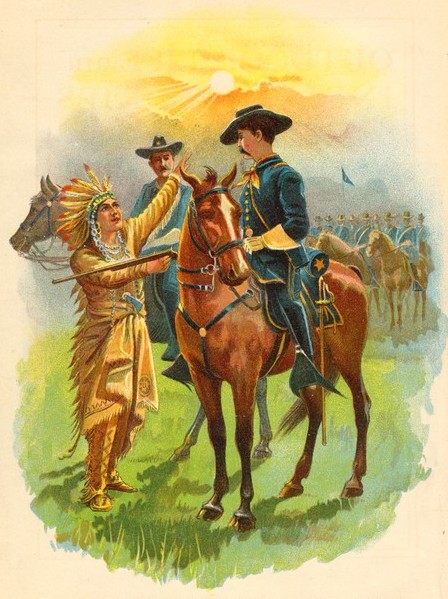
"FROM WHERE THE SUN NOW STANDS, I FIGHT NO MORE AGAINST THE WHITE MAN."
The Project Gutenberg EBook of Outdoor Life and Indian Stories, by Edward Sylvester Ellis This eBook is for the use of anyone anywhere in the United States and most other parts of the world at no cost and with almost no restrictions whatsoever. You may copy it, give it away or re-use it under the terms of the Project Gutenberg License included with this eBook or online at www.gutenberg.org. If you are not located in the United States, you'll have to check the laws of the country where you are located before using this ebook. Title: Outdoor Life and Indian Stories Author: Edward Sylvester Ellis Release Date: March 3, 2019 [EBook #59002] Language: English Character set encoding: ISO-8859-1 *** START OF THIS PROJECT GUTENBERG EBOOK OUTDOOR LIFE AND INDIAN STORIES *** Produced by Greg Weeks, Jana Palkova and the Online Distributed Proofreading Team at http://www.pgdp.net

"FROM WHERE THE SUN NOW STANDS, I FIGHT NO MORE AGAINST THE WHITE MAN."
MAKING OPEN AIR LIFE
ATTRACTIVE TO YOUNG AMERICANS
BY TELLING THEM ALL ABOUT WOODCRAFT, SIGNS AND
SIGNALING, THE STARS, FISHING, CAMPING, CAMP COOKING,
HOW TO TIE KNOTS AND HOW TO MAKE FIRE WITHOUT
MATCHES, AND MANY OTHER FASCINATING OPEN
AIR PURSUITS
——ALSO——
STORIES OF NOTED HUNTERS AND SCOUTS
GREAT INDIANS AND WARRIORS, INCLUDING DANIEL
BOONE, KIT CARSON, GENERAL CUSTER, PONTIAC,
TECUMSEH, KING PHILIP, BLACK HAWK, BRANDT, SITTING
BULL, AND A HOST OF OTHERS WHOSE NAMES
ARE FAMOUS
ALL OF THEM TRUE AND INTERESTING
BY EDWARD S. ELLIS
Author of the Celebrated "Ellis Books" of Adventure,
"The Deerfoot Series," "Youth's History of the United
States," Etc., Etc.
PROFUSELY ILLUSTRATED
WITH LITHOGRAPH COLOR PLATES, HALF-TONE
ENGRAVINGS AND LINE DRAWINGS
Copyright 1912 By L. T. MYERS
| Outdoor Life for Young Americans | 9 |
| How to Live in the Woods | |
| Making a Camp | 10 |
| How to Build a Lean-To | |
| How to Make Fire Without Matches | 11 |
| Using the Fire-Drill | |
| How to Get Pure Water | 13 |
| The Indian Filter | |
| How to Cook in Camp | 15 |
| Utensils and Simple Recipes | |
| How to Make a Bow and Arrow | 17 |
| A Safe and Powerful Weapon | |
| How to Read Signs and Signals | 19 |
| Indian Signs and the Wig-Wag System | |
| How to Tie Knots | 22 |
| All the Best Knots Explained and Illustrated | |
| How to Find Your Way by the Stars | 26 |
| The Heavens at Night | |
| What to Do in Case of Accident | 27 |
| First Aid to the Injured | |
| The Original Americans | 33 |
| The Indian Tribes | |
| The Original Emperors of Virginia | 40 |
| Powhatan and Opecancanough | |
| The Great Conspiracy | 54 |
| A Wily Chieftain and His Secret | |
| Adventures in New England | 61 |
| The Indians and the Pilgrims | |
| The Uncrowning of a King | 76 |
| Philip's Adventures and Death | |
| A Man of Mark Among the Delawares | 98 |
| Story of Tammany, White Eyes, and Captain Pipe | |
| The Greatest of Indian Conspirators | 106 |
| Pontiac, Chief of the Ottawas | |
| A Besieged Garrison | 121 |
| The Attack on Detroit | |
| A Good Indian | 129 |
| Little Carpenter, the Cherokee | |
| A Mighty Mingo Chieftain | 135 |
| Logan, the Orator and Warrior | |
| An Indian Demosthenes | 144 |
| Red Jacket, the Seneca | |
| Little Turtle | 149 |
| First an Enemy, then a Friend | |
| Warrior and Knight | 159 |
| Buckongahelas, the Delaware Chief | |
| A Famous Mohawk Chief | 169 |
| Adventure of Brandt, the Half-Breed | |
| A Chieftain on the Warpath | 176 |
| Adventures of Tecumseh, the Shawanoe | |
| Adventures of Weatherford | 192 |
| Chief of the Creek Confederacy | |
| Fighting Against Fate | 202 |
| Black Hawk and His War | |
| The Hero of the Everglades | 219 |
| Osceola and the Seminole War | |
| Sitting Bull, the Medicine Man | 233 |
| The Last Great Indian Uprising |
What boy can resist the call of the woods, the desire to know the forest and its furred and feathered inhabitants, the fish, the insects, the plants? But to gather this knowledge in safety the boy must first learn the ways of the woods, the life of the camper, how to cook and find his way by the stars, how to tie knots and what to do in case of accident, the language of signs and the secrets of the trail. There is no better way to do this than to study the methods of the Indians, the most expert woodsmen the world has known. At their call the forest produced food, drink, clothes, ornaments and all the necessities of life. Let us see how they managed this.
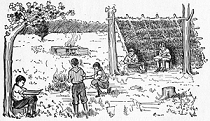
THE CAMP
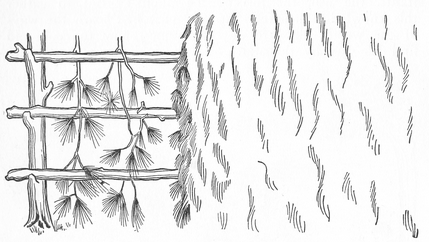
METHOD OF THATCHING A LEAN-TO
The first thing to be considered on going into the forest is the camp where the night is to be spent. In choosing a place for this see that there is fresh water, wood for the fire and brush-wood for building a "lean-to," or hut, at hand. It is well to build on a dry, level place, with just enough slope to the ground to insure the water running away in case of rain. The Indians used to live in huts thatched with brush-wood, and these are best made by building what is known as a "lean-to." Look for two trees standing from eight to ten feet apart on your camping place, with branches from six to eight feet above the ground. By placing a pole from one tree to the other in the crotches and leaning other poles against this one, brush-wood can be woven in to form a very good roof. Branches of the balsam or hemlock are best for this purpose, and the needles should point down. It is well to collect as many soft, thick tips of trees of this character as possible, both for the thatching and to make the beds.[11] Cover the floor of the "lean-to" with these tips thickly and lay the rubber blankets on top, rubber side down. Be sure to make the head of your bed toward the inside and away from the opening. You will find that this makes a very comfortable bed.
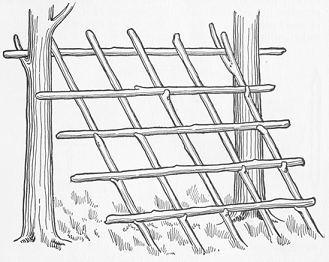
HOW TO BUILD A LEAN-TO
In olden times, before the Indians had matches, and even before they had the flint and steel that our grandfathers used for making fire, they used rubbing-sticks. Many people have tried to make fire in this manner, but few have succeeded.[12] As a matter of fact, it is not a very difficult thing to do if you know how, as the Indians did. In fact, they grew so expert that they could make fire almost as quickly as we can strike a match. The easiest and surest method of doing this is to use the bow-drill. The tools necessary consist of a bow, or bent stick, about two feet long, with a stout leather cord attached to each end. The drill consists of a straight piece of wood pointed at each end. One end of this rests in a drill-socket, which is simply a piece of wood with a small notch in it for the top of the fire-drill. This piece of wood is held in the hand, while the other end of the fire-drill is placed in the fire-board. This consists of a thin piece of wood with small pits cut about half an inch from the edge, and with a notch extending from the edge into the middle of the pit. The leather thong is given a single turn about the fire-drill and then by drawing the bow backward and forward the drill is caused to rotate very rapidly in the fire-board. After a short while the dust which comes out of the notch grows hot and becomes a glowing coal, which can be easily ignited into a blazing fire.
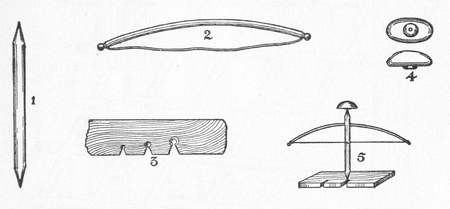
THE FIRE-DRILL
There are many ways of building a camp fire, but the[13] Indian's way is the best. The Indians always used to laugh at the white men because they said that they built such a big fire they could not get near it, while the Indian built a little fire and could get close to it. The fire must be built systematically. First, get dry, small dead branches, twigs, fir branches and other inflammable material and place these loosely on the ground, being sure that the air can draw under and upward through the mass. Next place some heavier sticks in the form of a pyramid with the tops of the sticks close together, and so on, until you have built the camp fire to the required size.

HOW TO BUILD A FIRE
Take every care to prevent the spreading of the fire, and do not build it too close to the tent or to inflammable pine trees. There is always danger of starting a disastrous forest fire by carelessness with a small camp fire. Remember that it is criminal to leave a burning fire, and always to put the fire out with water or earth. If the fire is to be used for cooking, it is well to confine the heat between two large logs, or, if baking is to be done on it, it is best to build an oven with large stones. But the Indians were usually content with open fire.
A very necessary item for the camp is pure water. If this cannot be obtained from a nearby spring which has good, clear water, or from a clean stream, it is possible to filter it in the same way that the Indians did. They had a way of purifying water from a pond or swamp by digging a hole about one foot across and down about six inches below the water level, a few feet from the pond. After it was filled with water they baled it out quickly, repeating the[14] baling process about three times. After the third baling the hole would fill with filtered water.
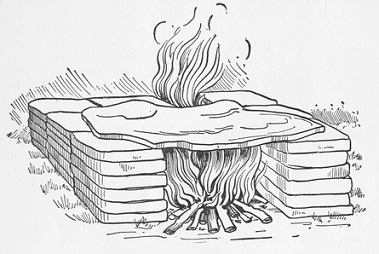
A STONE OVEN
If there is a stream at hand large enough to swim in, it is well to remember that if you work your hands and kick your feet you can stay above water for some time, even with your clothes on. Do not make the mistake of going into the water too soon after eating, for cramps are apt to result, causing a serious accident. The Indians have a method of protecting themselves from cramps. Coming to a bathing pool, the Indian swimmer, before entering the water, vigorously rubs the pit of his stomach with the dry palm of his hand. This rubbing probably takes a minute; then he dashes cold water all over his stomach, and continues the rubbing for another minute; and after that he is ready for his plunge.
The problems of the camp cook are not nearly so great as they seem at first glance. The essential thing is to select your cooking equipment and supplies wisely and learn a few simple recipes in advance. An excellent cooking kit for a long outing is composed of the following utensils: One 12-inch frying pan, one coffee pot, one 6-quart pail, one can opener, six air-tight canisters for coffee, tea, sugar, salt, etc., a knife, fork, teaspoon, tablespoon, plate, bowl and cup for each person in the party. All of these may be nested in a 12-quart pail, which will be found useful in many ways about the camp. If only a short hike is to be taken, however, a much smaller kit may be taken. An ideal kit for this purpose is used by the United States Army and may be obtained from outfitters or army stores anywhere. This consists of a frying pan and plate which can be locked together by the handle of the frying pan to form a baker. In this a knife, fork and spoon can be carried. With the addition of a canteen and large tin cup, this kit can be made to perform wonders in the cooking line on a trip of several days' duration. For a longer trip the larger kit is recommended.
The supplies to be taken along depend upon the tastes of the campers, the length of the trip and the convenience of transportation. Of course, if the trip is to be made by water it is easier to manage a greater weight than would be the case if it must be carried, a point to be kept in mind in selecting the supplies.
For a trip of about one week the following supplies are advised in quantities to suit the number of people in the party: Coffee, tea, sugar, salt, pepper, condensed milk (unsweetened), lard, bacon, flour, baking soda, bread and potatoes. This list can be enlarged to advantage by the addition of a ham, butter (if it can be kept cool), pickles, jam and additional vegetables, but it is well to keep the outfit down to the lowest point consistent with comfort. Eggs should be[16] taken if it is possible to carry them safely. They are now sold in packages which will stand moderately rough handling. Remember that a bed of hot coals is best for cooking, and use dry wood if possible to avoid the smoke. The following recipes will be found easy and practical. Others may be added as the cook grows more expert.
COFFEE
Use 1 tablespoonful of ground coffee for each cup to be made. For five people put 5 tablespoonfuls in pot, add ½ cup cold water and mix with the coffee. Add 4 cups of boiling water and bring to a boil, letting it boil one minute, then add ½ cup of cold water and set near fire where it will keep hot but not boil.
TEA
Use 2 teaspoonfuls of tea to 4 cups of boiling water. Put tea in pot and pour boiling water over it. Never boil tea, but stand in a warm place for five minutes to draw before serving.
BACON
Very useful on account of its fat which can be used to fry fish, potatoes, etc. Slice the bacon thin and put in frying pan. Fry over hot fire until crisp, turning the slices over with a fork from time to time.
POTATOES (BOILED)
Fill pail with water, wash and peel potatoes, boil until tender, take out of water and keep warm until served.
POTATOES (FRIED)
Put 1 teaspoonful of lard in hot frying pan or use fat left over from frying bacon. Peel and slice potatoes. Fry over hot fire.
FRIED FISH
Split the fish down the belly, clean, scale and cut off head and tail. Spread open and fry with lard or bacon fat in hot frying pan.
All of the above can be cooked easily and quickly in camp. It is recommended that bread be taken along, but if it is desired to cook this and other more complicated dishes, one of the many handy cook books on the market should be carried.

HOW TO MAKE A BOW AND ARROW
In early days the Indian did not have the modern hunting rifle, and was compelled to use bow and arrow in the chase. It is well for the modern boy to understand this weapon, for it can be made with ease and much good fun can be had with it. The Indian bow was short, because, though less efficient, it was easier to carry than a long one, yet it did not lack power. We hear that many times Indians shot so hard that their arrows appeared on the far side of the animal, but the long bow, such as was used by the old English archers or bowmen, was much the more powerful. To make the bow take a perfectly sound, straight, well-seasoned stick of about your own height and mark off a space as wide as your hand in the middle for a handle. This space should be left round and about an inch thick. The balance of the stick should be shaved down flat on one side for the front and rounded on the other for the back until it is about one inch wide and three-fourths of an inch thick near the handle, tapering to about half that at the ends, which are then notched for the cord. Next put on the cord[18] and bend it until it is about five inches from the bow at the center. If one end bends more than the other shave the other end until it becomes even.
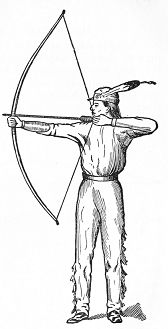
HOW TO SHOOT A BOW AND ARROW
After it is trimmed down to your strength finish it with sand-paper. The best woods to use are apple, black walnut, slippery elm, mountain ash or hickory.
More difficult to make than the bow is the arrow. The Indians made arrows of reeds and of straight shoots of arrow-wood or of elder, but we make better arrows out of hickory or ash. The arrow should be twenty-five inches long, round, and three-eighths of an inch thick. It should be notched at one end to take the bow-string, and just below this notch it should have three feathers set around at equal intervals. These feathers are best made from either turkey or goose wings. With a sharp knife cut a strip of the midrib on which is the vein of the feather; make three pieces, each two to three inches long. The Indians used to leave the midrib projecting at each end, and by these lash the feathers to the arrow without gluing, but it is easier to glue them and the arrows fly better. Indian arrow-heads were made[19] of sharp flints or pieces of stone lashed to the arrow-heads, but the best way to make them now is like the ferrule of an umbrella, as this keeps the shaft from splitting. After this the arrow should be painted, both to keep it from warping and to make it easier to find in the forest by its bright color.
After the bow and arrows are made one must learn to shoot with them. It is well to begin with the target close at hand, and gradually increase the distance as the archer becomes more expert. The Indians generally used their bows at short range so that it was easy to hit the mark, and considered rapid firing more important. In their competitions the prize was given to him who should have the most arrows in the air at once, and it has been said that their record was eight.
The Indians are very expert at using signs to give messages to one another. These signs are made in many ways and vary with the different tribes. Some of those best known are: Shaking a blanket, which means "I want to talk to you." Holding up a knife or other weapon means "war" or "I am ready to fight." Holding up a tree branch, "I want to make peace." Holding up a pole horizontally with both hands on it, "I have found something." Blazes or marks on trees are widely used to communicate messages. A simple blaze or small section of bark cut from a tree is often used to indicate a path through the forest, and if you are going through dense woods and must come back the same way or others are to follow you it is well to use this method of marking the way. Other well-known Indian signs are the water signs. A circle cut in the bark with an arrow-head pointing directly down and three waved lines within the circle means "Good water here." A similar circle with the arrow-head pointing to one side but below the center means "Good water not far in this direction." If the arrow-head is above the center it means "Good water[20] a long way off in this direction." An arrow alone indicates "Go in this direction." An arrow with a rectangular mark on the end means "A letter is concealed three steps in this direction." A cross means "Do not use this path." A circle with a small circle inside, "I have gone home." In addition to the permanent signs the Indians are very expert at "making smoke talk." A fire is built from damp wood which will give off a thick smoke. By holding a blanket over the fire the smoke is caused to rise in short and long puffs which can be made to spell out a message. At night the light of the fire can be made to serve the same purpose. As it is not always convenient to build a fire and the "smoke talk" is not easy to handle it is much better to use a flag and the wig-wag system. First of all it is necessary to memorize the signal code which is given below. The numbers are made by the signal man standing in one position with three motions. Let the signal man stand facing the signal station with which it is desired to communicate with the flag-staff carrying a small square flag held vertically in his hands. A white flag about two and a half feet square with a red square in the center is a good design, but the size depends somewhat on the distance between stations. At night a lantern on a pole or a torch can be used on the same system. To make the first motion ("one" or "1") move the flag as you stand facing the other station to the right and down to the level of your waist, returning it immediately to the vertical position. The second motion ("two" or "2") is the same to the left of the sender. The third motion ("three" or "3") is downward directly in front of the sender and immediately back to the vertical position. Remember that numbers which occur in a message must be spelled to avoid confusion. In sending a message make a slight pause between each letter and if a mistake is made signal 3 followed by 12, 12, 3, and then begin the incorrect word again.
THE WIG-WAG CODE
ALPHABET
| A | 22 | J | 1122 | S | 212 |
| B | 2112 | K | 2121 | T | 2 |
| C | 121 | L | 221 | U | 112 |
| D | 222 | M | 1221 | V | 1222 |
| E | 12 | N | 11 | W | 1121 |
| F | 2221 | O | 21 | X | 2122 |
| G | 2211 | P | 1212 | Y | 111 |
| H | 122 | Q | 1211 | Z | 2222 |
| I | 1 | R | 211 | tion | 1112 |
NUMERALS
| 1 | 1111 | 6 | 2211 |
| 2 | 2222 | 7 | 1222 |
| 3 | 1112 | 8 | 2111 |
| 4 | 2221 | 9 | 1221 |
| 5 | 1122 | 0 | 2112 |
CONVENTIONAL SIGNALS
| End of word | 3 | Repeat after (word), | |
| End of sentence | 33 | 121, 121, 3, | |
| End of message | 333 | 22, 3 (word) | |
| XX3 | beginning or end of | Repeat last word, | |
| numerals. | 121, 121, 33 | ||
| I understand | 22, 22, 3 | Repeat last message, | |
| Cease signalling, | 121, 121, 121, 333 | ||
| 22, 22, 22, 333 | Move to right | 211, 211, 3 | |
| Signal faster | 2212, 3 | Move to left | 221, 221, 3 |
ABBREVIATIONS
| a | after | n | not | ur | your |
| b | before | r | are | w | word |
| c | can | t | the | wi | with |
| h | have | u | you | y | yes |
Every boy is familiar with rope and its uses, but not every one is able to handle it to the best advantage. In camping and fishing, and particularly in any sport that has to do with the water, a knowledge of how to tie knots is of the greatest value and interest. Often one's very life depends on a knot holding.
A good knot has three qualities, it must be easy and quick to tie, it must hold fast when pulled tight and must be easy to untie. There are a number of knots which meet these requirements but are adapted to different uses. To learn the various knots which follow take a section of flexible rope about four feet long and three-eighths of an inch in diameter. To keep the ends from fraying it is necessary to "whip" or bind them with twine. To do this make a loop in the twine and lay on the rope end so that the closed end of the loop projects just over the end of the rope. Begin wrapping with the long end of the twine at a point about an inch from the end of the rope, over the loop and toward the end. When you reach the end of the rope pass the free end of the twine through the loop and pull the other end of the twine.

This will pull the free end under the wrapping and secure it. Cut off both ends close to the wrapping. To understand the directions remember that: 1. The Standing-part is the long unused portion of the rope upon which the work is done.

2. The Bight is the loop formed whenever the rope is turned back upon itself; and 3. The End is the part used in tying the knots.
The two primary knots are the "overhand" and the "figure-of-eight," which must be learned first of all as a basis.
THE OVERHAND KNOT
Beginning with the position shown in the preceding diagram back the end around the standing-part and up through the bight, drawing it tight.
THE FIGURE-OF-EIGHT KNOT

Make a bight as before. Then lead the end around back of the standing-part and down through the bight. The following knots are chiefly based upon these and can be easily learned by careful study of the diagrams. With practice considerable speed can be obtained, but it is best to "make haste slowly."
THE SQUARE OR REEF KNOT

This is the commonest knot for tying two ropes together. It will not slip or jam if properly tied and is easy to untie.
THE FALSE REEF KNOT OR GRANNY.

If the ends are not properly crossed in making the reef knot the granny results, a bad and insecure knot.
THE SHEET BEND OR WEAVER'S KNOT

A knot much used by sailors in bending (tying) the sheet to the clew of the sail and in tying two rope ends together. Make a bight with one rope A, B, then pass the end C, of other rope up through and around the entire bight and bend it under its own standing-part.
THE BOWLINE

One of the most useful of all knots. It forms a loop that will neither jam nor slip and is the only knot which will not cut itself under heavy tension. It is much used on shipboard and in rigging when a loop is desired. To tie the knot, form a small loop on the standing-part leaving the end long enough for the size of the loop required. Pass the end up through the bight around the standing-part and down through the bight again.[24] To tighten hold the loop in position and pull the standing-part. It is important that the knot should be held firmly in one position while tying for it is apt to slip before it is tightened. To join two sections together by this knot, tie a bowline in one end, then with the other end form the small loop, then pass the end through the loop of the first bowline and complete the knot. This method should always be used in joining kite cord to prevent cutting.
THE HALTER, SLIP OR RUNNING KNOT

First form a bight and then tie an overhand knot around the standing-part. An improvement in this knot for a halter knot is made by forming the overhand knot with a loop in the end which is pulled through. By pulling the end the knot is readily released.
THE SHEEPSHANK

This knot is used to shorten a rope. Take up the amount of rope to be shortened and make a half hitch around each bend as shown. If the knot is to be permanent the ends above each half hitch should be lashed.
THE CLOVE HITCH

A useful knot for quick tying and easy release. It is used in making fast the bow line of a boat in coming into a wharf, in lashing poles together, etc. Hold the standing-part in the left hand and pass the rope around the pole or stake; cross the standing-part, making a second turn around the pole, and pass the end under the last turn. In making a boat fast, form a bight with the end beneath, throw this over the top of the pile or mooring stake. Form another bight with the end on top, turn this over and throw over pile, pulling end together. This is a very secure knot which can be tied with the greatest rapidity.
THE FISHERMAN'S BEND

A useful knot for use on board a yacht. Take two turns around a spar or ring, then a half hitch around the standing-part and through the turns on the rings and another half hitch above it around the standing-part.
THE TIMBER HITCH

Much used in logging operations in hauling logs. Pass the end of the rope around the timber. Then lead it around its standing-part and bring it back to make several turns on its own part. The strain will make it hold securely.
THE DOUBLE HALF HITCH

A knot which is easy to tie and will not slip. A neat job may be had by lashing the end to the standing-part after the knot is drawn tight.
THE BECKET HITCH

Useful in fishing to bend a cord or line to a heavier cord or rope. The method is shown.
THE FISHERMAN'S KNOT

Used chiefly in tying gut. It is easy to tie and can be readily untied by pulling the two short ends. The ropes are laid alongside each other and with each end an overhand knot is made around the standing-part of the other. Pull the standing-parts to tighten.
CARRICK BEND

A knot which is used principally in joining hawsers for towing or heavy duty hoisting. Turn the end of one rope A over its standing-part B to form a loop. Pass the end of the other rope across the bight thus formed back of the standing-part B, over the end A, then under the bight at C, passing it over its own standing-part and under the bight again at D.
BLACKWALL HITCH

Used to secure a rope to a hook. The standing part when hauled tight holds the end firmly.
It is very important that those who frequent the forest should be sufficiently familiar with the stars to be able to tell their way by them. Often a compass is lost or damaged or there is not enough light to see the landmarks. At such a time a knowledge of how to find the Pole star is invaluable for, to the experienced woodsman, a glimpse of this star is equivalent to consulting a compass. It is really the most important of the stars we see, although not a very bright one, because it marks the North at all times and is fixed in its place, while all the other stars seem to swing around it once in each twenty-four hours, which makes it impracticable to use them for guidance. The Dipper or Great Bear is well known to all American boys on account of the size, peculiar shape and brilliancy of this group, and the fact that it never sets in this latitude. This group always points out the Pole star or Polaris, which is about in a line with the stars (Alpha and Beta) which form the outside of the Dipper at a distance about three and a half times as great as the space separating these two stars. This star always points out the North. If the imaginary line between Alpha[27] and Beta and Polaris is continued about the same distance beyond Polaris it will meet Cassiopeia, five stars in the shape of a W, which, like the Great Bear, is always seen in our latitude. With these directions it should be always easy to locate Polaris.
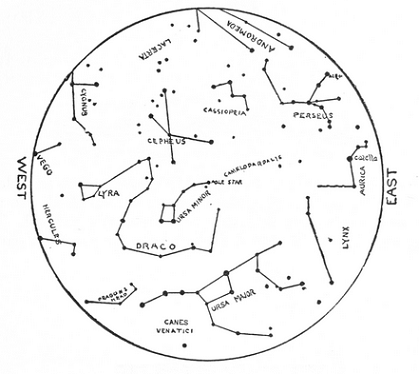
THE CIRCUMPOLAR CIRCLE
DROWNING
1. Loosen clothing, if any. 2. Empty lungs of water by laying body on its stomach and lifting it by the middle so that the head hangs down. Jerk the body a few times. 3. Pull tongue forward, using handkerchief, or pin with string, if necessary. 4. Imitate motion of respiration by alternately[28] compressing and expanding the lower ribs, about twenty times a minute. Alternately raising and lowering the arms from the sides up above the head will stimulate the action of the lungs. Let it be done gently but persistently. 5. Apply warmth and friction to extremities. 6. By holding tongue forward, closing the nostrils, and pressing the "Adam's apple" back (so as to close entrance to stomach), direct inflation may be tried. Take a deep breath and breathe it forcibly into the mouth of patient, compress the chest to expel the air, and repeat the operation. 7. Don't give up! People have been saved after hours of patient, vigorous effort. 8. When breathing begins, get patient into a warm bed, give warm drinks, or spirits in teaspoonfuls, fresh air, and quiet.
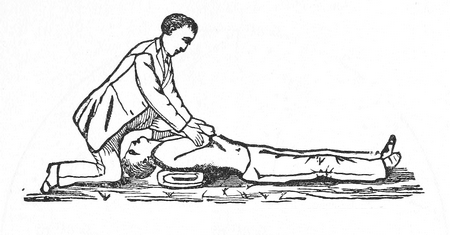
ARTIFICIAL RESPIRATION—FIRST MOVEMENT
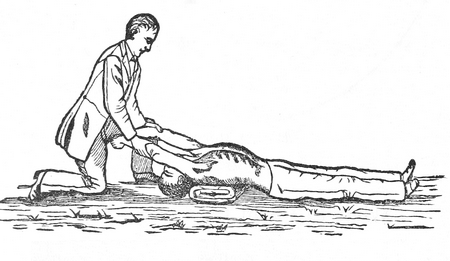
ARTIFICIAL RESPIRATION—SECOND MOVEMENT
BURNS AND SCALDS
Cover with cooking soda, and lay wet cloths over it. Whites of eggs and olive oil. Olive oil or linseed oil, plain or mixed with chalk or whiting. Sweet or olive oil and limewater.
LIGHTNING
Dash cold water over a person struck.
SUNSTROKE
Loosen clothing. Get patient into shade and apply ice-cold water to head. Keep head in elevated position.
MAD DOG OR SNAKE BITE
Tie cord tight above wound. Suck the wound and cauterize with caustic or white-hot iron at once, or cut out adjoining parts with a sharp knife. Give stimulants, as whiskey, brandy, etc.
STINGS OF VENOMOUS INSECTS, ETC.
Apply weak ammonia, oil, salt water, or iodine.
FAINTING
Place flat on back; allow fresh air, and sprinkle with water. Place head lower than rest of body.
TESTS OF DEATH
Hold mirror to mouth. If living, moisture will gather. Push pin into flesh. If dead the hole will remain, if alive it will close up. Place fingers in front of a strong light. If alive, they will appear red; if dead, black or dark. If a person is dead decomposition is almost sure to set in after 72 hours have elapsed. If it does not, then there is room for investigation by the physician. Do not permit burial of dead until certain indication of death is apparent.
CINDERS IN THE EYE
Roll soft paper up like a lamplighter, and wet the tip to remove, or use a medicine dropper to draw out. Rub the other eye.
FIRE IN ONE'S CLOTHING
Don't run—especially not downstairs or out-of-doors. Roll on carpet or wrap in woolen rug or blanket. Keep the head down, so as not to inhale flame.
FIRE FROM KEROSENE
Don't use water, it will spread the flames. Dirt, sand, or flour is the best extinguisher, or smother with woolen rug, table-cloth, or carpet.
SUFFOCATION FROM INHALING ILLUMINATING GAS
Get into the fresh air as soon as possible and lie down. Keep warm. Take ammonia—twenty drops to a tumbler of water, at frequent intervals; also, two to four drops tincture of nux vomica every hour or two for five or six hours.
ANTIDOTES FOR POISONS
First. Send for a physician.
Second. Induce vomiting, by tickling throat with feather or finger. Drink hot water or strong mustard and water. Swallow sweet oil or whites of eggs.
Acids are antidotes for alkalies, and vice versa.
RULES IN CASE OF FIRE
Crawl on the floor. The clearest air is the lowest in the room. Cover head with woolen wrap, wet if possible. Cut holes for the eyes. Don't get excited.
Familiarize yourself with the location of hall windows and natural escapes. Learn the location of exits to roofs of adjoining buildings. Learn the position of all stairways, particularly the top landing and scuttle to the roof. Should you hear cry of "fire," and columns of smoke fill the rooms, above all keep cool. Keep the doors of rooms shut. Open windows from the top. Wet a towel, stuff it in the mouth, breathe through it instead of nose, so as not to inhale smoke. Stand at[31] windows and get benefit of outside air. If room fills with smoke keep close to floor and crawl along by the wall to the window.
Do not jump unless the blaze behind is scorching you. Do not even then if the firemen with scaling ladders are coming up the building or are near. Never go to the roof, unless as a last resort and you know there is escape from it to adjoining buildings. In big buildings fire always goes to the top. Do not jump through flame within a building without first covering the head with a blanket or heavy clothing and gauging the distance. Don't get excited; try to recall the means of exit, and if any firemen are in sight, don't jump.
If the doors of each apartment, especially in the lower part of the house, were closed every night before the occupants retired there would not be such a rapid spread of flames.
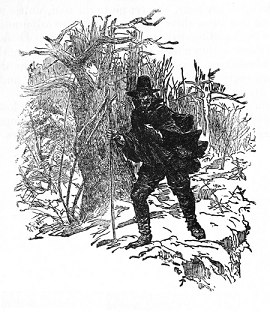
A SETTLER FLEEING FROM THE INDIANS
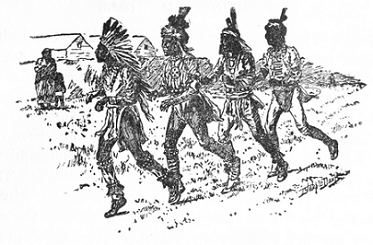
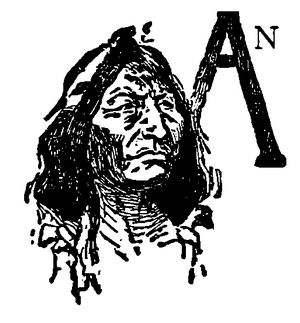
Indian always attracts attention. I have[33] no doubt that all the boys and girls who read these pages have seen one or more Indians. You do not have to go to the mountains and prairies of the West to meet these "original Americans," for they live among us; many of them attend schools of their own in different parts of the country, and some of them are engaged in business. For years past the football club of the Indian School at Carlisle, Pennsylvania, has ranked among the best, as more than one of our colleges have found to their cost. A full-blooded Indian was a member of General Grant's staff, and was present at the surrender of General Lee at Appomattox.
Where did these red people come from? Nobody knows any more than he knows where or when the first human being appeared on this earth. There have been a good many[34] guesses—for they are little more—to tell how the Indians came to be on this continent. Some have thought they are descendants of the Lost Tribes of Israel, who passed across Bering Strait from Asia, and, in the course of centuries, spread over and peopled both North and South America. Why their color changed to the well-known copper tint must have been due to the climate, though it is hard to understand why other persons should become yellow, brown or black. Then, too, a learned man once said there was no reason why the Indians might not have crossed Bering Strait from the other way, and peopled the Eastern Hemisphere. No doubt we shall have to wait a long time before learning all about the origin of man.
You hardly need be told how these red people got their name. Christopher Columbus, when he caught sight of land, after sailing so many weeks to the westward over the Atlantic, thought it was a part of the Indies. So, quite naturally, he called the natives Indians, and the name will never be changed.
You have heard of the Mound Builders, and many of you have seen some of the vast piles of earth which they heaped up hundreds of years ago. Ohio has ten thousand such mounds, and one near St. Louis covers eight acres. For a long while, it was believed that the Mound Builders were a race different from the Indians, who in the course of time gave place to them. This is a mistake. They belonged to the same race, and when Columbus discovered America, the Mound Builders were working like beavers in many parts of the country.
I am quite sure that you boys and girls, when reading or thinking about the Indians, have believed they were dying off, and the day would come when there would not be one of them left in America. No doubt you have felt sad over the[35] thought (I remember when I was a little fellow how I shed a tear, and sniffed and hoped a few of them wouldn't die till I had become a man and gained a chance of seeing them.) This mistake is one of the most curious of which I know. There are to-day as many Indians in this country as there were four hundred years ago. The last census of the tribes in Canada shows a slight increase. True, some tribes have been destroyed, but others have grown in number. There are more Iroquois or "Six Nation" Indians now than during the Revolution. When the end of all things comes, and the white men of this country are called to be judged, plenty of red men will be among them. They are in the United States to stay, and stay they will as long as the white man remains.
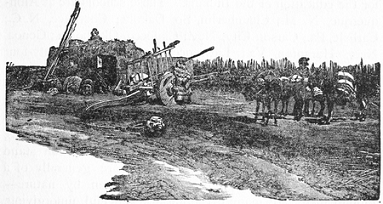
AN OLD INDIAN FARM-HOUSE
At the opening of the twentieth century, the Indian population of the United States was more than 270,000. This did not include Alaska, and is a clear increase during the preceding ten years. More than a third of the Indians wear civilized dress, and a half of this third know how to read.[36] Nearly a half of all the Indians are on "reservations" or at schools. The five civilized tribes, and their members in round numbers are: Cherokees, 30,000; Chickasaws, 7,000; Choctaws, 15,000; Creeks, 15,000; Seminoles, 2,500. They have fine schools, churches, banks, newspapers, factories and all the luxuries of modern life, with a system of government copied after our own.
More than a million dollars is spent every year by our government for the support of the various schools formed for the education of the Indians. These schools are at Albuquerque, N. M.; Chamberlin, So. Dakota; Cherokee, N. C.; Carlisle, Pa.; Carson City, Nev.; Chilocco, Oklahoma; Genoa, Neb.; Hampton, Va.; Lawrence, Kansas; and twenty-four other places.
You know that while the color of the Indians shows different shades, it is so similar that, leaving out the Eskimos, it is certain all of them had the same origin. The "pure-bloods" have coarse black hair, black eyes, high cheek bones, and not much muscular development, but they can stand a wonderful amount of fatigue. They are generally of a melancholy disposition, brooding and sullen by nature—though there are many exceptions—revengeful, unforgiving, treacherous, and yet they do not forget favors or kindnesses shown to them. The fact that from the day the first white man set foot on this continent he has abused the Indians, had much to do with the hatred shown by them toward these invaders from across the ocean.
Now, when you bear in mind that a good many tribes number only a few hundreds; that four hundred languages and two thousand dialects are used by the natives of North and South America, you will see how hard it is to classify them. Yet it is said the members of each tribe can be[37] recognized. A good many systems have been used in classifying the Indians, but the best is that which divides them as follows:
The Panis-Arapahoe family, including the Panis or Pawnees, the Arapahoes and the Jetans, called Comanches by the Spanish.
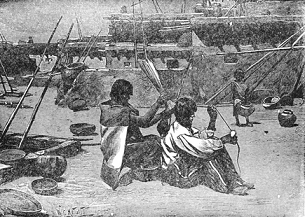
COURTSHIP AMONG THE INDIANS
The Columbian family, including the tribes in the North-west, of which the principal are the Snake or Flatheads, and the Shoshones.
The Sioux-Osage family, in which are found the powerful and numerous Sioux or Dakotas, the Assiniboines, who live in alliance with the Chippewas, the Mandans and the Osages.
The Mobile-Natchez, or Floridian family. This is[38] composed of six independent branches, each divided into several tribes, including the five civilized ones already referred to.
The Algonquin, Huron (Wyandot) and Iroquois family. The first two named are residents of Canada, while many of the Iroquois live in Central New York.
The Lenape family include the Shawanoes, Kickapoos, Sacs, Foxes, Illinois, Pottawatomies, Winnebagoes, Delawares or Lenni-Lenape, Mohicans, Chippewas, and several others. The Apaches forming the most terrible of all Indian tribes, belong to the Mexican family.
The Indians knew nothing of firearms until they saw them in the hands of the white men. Like the ancient barbarians of other countries, they made use of the primitive bow and arrow, spear, tomahawk, knife and club. Swine, sheep, cows and horses were unknown until brought across the ocean by white men. America, in turn, gave tobacco to the Old World. The warrior lolled in his wigwam or tepee, smoking his pipe, while his squaw scratched the earth and raised maize and a few vegetables. Now and then the head of the household wandered into the woods to hunt for game, or to fish in the streams. His delight, however, was in going on the "war-path," and in slaying those of his own race, who belonged to another tribe. Through the gloomy depths of the forest, where only his trained eye could trace the prints of the moccasin, he tracked his enemy, braving storm, heat, cold, fatigue, starvation, and every kind of hardship, for the chance of stealing upon the sleeper, or catching him off his guard. Burying his knife in his breast, or driving his deadly arrow into the heart of his enemy, he wrenched the scalp from his crown, and with a shout of triumph, hurried back to his own people, with the shocking proof of his bravery. The members of the tribe who thus lost one of their number did[39] not rest, so long as there was hope of revenge. Thus the fierce warfare went on, just as if these dusky people were civilized, or belonged to some of the "feudists" in certain parts of our country.
Among the many thousands of Indians there have appeared from time to time, numerous men of striking mental ability. They have had some of the most eloquent of orators, while others have shown marked military skill. Brought into contact with the white people, they have sometimes surpassed the Caucasian in real genius. In tracing the history and development of our country, we meet proofs of such skill and ability on the part of the Indians, and in the pages that follow we shall give attention to the most interesting instances, whose truth cannot be questioned.
THE ORIGINAL EMPERORS OF VIRGINIA
POWHATAN AND OPECANCANOUGH
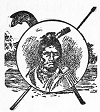
The first permanent settlement made in the original thirteen States was at Jamestown, Virginia, by the English in the spring of 1607. The settlers were at once brought in contact with two famous Indians, to whom we must now give attention.
The London Company, formed for the planting of colonies in the New World, sent three ships across the ocean in the month of December, 1606. They carried one hundred and five men, but no women, and were in charge of Captain Christopher Newport. They sailed up the Chesapeake Bay, and were charmed by the soft breezes, the fragrant wild flowers and the beautiful scenery. They halted at a peninsula (now an island), about fifty miles from the mouth of the James, so named in honor of their king, and began putting up cabins. Thus Jamestown was founded on the 13th of May, 1607.
At that time the country from the Allegheny to the ocean, and from the southern James to the Patuxent River, was inhabited by three families of Indians, each composed of a number of tribes. With two of them we have nothing to do.
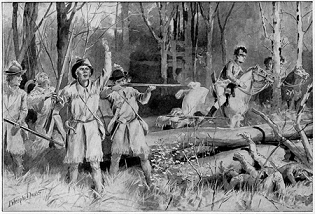
THE INDIANS DEFEATED AT FALLEN TIMBERS.
This was one of the most memorable battles ever fought
with the Indians.
It broke their power and gave supremacy to the whites.
August 20, 1794.
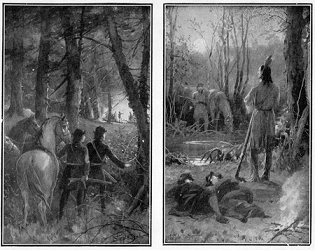
SURPRISING AN INDIAN CAMP.
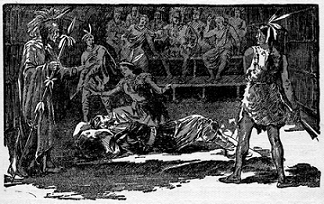
THE FAITHFUL INDIAN GUARD.
[41] The Powhatans lived in the lowland region, reaching from the Carolinas on the south to the Patuxent on the north, and between the sea to the falls of the rivers. They had more tribes than either of the other families, ten being between the Potomac and the Rappahannock; five between the Rappahannock and the York; eight between the York and James; and five between the James and the Carolinas.
The Powhatan League was one of the most powerful on the continent and occupied what is now Henrico county, on the shores of the James, and about two days' journey from Jamestown.
You will see that the head of this league or confederacy ruled over thousands of warriors, most of whom he had conquered and compelled to accept him as sovereign, whose will the bravest under-chief dared not dispute. In order to give him his proper importance, historians generally refer to him as "Emperor," a title which it would seem was proper. He is known as Powhatan, which is the same as his special tribe, or rather as his chief seat or capital. This old town had a dozen houses which stood a short distance below the present city of Richmond, on the banks of the river. Fronting it were three islets.
At the time of the settlement of Jamestown, Powhatan was about sixty years old. He was gaunt and tall, and as vigorous in body and mind as a man of half his years, and the gray hair, which was plentifully sprinkled through the black locks, gave a majesty to his looks. His head-dress was made of a mass of feathers, and his robe of state was of raccoon skins. The wooden bench or form upon which he was accustomed to sit, might be taken as a throne, and his reign over many tribes, most of whom he had conquered, gave a certain fitness to the name of emperor. It should be noted[42] that never did his son follow to the throne, but instead his brothers, then his sisters, and then the heirs of the oldest sister, all in turn were to inherit power.
Powhatan usually kept two-score of his bravest warriors as a body-guard about him, but when he learned of the coming of the pale faces to the mouth of the river, he made the number two hundred. He had favorite places where he passed the different seasons, a fashion that was often followed by the Indian chiefs in New England.
The settlement of Jamestown brings forward the name of the most remarkable pioneer connected with our early history, Captain John Smith, the "Father of Virginia." Could we believe one-half that this man told about himself, we should have to admit that he was one of the greatest heroes in history. He was a great boaster, and many of the things he told were simple invention. More than one of the most daring exploits that he claimed to have performed in the Old World have been proved impossible. None the less, Captain John Smith was brave, enterprising, unselfish, tactful, industrious and far-seeing, and but for him Jamestown would have perished from the earth within a few months after building the first cabins. Enough of him is known to prove that he was not only the founder, but the saviour of Jamestown.
Smith was a native of Lincolnshire, England, and when he reached Virginia, was not thirty years old. He had a powerful physique, and did not hide his disgust with the "gentlemen" of the colony, who thought themselves too good to work. He gave them the choice of working or starving, and he set the good example of toiling as hard as any of them. The settlers with whom he came did not reach Virginia until the planting season was over, and, before long, all were suffering for food. The only thing left to do was to get it from the[43] Indians, and Smith set out to do so. But the red men knew of the needs of the pale faces, and despised them therefor Smith tried to get them to sell, but they refused, or at the most would give but a handful of corn for a gun or a sword. Seeing no other means left, Smith and his men opened fire on the churlish fellows, drove them into the woods, and marching into their village, carried a good supply of corn back to Jamestown.
For many years after the discovery of America, it was thought that it was only a narrow strip of land, and that a short journey to the westward would take one to the South Sea on the other side. As late as 1609, when Henry Hudson sailed up the stream named for him, it was in the belief that he had not far to go to reach that vast body of water. Captain Smith was ordered to explore the streams in the neighborhood of Jamestown. In obedience to this command, he set out to learn the sources of the Chickahominy. He went up that stream until the waters became too shallow to allow the barge to go farther, when he stepped with two of his men and two friendly Indians into a canoe and paddled away. He told those left in the boat to stay in the middle of the stream, and forbade them to approach either bank until he came back. But he had not been gone long, when those that remained became tired of sitting motionless in the barge, knowing that their leader could not join them for many hours, and mayhap not for two or three days. Peering into the woods and listening, they saw and heard nothing to cause fear. So after talking for a little time, they paddled to shore and stepped out on land. They had hardly done so, when they were attacked by Indians and one killed, the others escaping with great difficulty. The news they took back to Jamestown[44] made every one believe they would never again see Smith or his companions.
Meanwhile, the pioneer was pushing his way into the wilderness, with no thought of what had befallen the men left behind in the barge. The light canoe was just buoyant enough to float himself and friends, and they paddled up the narrowing stream with all possible care. The day was wearing away, and, since they had no food, Smith decided to hunt for wild fowl. Landing, he went forward alone, never dreaming that Opecancanough with a large body of warriors was tracking him through the woods. This chief came upon the two Englishmen while they were asleep and killed both. Then they hurried after Smith, who they knew could not be far away.
When the pioneer caught sight of the dusky figures flitting among the trees, firing their arrows and pressing towards him, he tried to retreat to his canoe, but soon saw that he would be cut off. He seized one of his Indian companions and swung him round in front, as a shield. The pursuers did not wish to harm a member of their own race, and Smith found for a time that the novel armor served him well. As fast as he could load his gun he fired into the swarm of warriors, who were so close together that he did not miss. He wounded a number and said he killed three, which may be true.
The doughty pioneer could give no attention to his feet, since he dared not take his eyes off his pursuers. He was slowly falling back, and hopeful of getting away, when he stepped into a marshy place into which he immediately sank above his knees. Even when in this plight, the Indians were afraid to lay hands on him. They would steal forward and then scramble in a panic for the shelter of the tree trunks, afraid he was about to fire his terrible gun at them.
Smith struggled hard to free himself from the mire, but with every effort only sank deeper. The weather was cold, and, seeing that he must perish if he staid where he was, he set free his human shield and flung away his weapons. He expected to be killed at once, but the captors drew him out of the mud and led him back to the place where the two Englishmen had been slain, and where a fire was kindled. The warmth of this brought back his vigor and hopefulness, and seeing no disposition to do him immediate harm, he asked for their chief. The famous Opecancanough came forward. The captive handed him a small compass. The chief took it in his hand while his warriors gathered around and all studied the odd-looking instrument with deep interest. The darting about of the tiny needle filled them with wonder, and for the moment no one thought of doing the white man any harm.
Smith says that through the compass he made clear to the Indians the roundness of the globe, the spheres of the sun, moon and stars, the revolution of the earth on its axis, the immensity of the land and sea, the diversity of the nations, the antipodes, "and many other such like matters, so that all stood amazed with admiration!" And yet how are we to believe that, unable as he was to speak the Indian language, Smith "explained" these strange things to the Indians, or that they could have gained any idea of his meaning! Such a feat was surely beyond his power.
The compass, however, was to serve a good purpose, for when the warriors had tied Smith to a tree and were about to fire their arrows at him, Opecancanough held up the curious instrument and they stopped. The captive was taken to the home of Powhatan, on York River, and well treated. Indeed, he was fed so much that he began to suspect they were fattening him in order that he might make a fine meal for them.
The capture of the leader of the colony sharpened the appetites of the Indians for greater deeds, and they got ready to destroy Jamestown. They tried by every means they could think of to get Smith to help them, promising him much land and the finest of their women as wives. Nothing could lead Smith to turn against his own countrymen, and he tried to show his captors that their plan was hopeless. Smith then did a slight thing of itself, which filled the Indians with wonder. Taking a blank leaf from his pocket book, he wrote upon it a brief account of the plot, and asked his friends to send him a number of articles which he named, and which he promised the Indians they could get by taking the slip of paper to Jamestown. The messengers made the journey in the face of severe weather, and brought back the things which Smith had promised. How he managed thus to talk with his friends many miles away, was a mystery which the native mind could not grasp.
Since the red men had to give up their plan of capturing Jamestown, they tried to impress him with their own greatness. He was taken from place to place, among the different tribes, and finally brought back to Opecancanough. He was feasted again, the Indians looking upon him as a sort of god. He was next led into the presence of the mighty Powhatan, where, after a time, it was decided to put him to death.
This brings us to the incident which is the most famous in the history of Captain John Smith. He says his head was laid upon two large stones and the warriors were about to beat out his brains, when Pocahontas, the favorite daughter of Powhatan, and not more than ten or twelve years old, threw her arms around the prisoner's neck, and prayed her father to spare him. He could not refuse the pleadings of his loved child.
Whether such an incident ever took place will never be known. While it is not impossible, many doubt its truth. It seems to have been an afterthought of the grim boaster, for years passed without anyone hearing a reference of it, and it was not until the death of Pocahontas that Captain Smith told how he had passed through such a strange experience.

POCAHONTAS SAVING THE LIFE OF JOHN SMITH
Powhatan seemed to think that since he had spared the life of the Englishman, the latter should be turned to account. He made him help in forming bows and arrows, moccasins, robes and copper trinkets. A son of the chieftain became friendly to Smith, and did him many kindnesses during his captivity. The Englishman rapidly learned the tongue of his captors, and this knowledge afterwards proved of great help to him. Finally he was sent back to Jamestown. The guard who went with him were treated with great kindness, and a number of presents were sent through them to[48] Powhatan. This seems to have won the friendship of the old chief, who sent his daughter Pocahontas every few days to the settlement with food, where it was sorely needed. Everything would have gone well but for the foolish course of Captain Newport, who soon after arrived from a voyage to England. He gave Powhatan so many presents, that the emperor was puffed up with his own importance, and refused to part with any of his goods without being paid five or six times their value. When Newport had offered about all he had to offer, Powhatan sneeringly gave only two or three bushels of corn in return. Then it was that Smith proved himself as shrewd as the chieftain. He managed, as if by accident, to let Powhatan see a number of shining beads of blue glass. The chief's eye was caught, and he asked for them. Smith said they were of great value, and only worn by great kings. This fired the envy of the chief, who was determined to own them, for who had a better right than he to wear the jewels of a mighty monarch? With much seeming unwillingness, Smith parted with the beads for more than two hundred bushels of corn.
Powhatan began to fear that the continual coming of new emigrants meant danger to himself and people. He began plotting to massacre the settlers, but the prompt vigor of Smith scared him, and he sent Pocahontas to Jamestown with a message that the evil plot was due to some of his fiery chiefs. Smith, who had taken several prisoners, thereupon released them, and all remained tranquil for a time.
Captain Newport's silly course with Powhatan came to a head in the autumn of 1608, when he arrived again from England, just after Smith had been elected governor of the colony. Newport brought a gilded crown for Powhatan, and had the whole programme arranged for his coronation. At the same time settlers were to offer to aid Powhatan against a tribe with which he was at war. When this message was sent to him, the haughty old leader told the English that since he was a king he would not go to Jamestown, and as for the offered help, he did not wish it, as he knew how to manage his own affairs.
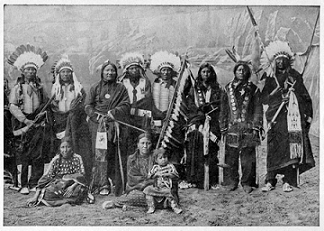
A GROUP OF INDIAN CHIEFS AND THEIR WIVES VISITING THE PRESIDENT AT WASHINGTON.
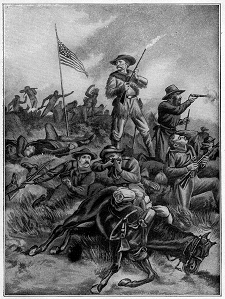
GENERAL CUSTER'S LAST CHARGE.
The Battle of the Little Big Horn Run, fought in 1876, by General Custer, in command of United States troops against the Sioux Indians, resulted in the entire destruction of the troops and their brave commander. It was the last great battle with the Indians in America.[49]
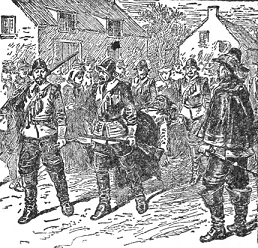
OPECANCANOUGH IN CAPTIVITY
Among the emigrants who came over with Newport were three Germans, who believed because of the woful state of the colony that it could not last much longer. They gave their views to Powhatan, and were base enough to offer to help him in putting all the English to death. The old chief fell in with the plan, and agreed that the first step necessary was to "remove" Captain Smith. Powhatan tried many tricks to get him in his power, but that wise man outwitted him every time. The chief warned his warriors that if they failed to kill Smith he would have them slain. About this time a strange accident brought safety to the sturdy governor. One of Powhatan's men had by some means got hold of a quantity of gunpowder, which he told his friends he could handle as well as the whites themselves. Several gathered round to watch him, when the stuff suddenly blew up and killed the Indian and two of his companions. Powhatan and the others were terrified, and filled with a desire for peace. They brought back many stolen articles, and, in 1609, sent half their crop of corn to the settlers. About this time, Captain Smith was so[50] shockingly burned by the burning of his powder bags, that he went to England for surgical aid and never returned to Virginia. It should be added that of the three wicked Germans, one died miserably, and the others were slain by order of Powhatan, because of their deception.
The colonists told the chief that Smith was dead, but he would not believe it, and some time later sent one of his chiefs, Tomocomo, to England, to learn what had become of him. Tomocomo was also ordered to find out all he could about the country, and to learn how many white people were there. The faithful servant began his duty by carrying a long stick into which he cut a notch every time he met a stranger. Needless to say that this means of taking the census proved a failure. When he came back to Virginia and Powhatan asked as to the population on the other side of the deep water, Tomocomo made his famous answer: "Count the stars in the sky, the leaves on the trees, and the sand upon the seashore, for such is the number of people in England."
Powhatan had many broils with the English, but it is only just to say the fault lay more often with the latter than with him. The most shameful of all outrages was that of Captain Argall, who while cruising up the James, invited Pocahontas to visit his ship under the escort of a squaw that had been bribed to betray her. Argall made Pocahontas a prisoner, and took her to Jamestown. He believed Powhatan would hasten to ransom her for a large amount of corn which the settlement needed, but the enraged parent hastily prepared to go to war. During these evil days, John Rolfe and the dusky maiden fell in love with each other, and were married in the quaint old chapel at Jamestown in the month of April, 1613. This pleasing event made Powhatan the friend of the white man and as such he died five years later.[51]
We recall that Pocahontas and her husband visited England in 1616. She received much attention from the court and the leading people of the kingdom, but when about to sail for her native land fell ill and died. She left an infant son Thomas, who was educated in London by his uncle Henry Rolfe.
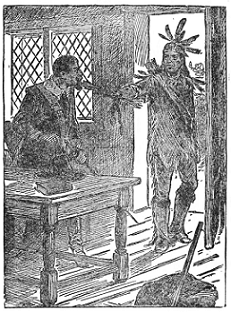
AN INDIAN EMPEROR'S DECLARATION OF WAR
He settled in Virginia after reaching manhood, became wealthy, and was one of the foremost members of the colony. His only daughter married Colonel Robert Bolling; their son, Major John Bolling, was the father of a number of children. One of the daughters married Colonel Richard Randolph, who was the ancestor of the famous John Randolph of Roanoke,—a fact of which he was always very proud. Thus the blood of Pocahontas flows to-day in some of the leading families of the Old Dominion.
Now, no one would think the life of Captain John Smith complete without the story of Pocahontas. Its romance lends[52] it a pleasing interest, despite the doubt that must always linger as to its truth. But have you ever heard that his life was saved by another Indian maiden, and that a different section of the country produced its Pocahontas to serve her merciful purpose? The story is a sad one, because the beautiful and heroic girl was killed as you shall hear.
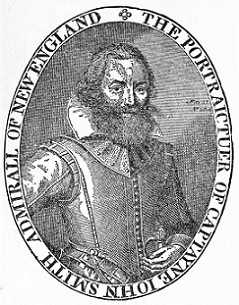
AN OLD PRINT OF CAPTAIN SMITH
In the month of March, 1905, Robert H. Gardiner, of Bangor, Maine, in rummaging through some old papers bearing upon the early history of Kennebec River, found proof that in the summer of 1614 Smith sailed up the river to the chief village of the Cabassas tribe of Indians, which stood on the present site of Gardiner. The daughter of the chief, Saboois by name, so liked the manner and looks of Smith, that she formed a strong attachment for him. He was so interested with important matters, however, that he gave no encouragement to her. The visit to the chief was very friendly, but when Smith was about to leave, one of his lieutenants, named Hunt, headed a mutiny, and, with several others, set out on a[53] new expedition, taking several of the Cabassas tribe with him as captives. Not knowing of the division of the party, the chief called his warriors together, and started in pursuit of Smith, with the resolve to destroy the white men for the outrage of which he believed all were equally guilty.
Knowing the danger of Captain Smith and his friends, Saboois ran ahead and warned them. She overtook the party just as they had encamped for the night a few miles down the river. The chief and his warriors were close behind, and, at the moment the Cabassas maiden flung her arms around Captain Smith, a shower of arrows poured into the camp. One of these pierced the girl's breast, while shielding the captain, who was thereby saved at the cost of the life of his devoted friend.
The horrified chief stopped hostilities. This gave Smith the chance to explain that it was the mutineers who had kidnapped his people. The Indians carried the body of Saboois back to their village, and sorrowfully laid it away near what is now Randolph churchyard, and then started in pursuit of Hunt and his party. They were overtaken and all slain near Norridgewock, after which the rescued captives returned home with their countrymen.
THE GREAT CONSPIRACY
A WILY CHIEFTAIN AND HIS SECRET
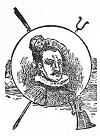
The great emperor Opecancanough, of whom we have already told you, hated the whites even more than his brother Powhatan. He was a warrior of rare skill, much the superior in all respects to Opitchapan, the successor of Powhatan. Before the death of the latter, Opecancanough secured the title of king over the free tribe of the Chickahominy.
This chief was never a friend of the whites. He had several quarrels with them, and had not been king long when he began plotting to destroy the settlements. One cannot help admiring the cunning and skill displayed by this arch enemy of the English. He formed his plans with such secrecy that not a hint of them reached the settlers before the hour of the outbreak. Two days before the date of the massacre, a party of Indians guided several Englishmen through the woods, and sent one of their youths to live among the white men, that he might learn their language. A messenger who visited the chief was treated with the utmost kindness, and told that peace with the white man should last as long as the[55] stars held their places in the sky. The settlers lent their boats to the Indians who paddled to and fro as they chose. More than one pioneer who had been fixed upon as a victim, sat with the dusky assassins at his table on the morning of the massacre.
The awful blow fell on March 22, 1622, with the suddenness of a lightning bolt from the blue sky. The warriors seemed to spring from the ground. Neither sex, nor old age, nor prattling infant was spared. The toilers in the fields were shot down, women and children tomahawked, and in the space of one hour, three hundred and forty-seven victims lay stretched in death. Among these were six members of the council and many of the leading people. The number of plantations was reduced from eighty to six.
The massacre raged up and down the James, and all the settlements would have been destroyed, but for the warning of a Christian Indian, Chanco, who was able to make known the peril in time for some of the people to save themselves. White men can become as savage as Indians when their rage is aroused. The summer months were spent in strengthening the fortifications and in preparing for a campaign against the Indians. Every man and boy able to handle a gun was drilled in its use. So deadly was the general temper that time was not taken for the planting of more than half a crop. When everything was ready, the settlers took the field, and began hunting down the savages as if they were so many rabid dogs. No mercy was shown to any one. They were followed far into the gloomy forests and shot wherever sight was gained of them. Finally, the whites seemed to grow weary, and sent word to the Indians that they were now ready to forgive and make peace with them. Under this pledge the warriors came forward, but the moment they were within the power of the settlers, the latter assailed them[56] without mercy. This treachery was without excuse. For a long time it was believed that Opecancanough was among the slain, but such was not the fact, as the settlers were doomed to learn to their cost.
Now comes one of the most awful scenes in all the great story of American history. The seasons came and went and all was serene and peaceful, so far as the keenest scouts among the settlers could learn. Men passed to and fro in the native villages, trusting themselves for days with the savages, who could have wrought their will with them; they were received by the grim Opecancanough himself, who told of his sorrow that his chiefs and warriors had ever forgotten their friendship for the pale faces, and he assured them that no such wrong could ever occur again; the Indians visited Jamestown and the different settlements, just as they had done years before, without the slightest distrust on the part of their hosts.
Opecancanough was past three-score and ten when the massacre of 1622 took place. His athletic figure yielded slowly to the passing years, the black strands that dangled about his shoulders were whitened by the snows of many winters, and the coppery countenance became seamed with wrinkles. He stepped across the four-score mark, and finally ten more years were added to his great age, with slight weakening of his vigor and strength.
And all through the circling years, this wonderful chieftain was completing his plans for another massacre of the people that had come across the ocean to steal away the hunting grounds of the red men. Deep in the gloomy depths of the wilderness, he and his chiefs met, where no white man ever saw them, and whispered their plans to one another. Every dusky breast was thrilled by the hope that has nerved myriads of Indians from the hour that the white men began building their cabins on American soil; it was that of destroying root and branch these invaders of their homes.
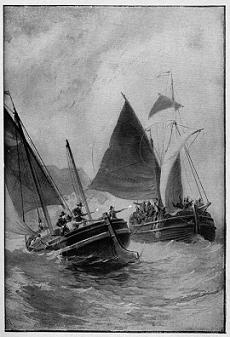
INDIANS MAKE POOR SAILORS.
During the Pequod war a boat was captured by the Indians. They tried to sail it and defend it with
guns, but as seamen they were failures. The boat was re-captured by the brave
colonists and the Indian's slain.
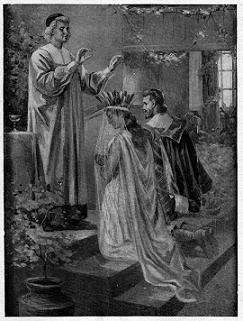
MARRIAGE OF AN INDIAN PRINCESS.
Pocahontas, the daughter of Powhattan, who saved
Captain Smith's life, had a very romantic career.
She afterward married John Rolfe and went to
England to live. She never returned to America.
The chiefs and warriors did not need to be told by Opecancanough that they were staking everything on this single attempt. They had failed by the narrowest chance in 1622, and could not afford to fail again. The secret must be kept, and the wonder of it is that it was kept for twenty-two years. Not a whisper reached the ears of the settlers, nor did any one seem to feel the first throb of misgiving. Through the spring blossoming of flowers, the sultry fervor of summer, the whirling snow and ice of winter, the plotters continued to gather in the twilight depths of the woods, guarded by vigilant sentinels, whom the most cunning scout could not pass, and they talked and smoked their pipes and shook their heads and brought their dreadful plot to perfection. Warriors and chiefs died, and, as we know, the great leader of them all steadily approached the age of a century, but still the blow was withheld, for all was not ready. Incredible as it may seem, Opecancanough was nearly a hundred years old when he gave the order to attack the settlements. By this time, his iron frame had become so feeble that he could not walk. His warriors carried him on a litter, that he might lead in the assault that should not leave a white man or woman on the soil of Virginia.
One cause for fixing upon April 18, 1644, for the attack was the state of affairs at Jamestown. The chief kept himself informed, and he knew of the bitter quarrels that were raging there. Revolts had broken out, and the condition of the people invited the long postponed assault. Opecancanough sent his swiftest runners to the distant tribes of the confederacy which he had built up during the many years that had flown since the first massacre. [58]
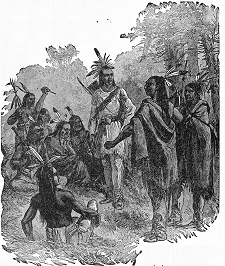
AN INDIAN COUNCIL OF WAR
He meant to lead in person the five nearest tribes, while the more remote ones were placed under the command of their different chiefs. Thus, by a simple plan, the hundreds of savages from the mouth of the Chesapeake to the sources of the principal rivers which flow into it, were joined into a compact force, easily handled without confusion. This fearful horde was to be hurled against[59] the settlements at the same hour, and there could be no turning back after the first tomahawk had fallen.
There was no warning as before. The thunderbolts struck the whole line of settlements at the same hour and almost at the same moment.
Owing to the turmoil of those times, we have no reliable account of the great massacre in Virginia in 1644, but five hundred people fell victims to the ferocity of the Indians, who raged up and down the James for two days. Many were carried into captivity, while cabins, crops, farming implements, and all manner of property were destroyed. The fleetest of foot escaped in some instances, and made haste to Jamestown, which flew to arms. All who were able to handle a weapon were called, and every twentieth man was placed under the immediate command of Governor Berkeley, who hurried his preparations for marching into the Indian country, every soldier as resolute as he to destroy those who were making such awful havoc among the plantations.
Berkeley, afterwards known as the tyrannical Governor of Virginia, was a young man at that time, and a good military officer. When he led his body of picked horsemen against the Indians, he resolved to keep up the warfare until he captured the leader himself. He pushed the pursuit with all vigor and finally ran Opecancanough down, and made him prisoner. Like the Roman conquerors, he brought him as a token of his triumph to his capital, but it is to be said to the credit of Berkeley that he treated his royal captive with the respect due to his fame and prowess. He placed him in proper quarters, and set a guard about the building to keep back those who might wish to gaze upon the distinguished prisoner.
The condition of Opecancanough at this time was pitiful.[60] He was barely able to raise an arm or a foot, and became so feeble that when he wished to make use of his eyes, some one had to lift the lids for him. Still he kept to a striking degree his kingly dignity. Hearing confusion one day about his prison, he had his eyes opened for him, and noticed a number of persons peering into the room. He sent for Governor Berkeley and said, reproachfully, "Had it been my fortune to make you prisoner, I would not have exposed you as a show to my people."
The Governor gave strict orders to save the captive from all annoyance. Struck by the vitality of the chief, he thought of sending him to England, not only as proof of the prowess of the ruler of Virginia, but as evidence of the good qualities of the climate, which many visitors had said was bad.
This plan, however, was defeated by the cruelty of one of the guards. Thinking upon the ruin and death that had been wrought by Opecancanough, he raised his musket one day and sent a bullet through the body of the prisoner. Thus died the most remarkable Indian connected with the early history of Virginia. His influence over his countrymen was greater than Powhatan's had ever been. His complaint was that the whites were fast taking all the hunting lands from the Indians, and that the overthrow and ruin of the latter could be prevented only by the massacre of the invaders. In this attempt, like many leaders of his race, he failed, and comparative peace followed his death for many years.
ADVENTURES IN NEW ENGLAND
THE INDIANS AND THE PILGRIMS
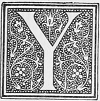
OU have all heard of the hardy Pilgrim Fathers. The Pilgrims landed at Plymouth, Massachusetts, in 1620. Several wooden huts were built, ground marked off, and the company divided into nineteen families. Thus was made the first permanent settlement in New England, several former attempts having ended in failure. Those early pioneers, who were a sturdy, God-fearing people, had a rough time of it from the beginning, and before spring came, one half of them had died, Governor Carver passing away in April.
A great surprise came to the little band of settlers one day in March, when an Indian walked out of the woods and came toward them. Although the weather was cold, his only clothing was a band of leather about the waist to which a fringe hung. He strode boldly forward, and, when he saw the looks of astonishment, called out:
"Welcome, Englishmen! Welcome, Englishmen!"
The first thought that came to the settlers was wonder as to how this native had learned their language. His name was Samoset, and he had picked up a few words from the English fishermen on the coast of Maine. Because of the chilly air, one of the men brought out a horseman's coat and flung it over the shoulders of their visitor. He wished to talk and[62] to tell the white men all that could interest them. By means of the few English words he knew, and by signs he succeeded quite well. He felt at home, and ate and drank all that was set before him. He said that he lived at a place called Pawtuxet, but a few years before all the men and women had died of a dreadful plague. It was afterwards found that Samoset told the truth.
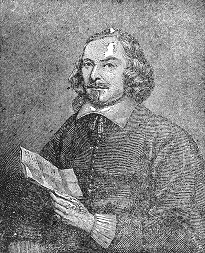
GOVERNOR WINSLOW
SOLDIER AND STATESMAN
The dusky caller was more eager to stay with the Englishmen than they were willing to have him as a guest. They bade him good-bye as night drew on, but he chose to remain with them, leaving Plymouth the next day to go to Massasoit, of whom he had spoken several times. He said Massasoit was a great sachem, who would come in a few days to barter beaver skins with the white settlers and to pay his respects to them.
On the following Sunday, Samoset was on hand again. He brought with him five warriors as tall and pleasing in their looks as himself. He had been told that he and his companions must not come into the settlement with their weapons. Accordingly, they left their bows and arrows some[63] distance from town. They were treated well, but the settlers would not trade with them because it was Sunday. When the five left, Samoset claimed he was ill, and stayed at Plymouth for three days. In fact, he had formed a stronger liking for the colonists than they had for him. The visitors had promised to come again to barter, and they kept their promise. The most important news, however, brought by them was that Massasoit, their great sagamore or chief, was only a short distance off, awaiting the chance for an introduction to the white men. An hour later the chief with sixty of his followers appeared on the crest of a hill not far away.
The settlers distrusted the meaning of the visit of so large a body. It might be they meant to massacre the whites, and were using their usual trickery to gain an advantage over them. Among the colonists was an Indian named Squanto, who had been kidnapped several years before, and kept for some time in England, where he learned to speak the language. He was now sent to Massasoit to ask the wishes of the sagamore. The reply was a request for one of the Englishmen to come out and have a talk with him. Edward Winslow did so, and gave a number of trinkets to the great chieftain, who showed childish delight over the presents. Through Squanto, Winslow told Massasoit that the King of England sent him words of peace and love, and that the Governor of Plymouth wished to make a treaty of friendship with him.
When the speechmaking was over, Massasoit left Winslow with the warriors as a hostage, while he and twenty of his men, leaving their weapons behind, walked forward for a talk with the governor. They were conducted to a house not then finished, where Governor Carver welcomed them and ordered refreshments, of which all partook. "Strong water" was a part of the dinner. It was new to the Indians, but[64] they were pleased with the fiery stuff, of which they drank enough for its effects to show. The natives became quite merry, and it is to be feared that the Puritans reached a mellow mood. Be that as it may, no more favorable time could have been chosen for agreeing upon a treaty, and the important fact is that Massasoit made one treaty with the English which was kept sacred for more than fifty years.
It will help to understand the early history of New England, if we remember that the Indians of that section consisted at that time of five confederacies, or leagues, of different numbers and strength. The Pawtuckets lived mainly in southern New Hampshire; the Massachusetts around the bay of that name; the Pequots in eastern Connecticut; the Narragansetts to the east of the Pequots, Rhode Island and the other small islands in the neighborhood being within their territory, while the Pokanokets, more generally known as Wampanoags, embraced portions of Plymouth and Barnstable, and a good deal of the country between the Pawtucket tribes and the Massachusetts, with a part of present Bristol county, Rhode Island. The Wampanoags numbered nine tribes, each governed by its own sagamore, and all subject to Massasoit, the grand sachem, who generally lived near Mount Hope.
Governor Carver died a few weeks after the signing of the treaty named, and was succeeded by William Bradford, who held the office for many years. To him, more than to any one person, is due the success of the first colonies planted in New England. The most striking tribute to the greatness of Massasoit lies in the fact that while it was a rule among his race that the foremost warriors attained their fame through personal courage and deeds, yet he was a man of peace. But he held the numerous tribes together without war, and ruled over a larger dominion and a more numerous people than Powhatan, Opecancanough, Pontiac or Tecumseh. True, the last two held full sway at certain times, but it was for purposes of war only.
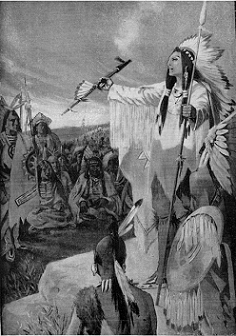
HIAWATHA, FOUNDER OF THE IROQUOIS LEAGUE.
The Iroquois League was composed of the Mohawk, Oneida,
Onondaga, Cayuga, Seneca and Tuscarora nations, who founded in
the New York wilderness a barbaric republic, with bonds of union that
might serve in many respects as a model for civilized nations of to-day.
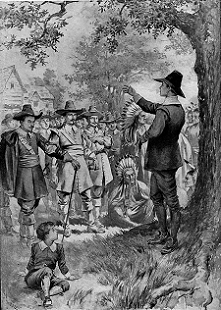
THE INDIANS LISTEN TO A MISSIONARY.
The Indians often visited the colonists and listened to the
traveling missionary, but only a few converts were made among
the red men during the seventeenth and eighteenth centuries.
It will be recalled that Powhatan had several homes. The same was true of Massasoit, though his principal home was at Mount Hope. Governor Bradford had hardly come into office when he sent an agent to Massasoit to confirm the treaty made with Carver, to procure seed corn and to explore the country. Massasoit did as requested, and a piece of better fortune could not have come to New England. Plymouth and her neighbors for a long time were so weak, and their sufferings from disease and hardship so severe, that a union of the Indian confederacies would have swept them from the earth. The feebleness of the colonists could not be hidden from the Indians, but Massasoit checked the enmity of the surrounding tribes, and by uniting with Roger Williams in 1637, the other red men were kept from joining the Pequots in their war against the colonists. Thus more than once, and through many years, this great man really saved the settlements from destruction.
There are few American Indians whose fame is not wholly due to their military skill. Many were great orators, and not a few showed noble traits of character. The case of Massasoit, therefore, is the more remarkable, for no man not gifted by nature with fine ability and tact, could have held peace for so long a time among the fierce tribes, not only under his direct rule, but that belonged to the confederacies surrounding his own people. Soon after the signing of the treaty, one of Massasoit's sachems tried to start a rebellion against his sovereign. With the help of the bold Miles Standish, the scheme was brought to naught, and the example[66] of Massasoit led nine other sachems to come to Plymouth and sign a treaty of submission to the English king.
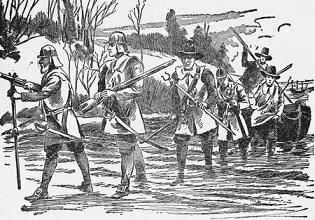
MILES STANDISH AND HIS SOLDIERS ENTERING THE INDIAN COUNTRY
In 1623, news reached Plymouth that the great sachem was mortally ill. Governor Bradford sent at once two of his people and a friendly Indian to the chief, who was found near death. No doubt he would have soon passed away, but for the prompt action of his white friends, who gave him cordials and took such measures that he was soon restored to rugged health, and lived many years afterwards. Massasoit was very grateful all his life for this kindness. He told his visitors of a plot that was on foot among the Massachusetts tribe and several others to massacre the English settlers at Wessagusset. He urged that sharp measures be taken against the plotters, and Captain Standish did so with such vigor[67] that the evil men were terrified, many of them killed, and the peril ended.
In 1632, Massasoit was set upon by a party of Narragansetts, and fled for his life to an English house near at hand. As soon as news of his danger reached Plymouth, Captain Standish with a small armed force was sent to aid the brave chief in his danger. It did not take the "man that never feared" very long to scatter the Narragansetts and to rescue the good friend of the English from his great danger.
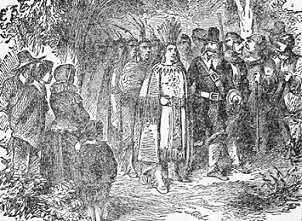
MASSASOIT VISITING THE GOVERNOR
As Massasoit grew in years, he united his oldest son with him in the government of the people. In the autumn of 1639, the two came into open court at Plymouth with the request that the treaty of 1621 should continue unbroken. Not only that, but the two chiefs made new pledges which gave the colony a first claim to the Pokanoket lands. The exact date of Massasoit's death is not known, but it was probably soon after 1660. That he was one of the best friends the white men ever had they were soon to learn in the most alarming manner.
More than one neighbor of Massasoit was famous at this same time. Next in power to the Wampanoag confederacy was that of the Narragansetts, who, it will be remembered[68] inhabited a large part of the territory which afterward became Rhode Island, including all the islands in the bay named for them. The Sagamores of a portion of Long Island, Block Island and Niantic were also under their sway. They had more than two thousand warriors, one-half of whom owned firearms and knew how to use them. They had long been enemies of the Pequots on the west and the Wampanoags on the north.
The chief sachem during the days of Massasoit was Canonicus, who after a time joined his nephew Miantonomah with him in the government of his tribes. This was probably due to the youth and wisdom of his relative. When Roger Williams was driven out of Salem because of his too plain preaching, he fled to the country of Canonicus. The chief, although a little distant at first, received him kindly, and gave him a large tract of land, which Williams divided among those who followed him into exile. Thus the city of Providence was founded and the settlement of Rhode Island begun.
This friendship on the part of Canonicus was the more notable because he disliked the English from the first. As early at 1622, he was determined to attack them, and sent a messenger to Plymouth with a bundle of arrows wrapped about with a rattlesnake skin. This was a challenge to war, and Governor Bradford could not mistake its meaning. He snatched up the rattlesnake covering, flung aside the arrows, and stuffed the skin full of gunpowder and bullets. He ordered the messenger to tell his chief that if the white ruler had a vessel, he would not wait for Canonicus to come to Plymouth to fight him, but would seek him out and give him all he wished of war. The chief was invited to come to Plymouth at once and start the fighting. The bold message had its effect.[69] Canonicus decided to leave the white men for the present alone. It was Canonicus who led the attack on Massasoit in 1632, when he had to flee to an English house and Captain Miles Standish hurried to his rescue.
In 1636, the Pequots formed a conspiracy to slay all the English in their country. As a first step, they asked Canonicus and Miantonomah to make a treaty of peace with them, and to join in the war against the settlements. The temptation was a peculiar one to the Narragansett leaders. They had now the chance of striking a blow at their old enemies, the Pequots, or of joining with them against the English. Their inclination was to make common cause against the white men. Roger Williams was living among the Narragansetts when the Pequot messengers came to Canonicus, and he used all his powers to keep the chief out of the alliance. The Pequots were enraged and would have killed him had they dared, but Canonicus was a true friend of the exile, and they were afraid to offend the chief. Finally, he yielded to the prayers of Williams, and refused those of the Pequots, who entered upon the campaign alone, and, as a consequence, suffered destruction at the hands of the colonists. In this dreadful work the whites had the help of several hundred Narragansetts.
Another great Indian leader now appears on the stage. He was Uncas, who was born a Pequot, and was one of more than a score of the leaders of that unfortunate nation. During some domestic troubles, he rebelled against his sachem and became the head of a strong "Schism." This was just before the opening of the Pequot war. The territories of the Pequots were divided, and the part known as "Mohegan" fell to Uncas, who aided the English in their overthrow of the Pequots. It is said that he felt pity for the dreadful misfortunes[70] of his old friends and neighbors, and, in more than one instance, did what he could to shield them from the fury of their conquerors. Moreover, he gave protection to a number of settlements, Norwich being one of the towns thus favored.
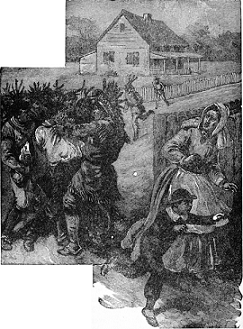
A PEQUOT MASSACRE
In 1638, the magistrates at Hartford asked Uncas and Miantonomah to come thither and agree upon the division of the two hundred Pequot captives (not including women and children). In the division eighty went to the Narragansett chief, twenty to a neighboring chief, while a hundred were turned over to Uncas. He and Miantonomah had long been jealous of each other, the feeling being strong on the part of the Narragansett. The two leaders pledged themselves to peace, but their mutual hatred was too deep for either to keep the letter or spirit of the agreement. Miantonomah was ambitious, and wished to become ruler of all the New England Indians. Uncas belonged to the branch with which the Narragansetts had always been at enmity, and the Narragansett leader determined to kill him on the first chance, believing that the way would thus be opened for a union of all the tribes against the English.
The first attempt to slay Uncas was made in the spring of 1643. The criminal caused only a slight wound, when he fled to the Narragansetts, telling every one he had slain Uncas. Learning after a time his mistake, he said that Uncas had made the wound himself and then told the story of the Pequot shooting him. A probing of the affair by the authorities at Boston removed all doubt of the guilt of the man who had been delivered to the court by Miantonomah himself. This chief removed all suspicion of his part in the matter, and the prisoner having been turned over to him at his request, he slew him with his own hand.
Almost at the same time, a sachem on the Connecticut killed a leading Mohegan, and, waylaying Uncas, shot several arrows at him. Uncas complained to the governor and court of the colony, who tried without success to settle the affair. The criminal refused to express regret, and insisted that Uncas[72] should fight him. Uncas accepted the challenge and invaded the territory of the other to whom he gave a severe defeat. There seems little doubt that Miantonomah prompted both of these attempts at assassination. The baffled sachem was an ally, and the Narragansett set on foot a campaign against Uncas, hoping to strike his blow before the Mohegan could prepare for it. The spies of Uncas warned him of his danger, and he hurriedly gathered several hundred warriors to meet the invaders that were twice as numerous.
In order to save his villages the Mohegan marched out several miles toward the Narragansetts. When they were face to face, he called to Miantonomah.
"You have a good many brave warriors, so have I; it is a pity that these men should lose their lives because of a quarrel that is only between you and me; if you are as much of a man as you claim to be, you will come forward, and we will fight it out between ourselves; if you slay me, my men shall be yours; if I slay you, your men shall be mine."
This challenge was not only a brave one, but it was cunning, for, if accepted, it would make the conflict equal by holding it to two leaders. Rather it would give Uncas a marked advantage, since he was of unusual size and strength. Miantonomah was too wise to throw away his opportunity.
"My warriors have come a long distance to fight," he replied, "and they shall not go home without a fight."
It was the answer that Uncas expected and for which he was ready. The words were hardly spoken, when Uncas dropped like a flash to the ground. At the same instant his men launched a shower of arrows over his body, uttered a series of shouts, and rushed like a whirlwind upon the Narragansetts.
The assault was so sudden that the invaders were thrown[73] into a panic, with the whooping Mohegans at their heels. No mercy was shown, and the Narragansetts were cut down like frightened sheep. Miantonomah could not rally his warriors, and joined in the headlong flight. He was soon overtaken, but the pursuers left him to Uncas, who quickly came up and seized him by the arm. Believing nothing could save him, the hapless chief stopped short and sat down without speaking a word. Uncas gave a signal which brought a number of his men to the spot. The prisoner continued sullen with downcast eyes and would not make any reply to the taunts of Uncas.
"If I were your prisoner," said he, "I should have begged for life; are you too proud to ask a like favor of me?"
Miantonomah was too proud to beg for mercy. Uncas spared his life for the time and took him to his village as a proof of his triumph. He then conducted his prisoner before the governor and magistrates at Hartford, and asked them what he should do with him.
This act put the authorities in a delicate situation. There was no war between them and the Narragansetts, and they did not wish to interfere in the quarrel. They therefore turned the problem over to the Commissioners of the United Colonies, who were to meet in September. By this time, Miantonomah had regained speech, and, knowing he would be safer as a prisoner of the English than of his rival, begged that he might remain in custody at Hartford. Uncas was willing, but insisted that he should be held as his prisoner.
The Commissioners tackled the question. They declared that it had been proved that Miantonomah had made several attempts against the life of Uncas; that he had set on foot a general plot among the Indian tribes for the destruction of the colonies, and, still further, that he had urged the Mohawks[74] to join in such a plot, and that they were already within a short distance of the English settlements, and only awaiting the release of the Narragansett sachem to unite with him in the attack. They condemned him to death at the hands of Uncas, who was urged to make it merciful, and not torture his captive. It was ordered that the execution should take place in the presence of "certain discreet English persons," and the Hartford government was to provide Uncas with sufficient forces to protect him against all his enemies.
These directions were carried out. Uncas went to Hartford, received his prisoner, and conducted him to the spot where he had been captured. Hardly had the party arrived, when a Mohegan, directly behind Miantonomah, killed him with a single blow of his tomahawk.
It is only fair to add that historians have never agreed as to the real character of Uncas and Miantonomah. The incidents just related would seem to make Uncas the better of the two, but some think he was simply the more crafty and cunning, and that the Narragansett sachem was innocent of the attempts made against the life of the Mohegan leader, as well as of the charge of urging the Mohawks to join him in a war against the English. It is impossible at this late day to settle the dispute as to the honor of Miantonomah, but we must quote the tribute of Stephen Hopkins, who was governor of Rhode Island for nine years, and a signer of the Declaration of Independence:
"This was the end of Miantonomah, the most potent Indian prince the people of New England had ever any concern with, and this was the reward he received for assisting them seven years before, in their war with the Pequots."
The death of Miantonomah took place in 1643. News of what had been done was sent to Canonicus. He was then[75] an old man, well beyond fourscore, and greatly broken in spirit by the loss of a favorite son. He signed a deed in April, 1644, by which he subjected himself and his lands to King Charles I. of England. He had lost all desire for war, and was in no condition to punish the last sad blow that had been dealt him. He died just before the middle of the seventeenth century, when he must have been nearly or quite ninety years old.
Uncas lived for several years after the close of King Philip's war. He was crafty and treacherous, and the English bore more from him than they would have borne from any one else, because of their wish to hold him as an ally. Despite the halo which some writers have thrown about his memory, it is impossible to believe he was as truthful, high-minded and honorable as many less noted members of his race.
THE UNCROWNING OF A KING
PHILIP'S ADVENTURES AND DEATH
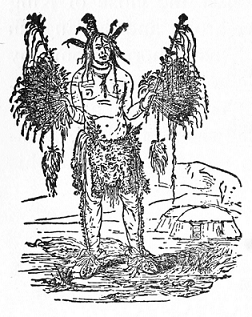
MEDICINE MAN
When Massasoit, the friend "tried and true," of the English, died, he left two sons,—possibly more, but only two figure on the pages of history. The oldest was Moanam, or Wamsutta, and the second Metacomet, the former being heir to the chieftaincy of the Wampanoags. Before the father died, he brought his two sons into the open court at Plymouth, and asked that each be given a Christian name, in token of his wish that the good understanding with the colonists should continue unbroken. The elder was, therefore, called Alexander, and the second Philip. You will note the classical character of these names, as they were thus given in memory of the famous heroes of ancient times.
It was not long before Alexander was in trouble with the English. Rumors reached the governor and council that he was plotting with the Narragansetts for a war against the whites. The record says that such good proof of the truth of these reports reached the authorities that they ordered Alexander to appear before them and make explanation.
Because he did not do so at once, an armed force was sent in July, 1662, to bring him to Plymouth. He was arrested with a number of his armed followers, and being ill, asked leave to visit his home. He was allowed to do so, and died on the way. One of our leading historians says the suspicions of the English had no real cause, and their course toward Alexander was unjust to the last degree. He may have been innocent, or he may have been guilty.
Be that as it may, the death of Alexander, on the threshold of his reign, was bad from every aspect. Philip declared that his brother had been poisoned at the hands of the English. Many of his people believed the charge, and it was whispered by more than one white man. Possibly it was true, though we cannot think so.
The result of the elder brother's death was to bring Philip to the "throne" of the Wampanoags. He ranks as one of the greatest Indians in history. He was wise, eloquent, far-seeing, brave, resourceful, chivalrous at times, merciless at others, and a leader of remarkable ability. Resentful as he felt towards the English, he saw the madness of a war against them, by his tribe alone, though they welcomed him with ardor to the chieftaincy. Following the example of his father and brother, he went before the court at Plymouth, and renewed the league that had lasted for so many years.
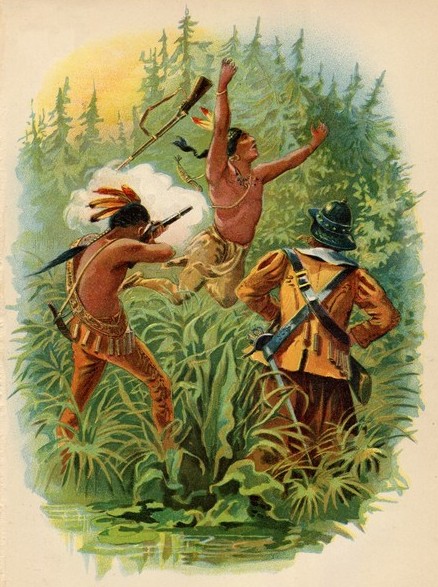
DEATH OF KING PHILIP.
It was a long time before a ripple of trouble came between Philip and the whites. The latter kept stealing the ground in his neighborhood, until the day came when he could not reach his home at Mount Hope from any direction without crossing the property claimed by some colonist. He was angered, and complained to the authorities. He was answered by the charge that he was secretly training his men[78] for war. Instead of going to court, the chief invited the officers to meet him for a talk. They did so at Taunton. Philip denied that he had any thoughts of harm to the whites, but said his warriors were preparing for defence against the Narragansetts. The whites kept to their charge, and he finally owned that there was truth in what they said. He was quite meek, and signed a pledge of friendship, and promised to turn over the arms of his warriors to the authorities.
This conference was held in the month of April, 1671. Beyond all doubt, Philip's submission was only a pretence in order to gain time. He had been accused of such designs again and again, until, as he said to one of his friends, he could not make the English believe he was their friend, and he might as well become their enemy. There must have been warrant on the part of the whites for doubting his truth, for after-events proved that he was plotting not only at that time, but had been laying his far-reaching plans for months.
It has been said that New England, during its early colonial days, had five powerful Indian confederacies. While the Wampanoags could not put more than a thousand warriors in the field, the united tribes could muster twenty-five thousand. What a resistless army they would form, if they would combine to destroy the pale faces that had come across the great water to steal their hunting grounds! King Philip's dream was to bring about such a union, and he now bent all his energies to the task.
The Wampanoag leader saw the necessity of care, time, and thoroughness in his preparations. It would be the height of rashness to strike before everything was ready. He held back the impatience of his followers, and was slowly moulding his grand scheme into form, but when fully a year was needed[79] in which to perfect it, the war was brought on by an unexpected event.
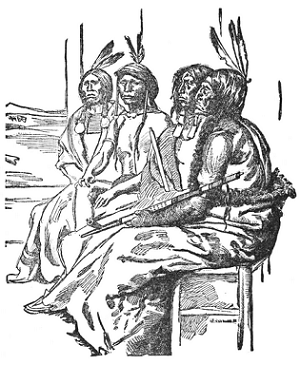
GROUP OF INDIAN CHIEFS
As a result of the self-sacrificing labors of Eliot, the missionary among the Indians, many of these people had been turned from their evil ways and become Christians. One of those professing conversion was John Sassamon, who had been partly educated at Cambridge, and served as school-teacher at Natick. He was cunning and artful, and became interpreter or secretary to Philip, who could not read or write English. In this situation he acted as a spy upon the chieftain, and betrayed all the secrets he could gather to the authorities. Philip discovered his treachery and determined to put him to death, but, knowing he was certain to be charged with the crime, it was carried out by three others, who no doubt were hired by Philip himself. In the month of January, 1675, the body of Sassamon was found under the ice in a pond near Middleborough, with such marks of violence as[80] to show he had been murdered before being thrust into the water. Three Indians were charged with the crime, one being a close friend of Philip, and all were hanged on evidence which in these days would not have been admitted in court.
Philip with good reason believed that the authorities would try to get hold of him, and, if they did so, he too would be executed as an "accessory before the act." He had not yet brought about the vast union of tribes that was under way, but he made up his mind to wait no longer. The squaws and children of the Wampanoags were sent to the Narragansetts, and the warriors stripped for the fray.
New England shuddered at what she saw was coming. The 24th of June, 1675, was appointed a day of fasting and prayer that the awful peril might pass by. The people gathered in their churches, and never were more fervent appeals sent to heaven than on that sultry Sunday in early summer, more than two hundred years ago. At the end of the services at Swansea, the people were walking quietly homeward, nearly every one talking of the dreadful danger that threatened, when without the slightest warning, a party of Indians hiding in the woods, fired upon them. One man fell dead, and several were wounded. Two others started on a run for a surgeon, but had gone only a few rods, when they were shot down. A general rush was made for the blockhouse or fort, and others were slain. The Wampanoags were very active, and in the course of a few minutes had several buildings in flames. Before the whites could rally, they dashed into the woods and were gone. The attack at Swansea was the opening of King Philip's War.
The chieftain pressed the war "all along the line." Taunton, Namaskat, Dartmouth and other towns were attacked,[81] and many lives lost and buildings burned. The settlements were so placed as to be much exposed in this method of warfare. They were far apart, the homes separated by no little space, and with slight means of defence. As a rule, each settlement had one large building, called a fort, specially intended for such danger. Corn and supplies were kept in these rude defences, into which the people rushed upon the first appearance of peril. The Indians showed no mercy, and old age, lusty manhood, feeble woman and helpless infancy went down before the tomahawk and scalping knife. There was no saying where the next blow would be struck. In the gloomy depths of the forest, on the shores of the lonely river, in the open,—everywhere, the warriors dashed like so many tigers savagely athirst for human blood.
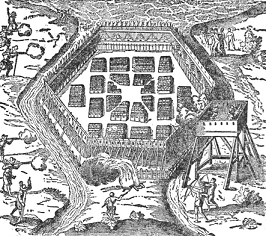
A STRONGHOLD OF THE INDIANS
From an Old Print
The war was kept for a time within the Plymouth colony. Rhode Island tried to keep out of it, but could not. Several settlers were killed at Tiverton, and a number of buildings were burned on the outskirts of Providence. In the middle of July, Captain Hutchinson entered the Narragansett country with an armed force, and made a treaty of peace with that[82] tribe. This cut off one of the strongest supports on which Philip had counted, but did not check his ardor. Being hard pressed at Pocasset, he and his son took refuge in a swamp. The whites decided to surround it and starve him out with his followers. They hurriedly enclosed the place on every side, only to learn after a time that the chief and nearly all his men had stolen out in the darkness and got away. Finding that they had gone to the country of the Nipmucks, Captain Hutchinson, at the head of a company of horse, hurried thither to prevent their joining Philip. But the chief had already won them over, as they had shown by killing five people at Mendon. Hutchinson fell into an ambuscade and lost sixteen of his men, the leader being among the killed. The survivors hurried to Brookfield and warned the people of their danger. They were about a hundred in number, and knowing the Indians would soon come, they swarmed into the only stone structure in the place, carrying with them a few such articles as they could snatch up, and taking no time to add to the slight stock of provisions already stored there.
Hardly had they crowded the refuge when the whooping warriors dashed into the settlement, firing their rifles, and using the torch with a vigor that soon set every building in flames except the fort itself. All this destruction, however, could avail nothing so long as the people themselves were not reached. Unless the roof of the stone structure was fired, the defenders were safe, and were sure to fight to the last. Could they have been certain of mercy, they would have surrendered, but every one knew what fate awaited him, if the hostiles once gained the upper hand. The grim pioneers were on the alert at every window and loophole, and the first warrior who tried to steal forward, torch in hand, was riddled by the deadly marksman. By and by, the attempt was repeated with more caution, but the dusky miscreant could not get near enough without showing himself for an instant, and that instant was his last. Then the Indians grew more careful in their movements.
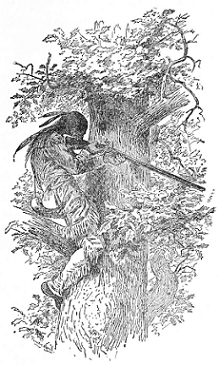
THE INDIAN'S CUNNING
In the hunt for game or in an attack upon an enemy the Indian
always has been noted for his cunning. Crouching on a limb of a
forest tree he waits, without the slightest movement, for hours
the approach of his game or enemy and picks him off with unerring
aim when his victim least suspects the nearness of danger.
And yet every person in the fort knew he was doomed unless help arrived. The arrows tipped with burning tow, which circled over in the air and struck the roof with a thud, plainly heard within, did not hold at first, but by and by some of them clung, and little twists of smoke appeared. These were put out by the watchful garrison, but the time was sure to come when their enemies must succeed.
The one thing necessary was for a swift runner to steal out of the building and gain a start upon the hostiles. The first one who made the attempt was captured, and a few minutes later the shouting savages were seen kicking his head to and fro as if it were a football. After a time, another man managed to get outside, but he was seen, and had barely time to scramble back through the door held open a few inches against such a failure. A third effort ended the same way, and then for the time the plan was given up, though plenty of volunteers were ready to make the dash whenever their friends thought there was the slightest chance of success.
With the coming of darkness, the peril of the settlers increased. Each side had grown more cautious. Knowing that every attempt to reach the fort would be met with death, the Indians refrained from the venture. Burning arrows curved through the air, but the roof was kept safe. At a late hour, the full moon rose above the tree tops and showed a startling danger. During the darkness, the Nipmucks had gathered a large mass of leaves, twigs, and dry branches and silently heaped them against one end of the building. When the defenders first saw the mass, smoke was rising from it.[85] Showing that the torch had done its work. Unless the fire was quickly put out, nothing could save the whites from the most frightful of deaths.
Suddenly a half-dozen men dashed through the door drawn softly inward, and leaping upon the burning stuff, kicked and flung it in all directions. The Nipmucks ran up to tomahawk them, but their friends were watching and picked them off with thrilling skill. Those who did not fall, fled, and they and their companions opened fire on the daring life-savers. But the work was over in a few minutes, and they leaped back into the building without one having received so much as a scratch.
The incident was repeated soon after with exactly the same results, the brave band scattering the burning mass and getting safely back under the unerring rifles of their comrades. But, best of all, in the confusion, one of the fleetest runners among the whites succeeded in dodging into the woods unnoticed, and sped like a deer for Boston, thirty miles away.
The Nipmucks kept up their attacks through the rest of the night, the next day and the night which followed that. It seems a miracle how the defenders held out for so many hours. The men took turns in snatching a few minutes' sleep and swallowing a mouthful of food, but not for one minute were they off their guard. The roof caught fire again and again, but holes were cut through the shingles, and water dashed upon the twists of flame, until after a time the charred, jagged openings showed in almost every square yard of surface, presenting a most desperate appearance.
On the third day, the Nipmucks piled a wagon frame with hemp, flax, wood and hay, set fire to it and backed it up against the house. By keeping it between them and the garrison, they were shielded against the rifles of the defenders,[86] who, without the power of harming one of them, saw with despairing hearts the blazing mass surge against the end of the building, and the smoke pour through windows and loopholes in a stifling cloud.
There was no way of rushing out and dragging the blazing stuff away, for before the lumbering vehicle could be budged, the hostiles would destroy the whites. Among the men, women and children, there was not one who saw a ray of hope or the faintest chance of escape.
And yet every one was saved! At the critical moment, the windows of heaven were opened, and the rains descended so that the flames were put out, and all the stuff so wetted that it could not be kindled again.
But it looked as if the saving of the poor defenders was only for a time, since the Nipmucks had but to press their siege to bring success. But throughout the hours of the first night and a part of the day, the runner who dodged unseen into the surrounding woods was speeding toward Boston. He reached the town and found Major Simon Willard, a veteran of three-score and ten, as eager as the most youthful officer to rush to the rescue of Brookfield. Leaping into the saddle, he led fifty horsemen at a gallop for the settlement. They swooped down like a cyclone, just as night was closing in, and attacked the Nipmucks with the utmost fury. Back and forth dashed the horsemen, shouting, striking and crushing down whenever a chance offered. The few who were quick enough to leap into the woods and get away left fourscore stretched lifeless on the ground, many of whom had fallen under the guns of the garrison.
King Philip's war was marked by more than one strange incident. One of these occurred a few days after the saving of Brookfield. The people in Hadley were at church, when[87] they were attacked by a large body of Indians. The preacher, as many a one had done before him, bounded down from the pulpit and was among the first to rush outside and catch up one of the guns stacked there, and to lead in the defense. The assault was so sudden and fierce that it was impossible to rally all the people from their panic. The cool-headed hurried the women and children into the church, or rather compelled them to stay there, while the men strove to beat back the hostiles.
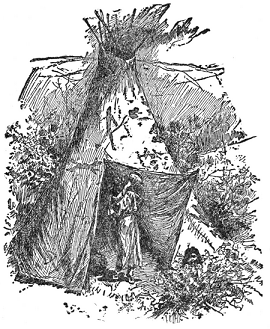
AN INDIAN WIGWAM
It quickly became clear that the day was lost unless the brave but scattered men, each of whom was fighting on his own hook, could have a leader, who would bring order out of the wild chaos. Suddenly the leader appeared, and not one of the amazed people could tell where he came from. He was tall, with a long, flowing white beard, and carried a sword in one hand. Swinging it over his head, he shouted his commands in the ringing tones of a trumpet, and with wonderful quickness brought order and confidence where all had been confusion in the leaderless defense.
Placing himself at their head, he led a charge which scattered the Indians like chaff. Then, when all danger had[88] gone, the strange deliverer vanished as strangely as he had appeared. He had come, he had acted, and now he was gone.
Many believed he was more than a human being,—one sent by heaven to save them in their peril. But he was as much flesh and blood as those whom he had rescued, being no other than General Goffe, who had fled with another comrade from England, for having been one of the judges who sentenced Charles I. to the scaffold. When the son of the executed king came to the throne, after the death of Cromwell, and the passing away of the Commonwealth, Charles II. ordered the death of all those who had condemned his father. Goffe and Whalley fled to the American colonies, and though search was made for them, their friends kept them hidden, and they were never arrested. General Goffe was hiding in the house of one of these friends at Hadley at the time of the Indian attack. Peeping out, he saw the dreadful danger, caught up his sword and rushed to the defence. When all danger was over, he quietly went back to his hiding place, and lived a number of years afterward.
On the same day that Hadley was attacked, the Indians burned several houses and barns at Deerfield, and some weeks afterward Northfield was almost destroyed, a dozen settlers being slain. Captain Richard Beers hurried from Watertown with thirty-six men to the relief of Northfield, but in a fight on the road lost twenty of his troop. Beers retreated to a hill and fought until his ammunition was spent. Then he being killed, the others fled. The garrison at Northfield was saved by the arrival of one hundred men who went with the troops to Hadley.
About the middle of September, Captain Lathrop left Beverly with nearly a hundred men to bring in the corn, grain and valuable articles at Deerfield. In his command were "the[89] very flower of Essex county," eighteen of them belonging to Deerfield. They finished threshing the grain, loaded it into wagons, and started for Hadley on the morning of the 18th. They had seen no signs of Indians, and halted near a small brook to rest. The weather was sultry, and they were tempted by the abundance of luscious grapes growing near. Leaving their weapons in the wagons, they began plucking and eating the fruit, but a large force of Indians had been stealthily following them all night, and now rushed upon them with such fury that only seven out of the whole number escaped.
Captain Mosely was scouting with seventy men, and, hearing the firing knew what it meant. He galloped in all haste to the place and attacked the Indians, but they are believed to have been under the command of Philip himself, and rallied and drove Mosely in turn. Then another force of English and friendly Mohegans appeared, and the Indians were driven off with the loss of nearly a hundred men. The waters of the little stream ran red that day, and it has ever since been known by the name of "Bloody Brook."
By this time the success of Philip had alarmed all New England. He kept drawing allies to his side, and it was soon learned that the powerful Narragansetts were about to join him. It was necessary, therefore, to strike a crushing blow at this ally. If they could be overthrown, little hope would be left to Philip, while, on the other hand, failure would be disastrous beyond measure to the greater part of New England. The campaign must be pushed with a vigor that would destroy Philip and his allies.
Massachusetts, Connecticut and Plymouth placed fifteen hundred armed men in the field, nearly one-half of whom were furnished by Massachusetts. To these were joined one hundred and fifty Mohegans, but they gave little help in the[90] campaign that followed. Governor Josiah Winslow commanded this large body of troops.
The Narragansetts, to the number of more than three thousand, were gathered in an immense swamp at South Kingston, Rhode Island. Philip was there and meant to stay through the winter. The stronghold was one of the largest of its kind ever known on this continent, including fully five hundred wigwams, and covering three or four acres in the form of an island, which was surrounded by strong palisades on every side. The only path leading to the fort was a narrow footbridge of logs. Here enough food was collected to last the multitude of Indians until spring. The weather was very cold, and snow lay to the depth of two or three feet on the level. In these circumstances, the Narragansetts did not believe they were in any danger of molestation.
It was a difficult and dangerous task that the soldiers had laid out for themselves, for the Indians could be counted upon to make a desperate resistance, and there were enough of them behind those intrenchments to give their assailants all and quite possibly more than they could do.
The soldiers were so ill-supplied with food that, despite the bad weather, they dared not wait. From a captured prisoner, Governor Winslow had learned of the single approach to the stronghold. The footbridge was so narrow that two men could not walk abreast. The first arrivals started on a run across the support, but were shot down the moment they came within range. Others took their places only to fall in turn. When six captains and a large number of privates had been swept away, those behind them fell back, and it looked as if the whole force was checked.
But Captain Mosely, whom a singular good fortune seemed always to attend, had managed by some means to get[91] within the fort at the rear with a handful of men, and all were fighting hand to hand against overwhelming odds. Their shouts brought others to their side, and by almost superhuman efforts, the Indians were driven from their main stronghold. Men, women and children ran in terror from wigwam to wigwam, chased by men as merciless as they, who spared none. In the assault at the rear, Captain Benjamin Church was wounded three times. He kept on fighting, and wished to save the wigwams with their valuable supplies, but the torch was applied, and the immense stronghold became a roaring conflagration.

INDIAN VILLAGE ENCLOSED
WITH PALISADES
Driven into the open, the Indians fought with the same fierce bravery as at first, and inflicted great loss upon the troops. But they were forced from the fort, which was now in possession of their enemies. Of the Indians, more than seven hundred were slain, while eighty of the English were killed and a hundred and fifty wounded.
Captain Church and Governor Winslow wished to stay in the stronghold, since it was the place where the wounded could have proper attention, but the surgeon and Captain Mosely opposed, believing the warriors would return to the attack and drive them out. Their advice was followed,[92] and, as a consequence, many of the wounded, who otherwise might have been saved, died before reaching the end of the dismal march of eighteen miles.
Among the prisoners was the head sachem of the Narragansetts, who, because he had violated his treaty with the whites, was put to death. The providential arrival of a vessel from Boston with supplies was all that saved the survivors from perishing of starvation.
This crushing blow to the Narragansetts would have ended the war had Philip been among the captured or slain, but he escaped and became more active than ever. He fled with most of the defeated warriors to the Nipmuck country, and made a visit to the Mohawks of New York, whom he strove to persuade to join him in the uprising against the English, but they refused, and the Wampanoag orator roused the Indians elsewhere. In the course of a month, the war was raging over an area of three hundred miles. Settlers who lived beyond the confines of villages were attacked, generally in the dead of night, and often when the weather was bitterly cold or a violent storm raged. They fought bravely, but few thus assailed escaped. Husband and wife, and, perhaps one or two of the larger children, joined in defending the home that was doomed from the first. The helpless ones were often tortured, and in other instances, were carried off to a captivity to which a quiet death would have been merciful. Warwick and Providence, in Rhode Island, narrowly escaped being laid in ashes, and Medford, Weymouth, Groton, Lancaster, and Marlborough—all in Massachusetts—were burned.
The Indians were so successful that they grew more daring. As if to show their contempt for the English, a body went to the deserted fields at Greenfield and began planting corn, showing thereby that they expected to harvest it.[93] Captain William Turner, some twenty miles away, was so indignant over the "nerve" of these redskins, that he resolved to teach them a lesson. He gathered more than a hundred troopers, and rode so hard that he reached Deerfield before daylight on the morning of May 10.
The attack was a surprise to the warriors, who fled to their canoes in such fright that they forgot to take their paddles, and many were swept over the falls. They were assailed so determinedly that more than two hundred were slain. Sad to say, however, the great advantage thus gained was worse than thrown away. Another force of hostiles was in the neighborhood, and unexpectedly attacked the English. Somehow or other, the rumor spread among the whites that their enemies were under the lead of Philip himself. When there was not the least doubt of destroying the Indians, the troopers were seized with a panic and fled in headlong confusion. The enemy, much less in number, pursued them for several miles, and killed one-third of the English, including Captain Turner himself. This sad affair gave its name to Turner Falls.
Despite the many successes of the Indians, they were doomed to failure in the end. The English far outnumbered all the warriors Philip could bring into the field, and they were better disciplined and more capable than the dusky natives. The defeats of the latter became so numerous that the seat of war shifted from Massachusetts southward to Connecticut and Rhode Island. Knowing that the quickest road to peace was by pressing the war vigorously, Massachusetts passed a rigid law for the impressment of soldiers, and Captain Church, who had recovered from his wounds received in the swamp fight at Kingston, gave the hostiles no rest. He shrewdly scared a number of Philip's allies into leaving his cause and coming to the side of the English. Even among[94] the Indians were many who saw the certain overthrow of Philip and the triumph of the English. When assured that none of these would be punished if they abandoned the chieftain, and warned that if they did not do so very soon, they would suffer the vengeance of the authorities, a large number made haste to accept the offer. Then, at the right moment, Massachusetts made known that she would pardon every Indian who laid down his arms within two weeks. So many took advantage of this offer, that the uprising received a fatal blow, and the danger to the English was past.
But Philip was not among those who cringed. He probably knew that although his warriors might be forgiven by the English, no pardon awaited him. A white man can be as fiendish as any savage, and that too without trying very hard, and many of those who preached the Gospel of love and forgiveness, were yearning for a chance to wreak vengeance upon the barbarian.
And yet Philip must have seen for a long time that he was waging a hopeless war. Since the longer he fought the more bitter would become the anger of the English against him, the question naturally arises, "Why then did he continue to fight?" To this, the answer is that such is Indian nature, and such the spirit of the warrior.
Ere long he became a fugitive, harried night and day. He was often obliged to flee in desperate haste, and make the quickest possible change of quarters. Some of his escapes could not have been narrower. One day, in a furious skirmish, a soldier recognized an Indian as the uncle of Philip, because of which he leveled his musket and shot him down, and yet the warrior at the side of the victim, who was spared and whose identity was unsuspected, was Philip himself. He cut off his hair, stained his face, and changed his clothes, so[95] that many of his acquaintances failed to identify him. This stratagem saved the sachem more than once from the English, who were trying to run him to earth.
When everything was going wrong, one of his men ventured to suggest to him, that he should try to make terms with the whites. The chief whirled like lightning, his face aflame with fury, and brained the insolent warrior. But the victim had a brother, who bided his time, and then made the sachem pay dearly for his ferocious cruelty.
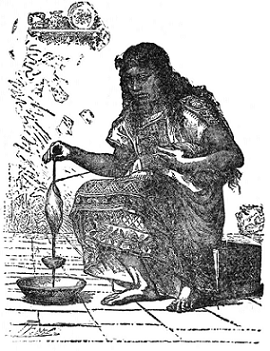
AN INDIAN CHIEF'S WIFE
Philip was devotedly attached to his wife and only son. He stealthily made his way to their home at Mount Hope, with a few of his faithful followers. His presence was betrayed to his enemies, who suddenly descended upon him. Philip escaped by a hair's breadth, but his wife and boy were carried off prisoners. The authorities at Plymouth solemnly debated over the question as to what should be done with these captives. Some favored putting them to death, but it was finally agreed to sell them as slaves. This was done, as in the case of many others, and they were sent to the Bermudas.
Captain Church was bent upon capturing or killing Philip. Many times he was close upon him, and it is quite likely the two saw each other more than once, but the royal fugitive was saved by the disguise named. His warriors kept steadily falling away from him, and he was harassed by that torturing of all doubts—the distrust of the loyalty of those that remained at his side. He must have asked himself many a time, as he looked into the stern, painted faces, whether all were true, or whether some of them were not planning his betrayal while they professed friendship.
One day an Indian hurriedly entered the camp of Captain Church at Tiverton. He was the brother of the man who had been slain by Philip for daring to suggest that he should make peace with the English. The hour for his revenge had come. He told Church that Philip and a few of his warriors were on a piece of land at the southern end of the swamp, near the base of Mount Hope. Church questioned the runner closely, and was satisfied he was telling the truth. He was familiar with the place and he knew the description given by his informant was correct.
No time was lost. Church had quite a number of men whom he hurried to the swamp. He placed them so as to surround it, and then ordered several of his best scouts to go within and rout out the fugitive. Philip was such an expert in woodcraft, and slept so lightly, that the men knew he was sure to discover their approach before they could get a sight of him in the tangled fastnesses.
Such proved the fact. The chieftain heard the stealthy footsteps, and, catching up his gun, rushed with a swift, noiseless tread along one of the faintly marked paths. Near the outlet he came upon a white man and an Indian. The soldier leveled his musket and pulled trigger, but the weapon[97] flashed in the pan. The Indian took careful aim at Philip, as he was running toward him, and sent a bullet through his heart. The chieftain fell forward on his hands and face into the mud and water, his gun flying from his hands. Thus passed away one of the greatest American Indians that ever lived—great in strategy, great in perseverance.
It is worth noting that the Indian who fired the fatal shot was Alderman, brother of the victim of Philip's anger. The gun barrel which carried the bullet may be seen to-day in the Historical Museum at Plymouth.
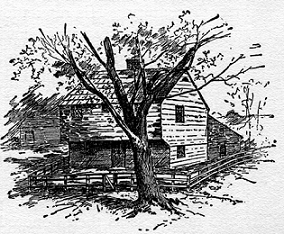
THE OLD INDIAN HOUSE AT DEERFIELD,
MASS., TAKEN DOWN IN 1848.

A MAN OF MARK AMONG THE DELAWARES
STORY OF TAMMANY, WHITE EYES AND CAPTAIN PIPE

AMMANY was the most famous of the Delaware Indian chiefs. He died toward the close of the eighteenth century. His reputation is that of a mighty warrior, a lofty patriot, and the greatest statesman ever born among his people. Such were his perfections that his countrymen believed he talked with the Great Spirit. In 1776, when Colonel George Morgan, of Princeton, New Jersey, was sent to the western Indians by Congress, he was so liked by the Delawares that they called him "Tammany," "in honor and remembrance of their ancient chief, and as the greatest mark of respect which they could show to that gentleman, who they said had the same address, affability and meekness as their honored chief."
When the first whites visited this country, the Lenni-Lenapes or Delaware Indians, one of the most important members of the Algonquin family, occupied the valleys of the Delaware and Schuykill. They were so powerful that they impressed themselves upon all the tribes from the Hudson to the Chesapeake. This power lasted till the rise of the Iroquois,[99] or Six Nations of New York, the greatest confederation that ever existed among the American race. It soon crushed the Delawares, who lost in a sense their independence. At an assemblage near Lancaster, in 1774, the Iroquois forbade the Delawares to sell their lands without the permission of their masters, who even called them "squaws," and looked upon them with undisguised contempt.
About the middle of the eighteenth century, the Delawares removed to the banks of the Susquehanna. They learned the principles of non-resistance from William Penn and the missionary Zinzendorf, for which they suffered much at the hands of the English and the Iroquois. The former charged that they were under French influence, while the Iroquois, angered at their neutrality, despoiled them without mercy and expressed contempt for the tribe.
The Delawares produced two remarkable chiefs, of opposing views. One wanted peace, and the other wished war. Each had hundreds of friends, and the tribe was broken up by quarrels, which often resulted in bloodshed.
The leader of the peace party had a hard Indian name, but was dubbed "Captain White Eyes" by the Americans. Whether this was due to any peculiarity of his organs of vision, we have not been able to learn. It may have been on account of his peace principles, which were as open as those of the Friends. He was the leading chief of the Turtle clan in Ohio, and his bitterest enemies never denied his lofty honor, pure life, and unselfish patriotism.
When the Revolution broke out, the British authorities used every effort to win the Delawares over to their side. Congress strove equally hard to hold them neutral. Thus two opposing factions faced each other. White Eyes was the sleepless champion of peace, and Captain Pipe of war to[100] the knife. Both had ingenuity, tact, and strong will. Captain Pipe, on his part, could count upon the natural, revengeful temper of his countrymen. They had many wrongs to brood over, and the Indian dearly loves war. White Eyes admitted the wrongs his people had suffered, but insisted that the true interests of the Delawares forbade them to take the side of either of the opponents. If they did, they were sure to suffer, and many of their bravest men would be slain. There was no difference between the British and Americans; one was as likely to prove as good or ill a neighbor as the other.
It followed that the Delawares in breaking apart joined one or the other of the warring champions. They lost sight of the principles at stake, and identified themselves with the leaders. The Delaware tribe had passed under the sway of two great sachems or "bosses." Which was to prevail?
White Eyes gave many proofs of his personal courage. When war became certain, he and several of his tribe went to Pittsburg to meet in conference a number of Senecas, members of the Iroquois or Six Nations and resolute allies of the British. White Eyes boldly opposed their designs, and used such biting words that the Senecas were angered. They told him he was the last one to prate of independent action by his tribe, when every one knew they had been made women by the Iroquois. White Eyes scornfully faced the chief who uttered this insult, and replied:
"I know you look upon us as a conquered nation; as your inferiors; as women, made such by you. You say you have placed hoes in our hands and ordered us to dig and plant for you, and that we shall wear petticoats. But look at me! Am I not a full-grown man and am I not in the dress of a warrior! Do I not carry a musket the same as you? And (waving his hand toward the Allegheny) all that is mine!"
These were daring words, and greatly disturbed many of his own warriors who believed the fiery Senecas would revenge themselves upon White Eyes and his friends. They sent word to the Iroquois that they did not think like White Eyes, and that they would not stay by his side. Captain Pipe had much to do with this cowardly action. He and White Eyes set to work with more resolution than ever, and each had varying success.
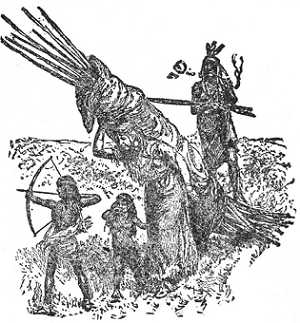
AN INDIAN FAMILY
White Eyes' message to the Wyandots at Sandusky was insultingly answered by notice to the Delawares to hold themselves ready to take the war path with them against the Americans. He visited a portion of the same tribe at Detroit. They refused to receive his peace belts except in the presence of the British governor. When the proffer was made before him, he snatched the belts from the hands of the chief, cut them to pieces, and threw them to the ground in a high rage.
"And you," he said, turning angrily upon White Eyes, "if you value your life, will leave here within half an hour!"
This remarkable man was often in imminent peril from his own people. Passion ran high, and among the friends of Captain Pipe were many who would have assassinated White Eyes had they not lacked the courage. It is hard to understand how he escaped, and how he retained his[102] influence over so many fiery warriors. Early in 1778, a number of Tories from Pittsburg came among the Indians with word that the Americans were hurrying against them, and their only hope of escape was to begin war without delay.
These rumors threw the Delawares into a panic, and for several days White Eyes could do nothing to stay the rising tide. When he was able to soothe them to some extent, he called a council to which he said he was satisfied that the reports were lies, and it would never do for his warriors to make a mistake in such a matter. He, therefore, asked them to do nothing for ten days. This would give time to learn the facts. The cunning Pipe also called a council. He gave out the impression that he knew the whole truth, and he called upon his countrymen to declare that man an enemy to the nation who did anything to prevent their taking up arms against the American people.
White Eyes parried this blow by saying that if the Delawares were determined to go upon the war path, he would go with them. "I have done what I could for peace," he said, "but if you choose to believe these lying vagabonds, you shall not go without me! And I shall not follow; I shall place myself at your head and none shall fight harder than I; I shall be the first to fall, for I do not wish to survive my nation; I will not live to mourn the destruction of a people who deserved a better fate."
This appeal was overpowering. The council, with more enthusiasm than such a body generally shows, declared that they would wait the ten days, while others said with equal emphasis that they would never fight the Americans unless led by White Eyes.
The baffled Pipe and his friends worked more determinedly than ever, and with such success that after several[103] days, many of the Delawares began preparations for war White Eyes was warned that if he interfered again, he would be killed. Nine days had passed without a single fact appearing to disprove the rumors of the coming of the Americans. It looked as if nothing could calm the rising war spirit.
Providentially, at this juncture, the German missionary Heckewelder, who had arrived among the Christian Delawares, not far from the village of White Eyes, learned of the crisis, and made haste to the settlement.
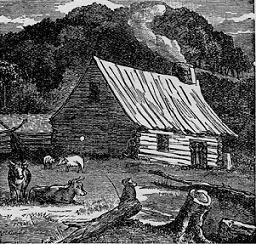
A PIONEER'S CABIN
His coming drew wide attention, and the warriors flocked thither from all points, anxious to learn the errand that had brought the white man thither.
The missionary and White Eyes had always been friends, but the chief now scowled at him and refused to take his offered hand. Heckewelder was amazed, but quickly read the meaning of the rebuff. Pipe had his spies in the crowd watching everything. If White Eyes welcomed the missionary, it would show that he had been invited to come, and that the whole affair was a scheme to throw dust in the eyes of the Delawares. If the chief showed a distrust, it would tell the contrary story.
Heckewelder demanded the reason of the chief's churlish action. He answered:
"I will tell you. If what has been told us is true, we[104] have not a single friend among the Americans; therefore, we are the enemies of every white man and can look upon you as coming to us only to put us off our guard that our enemies may take us by surprise."
Heckewelder strongly denied the charge, declaring that if he was not the friend of the Delawares, he never would have come among them. White Eyes fixed his piercing gaze upon the missionary, and in the hush that fell upon the throng, asked:
"Will you tell me the truth as to what I shall ask you?"
"I always strive to speak the truth and I shall not deceive you," was the reply.
"We are told that the American armies have been cut to pieces, that General Washington has been killed, that there is no more Congress, and that those that have not already been hanged will be taken to England and hanged by the king, that all the country beyond the mountains is in possession of the English, and the few thousand Americans who have escaped are gathered on this side of the mountains to kill us and our women and children. Now, tell me the truth; are all or any of these things true?"
With all the solemnity he could command, the visitor replied that there was not a word of truth in the rumors that had been brought to the Delawares. The Americans had not been defeated, Washington was unharmed, the cause of patriotism was making the best of progress, and he carried with him the proof that one of the greatest of the British armies had surrendered to the Americans only a few months before. Heckewelder then unfolded and displayed a newspaper which told of the capture of General Burgoyne and his troops. Then the visitor added that he had with him also the friendly messages which the Americans wished him to deliver to the Delawares as a sign of their good will.
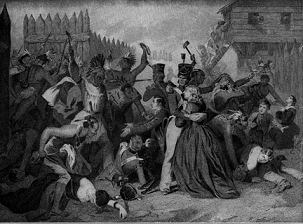
MASSACRE AT FORT MIMMS.
This fort in Alabama was attacked by eight hundred Creek warriors,
August 30, 1813, led by the noted half-breed and Chief Weathersford.
The fort held five hundred soldiers, men, women and children, but
being taken by surprise, over two hundred people were scalped.
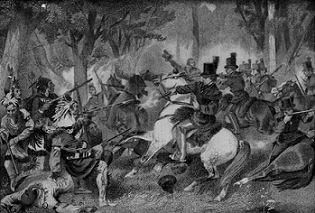
DEATH OF TECUMSEH THE GREAT INDIAN CHIEF.
Tecumseh was one of the most famous chiefs and Indian warriors of
the eighteenth century. He organized many expeditions against the
whites but lost his life at the Battle of the Thames, October 5, 1813.
He was an ally of the British in the War of 1812.
Every warrior present knew that the visitor was a man of truth, and his words caused a sensation. White Eyes seized the "psychological moment," and, turning to the assemblage, asked whether they should listen to the words of those who had always been their friends. The warriors replied as one voice that they would. Accordingly, the drum was beaten and the whole body moved to the council house, where friendly addresses were spoken. When they were finished, White Eyes stepped forward and offered his hand to Heckewelder, saying: "You are welcome, my brother," and the others did likewise.
It was a triumph. Captain Pipe was silent, and soon after, his spies brought him word that everything told by the white men was true. White Eyes sent his runners to the Shawnees, where the Tories had already gone to stir up enmity against the Americans, and the messengers did their work well. Never was a more complete victory gained by diplomat, statesman, or military leader.
Ever anxious for peace, White Eyes made a visit to Pittsburg in the winter of 1779-80, to talk with the Indian agent. He went with General McIntosh to the country of the Tuscaroras, where a fort was to be built for the protection of the neutral Indians, but, sad to say, he took the smallpox and died.
The death of the great and good chief caused profound grief not only among the Delawares, but with other tribes. One of the truest friends the American Indians ever knew had gone to his final hunting grounds.
White Eyes being out of the way, Captain Pipe naturally gained control of his people. He fought on the side of the British, and at times showed a high sense of honor and chivalry. He is believed to have died about the year 1820.
THE GREATEST OF INDIAN CONSPIRATORS
PONTIAC, CHIEF OF THE OTTAWAS
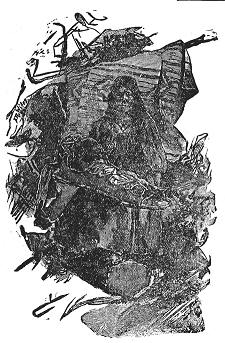
We are now to learn of another great American Indian,—one who ranks beside King Philip and Tecumseh, and whose career stamped itself upon the history of the frontier. This native leader was Pontiac, chief of the Ottawas.
Down to the opening of the last half of the eighteenth century, England and France were the leading rivals in colonizing America. The English planted their settlements along the coast, while the vast territory to the westward remained a wilderness, trodden only by the red men and wild beasts. France settled Canada, but, while doing so, she dreamed of founding a mighty empire, reaching from the Great Lakes to the Gulf of Mexico. She sent her surveyors into the[107] Mississippi Valley, and they buried leaden plates at different points to let every one know that the country belonged to the King of France. They also built forts to the number of sixty or more throughout that vast region, leaving no doubt that they meant to hold it if necessary by force of arms.
French trappers, hunters and explorers began pushing eastward into the valley of the Ohio. At the same time some of the English pressed westward. These pioneers of two civilizations met in the gloomy solitudes, and fighting and bloodshed followed. Neither would yield, and war was certain to come. You know that the building of Fort Le Bœuf, in the far northwest corner of Pennsylvania, was looked upon by Virginia as an invasion of her territory, and Governor Dinwiddie sent a messenger, named George Washington, with a letter protesting against the act. The gallant young Virginian came back with word from the French officer that he not only meant to stay there, but would drive out every Englishman who showed himself in the country which belonged to the King of France.
The French and Indian War followed, ending with the triumph of England. France gave up every foot of soil she had held on the Western Hemisphere, except a little fishing station or two, and agreed to turn over all the western posts to her conqueror. It was this change of masters that brought Pontiac forward and caused one of the greatest crises in the history of that region.
A short time after the surrender of Quebec, General Amherst sent an armed force to the leading post, Detroit, to receive its submission, and that of the other forts on the frontier. This body was under the command of Major Robert Rogers of New Hampshire, who had acted a prominent part in the war, and who gained still greater fame (though[108] unfortunately it was afterward tarnished) in the Revolution at the head of his famous Rangers.
Major Rogers coasted along southern Lake Erie late in the autumn of 1760. For a time the weather was crisp and pleasant, but when near the site of the present city of Cleveland, a cold, dismal storm broke, and the party put ashore and went into camp until the skies should clear. While resting, a score of Ottawa Indians visited the camp. They were led by a chief of striking appearance, whose identity Rogers suspected the moment he saw him. The officer had had dealings with red men, and none knew better than he how to treat with them. He showed the visitors every courtesy, and put on a meekness which it is safe to say he was far from feeling. He had heard of Pontiac, who now stood before him, and knew him to be one of the foremost of his race. The veteran meant to win his good will, if such a thing were possible.
Pontiac asked by what right these white soldiers dared to enter the country which belonged to him. Rogers explained that the war which had been going on for several years (and in which the great chief had played so honorable a part) was now ended by the victory of the English over the French. Rogers was on his way to Detroit to tell the news to the French commandant there, who would give up the post to the English, as soon as he learned the truth. There was no way of getting to Detroit except by passing through the country of the mighty Pontiac; he assured the great and good chief that no harm should be done to any of his people; he hoped he would not take offence, for the visitors would go back to their homes as soon as their task was over. Meanwhile he begged Pontiac to accept a few slight tokens of the good will of their Father across the water.
Rogers won Pontiac's good will by his flattery and[109] presents, and the chief told the visitors that so long as they acted rightly, no harm would befall them from his warriors. So Rogers and his party embarked in their whale boats once more, and in due time reached Detroit. The news they carried thither proved bitter medicine to the French commandant, and for a time he refused to swallow it, but there was no help for it, and in the end he submitted with the best grace possible.
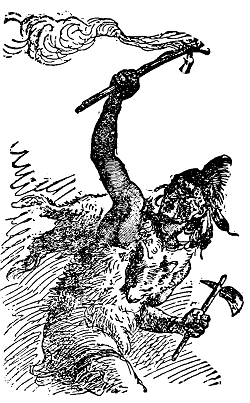
ON THE WARPATH
Few of the scowling Indians gathered round grasped the full meaning of this surrender. They could not understand how it was that a force so much larger than the English could yield to them. Another mystery was, why, after the French had submitted and laid down their arms, the English did not put every one to death. That was the fashion among the red men, with whom mercy is a failing of which few are guilty at any time.
There was one, however, in the dusky swarm who understood it all. "Because the English have conquered the French everywhere else," thought Pontiac, "those that are here are compelled to yield. The English will now become the masters of the Indians, and we have much more reason to hate them than we have to hate the French."
The words of the Ottawa were true. The French from the first were wiser than their rivals in dealing with the red[110] men. Naturally, therefore, the latter were generally the allies of the French in the wars between the two nations. Believing that the new masters would act cruelly—and there was good ground for such belief—Pontiac formed his great conspiracy. Like King Philip, three-quarters of a century before, his plan was to unite all the tribes he could reach into a confederation for keeping Detroit and all the western posts in the hands of the French, who had treated them better than the English. It was a plot of magnitude.
In the formation of this conspiracy, Pontiac had the aid, to a certain extent, of the French themselves. They were soured because of their defeat, and many of the officers could not justify France in thus throwing away a continent. They were sure that with the help of the Indians, it could have been held against their rivals. Such, also, was the unshakable belief of Pontiac. But he went farther than his white friends. He was certain that although some of the forts had been given up, they could be retaken from the English and turned over again to the French. In reaching this belief, the Ottawa forgot the laws of civilized warfare. He reasoned as an Indian.
Like King Philip also, he understood the necessity of thorough preparation. The plot would be ruined by impatience or by a blow delivered too soon. Weeks and months, and possibly years, were necessary to bring his plans to a head. He would not require the time taken by Opecancanough, but he meant to use all that was needed.
Pontiac's plan in brief was that the blow at all the western posts should be struck on the same day. Thus there would be no time for the forts to send warning to one another, or to give mutual help. Indeed, these forest garrisons were as a rule so weak that they were sure to have all they could do, after being warned of their danger, to defend themselves.
Pontiac set grimly to work. He held under his direct control the Ottawas, Ojibwas and Pottawatomies,—all powerful tribes, who could be counted upon to do his will. But he needed many more warriors, and he set out to gain them. He plotted and schemed for nearly two years before sending his ambassadors to the more distant tribes. To each he gave as his credentials a tomahawk painted red, and a wampum war belt.
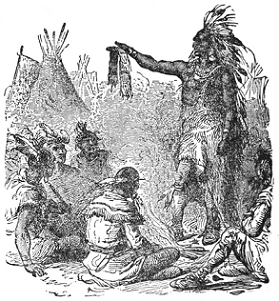
THE WAMPUM OF PEACE BELT
Active and ceaseless as was the chieftain, he could not do more than a fraction of the work alone. It was necessary to travel hundreds of miles through the trackless wilderness, often in the depth of winter, or when the floods descended and the hurricanes uprooted the forest trees. But while he was forever planning, his faithful ambassadors were busy, and so perfect was the work done by him and them, that every tribe between the Ottawa and Lower Mississippi was visited, and many were won to the support of the iron-willed chieftain.
Sir William Johnson held the Six Nations in New York in a tight grasp. He suddenly found Pontiac's messengers among them and doing dangerous work; but he was a warm friend of the English, as he proved when the Revolution broke out, and he succeeded in keeping his warlike wards[112] from going to the support of the Ottawa leader, excepting only the fierce Senecas, who pledged the ambassadors that when Pontiac called them, they would be ready to fight against the English. He fixed upon May 7, 1763, as the day when the general attack should be made upon all the forest garrisons covering a wide area.
Now, every one must see the impossibility of keeping secret this far-reaching conspiracy. The situation was different from that of Opecancanough in Virginia. That hoary leader of the Powhatans was able to do all his plotting in the depths of the woods, and his objective point was the settlements along the James. Pontiac's area of operations covered thousands of square miles; some of the tribes to whom he appealed were unfriendly to him, and the score and more of forts were widely separated. Here and there, the commandants, or those under them, had made warm friends of the red men, who could be counted upon to give them notice of any danger. It was impossible, therefore, to keep the plot secret during the two years it was coming to a head; the wonder is that it did not become generally known much earlier than was actually the fact.
The records of all wars with savages betray a strange blindness on the part of the whites to the signs of danger around them. This blindness may be due to their unwillingness to believe ill of those who have acted well for a long time, but none the less, it is hard to understand why it should deceive those who ought to be the last ones in the world to be caught off their guard in such surroundings.
Ensign Holmes had charge of the small garrison at Fort Miama, where Fort Wayne, Indiana, now stands. One day, an Indian of the neighborhood, who had shown a strong liking for the officer, came to him with the war belt that had been brought to his tribe by one of Pontiac's messengers. The Ensign's suspicions were roused, and he questioned his dusky friend closely. He revealed the whole plot.
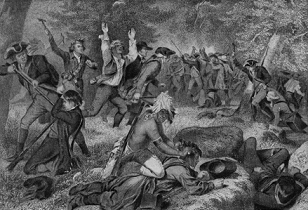
THE INDIAN MASSACRE IN WYOMING VALLEY, PENNSYLVANIA.
On July 3, 1778, Major Butler, commanding a force of Indians, British
and Tories, descended upon the beautiful Wyoming Valley, in Pennsylvania,
to dispossess the Continentals. The Indians could not be restrained and
a brutal massacre of men, women and children followedthe battle.
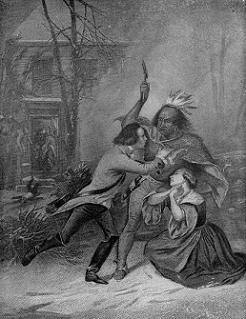
CHIEF BRANDT AND HIS INDIANS MASSACRE THE SETTLERS.
Cherry Valley, New York, was the scene of a sudden attack by the Indians
in 1778, when women and children were murdered in presence of their
husbands and fathers.
Holmes sent the war belt to Major Gladwyn, commandant at Detroit, with a letter telling all that he had learned, and asking him to send the news to General Amherst. Mischief was in the air, and precautions could not be taken too soon. Gladwyn, as requested, sent a runner to Amherst, bearing a letter which told what Ensign Holmes thought he had found out.
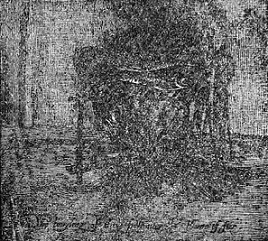
OLD WAY OF BROILING FISH
From the Original Drawing in the British
Museum, made by John White in 1585.
The major took pains to add that he did not credit the story and was sure there was no danger! It was the same old blunder that has been made times without number, and doubtless will continue to be made to the end of all things.
Our interest for the present is with Pontiac. Ten days before the date fixed for the general uprising and attack, he called his warriors together some miles from the fort, and made them a fiery address which aroused them to hurricane ardor. He had chosen as the special object of their attention, Detroit itself. He was allowed to come and go unquestioned, and had used the chance to study every point connected with the fort,—every weak and strong spot. This town was laid out in the form of a square, enclosed on every side by a high palisade, with a wooden bastion at every corner. Upon these bastions several small pieces of artillery were mounted, and there were blockhouses over the gateway. The dwellings,[114] about a hundred in number, were of wood, that would burn furiously if the torch were once applied. The garrison numbered a hundred and twenty men, and a third more could bear arms if necessary.
The watchful Pontiac had seen that Major Gladwyn was unsuspicious of his danger, and therefore had taken no precautions. It would seem that the capture and destruction of Detroit would prove as easy as "rolling off a log."
The chieftain explained his plan, which had the merit of simplicity, if of nothing else. He would call upon Major Gladwyn with a number of his chiefs and picked warriors, and make the usual Indian address, professing eternal friendship to the white man. At a certain point in his speech, he would present the officer with a wampum belt, but, in doing so, would hold it in a reversed position.
This was to be the signal. The moment it was given, each Indian was to whip out from under his blanket, his gun, whose barrel had been shortened, and make an assault. The Ottawas on the outside would also attack upon hearing the firing, and it looked as if nothing could save the garrison.
Such most likely would have been the result, had not an Indian woman revealed the whole plot to Major Gladwyn the evening before. He had made every preparation, as Pontiac himself saw the moment he passed through the gate at the head of his sixty warriors. What furious chagrin must have gnawed at his heart when he saw the defeat of his plans! Still, with wonderful self-control, he kept an outward appearance of calmness, greeted Gladwyn with a smile, and placing his party in the form of a semi-circle in front of the officer's quarters, began his speech.
Gladwyn knew what the signal was to be. He kept his eyes upon the black orbs of the chieftain, who looked straight[115] into his face. The critical moment came, when, the Ottawa decided after all to give the signal and stake everything upon the result; but the watchful Gladwyn read his purpose, and suddenly raised his hand. He and each of his officers drew their swords, the clicks of the gunlocks were heard in the hush, and the soldiers leveled their muskets at the visitors. Pontiac handed the wampum belt in proper form, and the tense situation was lifted for the time.

OUTSIDE THE GARRISON GATES
Pontiac handed the wampum belt in proper form, and the tense situation was lifted for the time. But Gladwyn was angry. He replied that the friendship of which the chief talked depended wholly upon him. So long as he and his people acted with honesty, they would be well treated, but if they proved unworthy, they should suffer. He left it to the chief himself to decide upon his course.
Pontiac still hoped to deceive the English commandant. He repeated his words of good will, saying that as evil birds had sung in the ears of his great ally, he would prove to him by his deeds that he should not listen to them. This sort of talk was kept up until Gladwyn lost patience, and gave orders that neither Pontiac nor his warriors should be allowed again to enter the gate.
Unsuspicious of anything of the kind, the chief appeared with a number of his men at the gate soon afterward, and was instantly ordered by the guard to keep away, unless he chose to come alone. The rebuff threw Pontiac into a rage. He saw it was useless to keep up the farce any longer, and threw all disguise aside. He dashed off at the head of his indignant warriors with whoops of defiance. They fired their guns at the garrison, who replied without effect, and ran to the house of an old English woman and her two sons, whom they tomahawked, and whose scalps they swung aloft in sight of the garrison. Then they sped to Hog Island, where an old sergeant lived, and slew him. The war had begun.
Pontiac had planned that attacks should be made on the same day upon all the British posts on the Lakes,—St. Joseph, Ouiantenon, Green Bay, Michilimackinac, Detroit, the Maumee, and the Sandusky, as well as the forts of Niagara, Presque Isle, Le Bœuf, Venango and Pittsburg. It was a far-reaching conspiracy, and, if successful, would have been the severest blow that could be dealt the frontier. Before giving the history of the siege of Detroit, let us glance at the fate of one other of the forest garrisons.
Michilimackinac (Mackinaw) stood, as we know, on the south side of the strait of the same name, between Lakes Huron and Michigan. It was there the traders gathered on their journey to and from Montreal, and it was one of the[117] most important posts in the West. It had about thirty families in as many different houses, and the garrison numbered nearly a hundred men. Its capture was left to the Chippewas, who were aided by the Sacs. They formed a cunning plan, which was kept secret from the garrison. It was to engage in a game of Indian ball, like lacrosse. Two posts were set up a long distance apart, and the ball was laid on the ground midway between them. The parties placed at the ends strove to bat the ball towards the opposite post, whose defenders tried equally hard to send the sphere into the other's territory. Like all games of this character a great deal of excitement is developed, and it was this fact upon which the Indians counted to surprise the garrison.
The men gathered outside on the broad plain to watch the contestants, and soon caught their ardor. They saw the ball roll back and forth, chased by the shouting players, and they joined in the cheers over the skill shown by them. More than three hundred brawny warriors were in the sport running to and fro, striking strong, quick blows with their bats, tumbling over one another, and acting for all the world like so many football players. For that which followed we are indebted to a trader named Alexander Henry, who was at Mackinaw at the time.
In the midst of the exciting scene, some one struck the ball a hard blow. It rose high in air, and circling over, dropped inside the pickets of the fort. It was the most natural thing in the world for the players to dash headlong after it, and the officers and soldiers who were looking on suspected nothing when they saw the panting horde swarm through the gates and inside the stockades.
The knocking of the ball over the pickets was not an accident, but had been agreed upon beforehand. It was the[118] trick by which the Indians gained a fatal advantage without rousing the distrust of their victims. In a twinkling the players turned from the ball, and drawing their hidden weapons, attacked the garrison. They cut down and scalped the Englishmen, who were taken so by surprise that no defence could be offered. It was a heartrending massacre.
Henry was not among those who were watching the game, but was in a room in one of the houses, writing letters to send to Montreal by a trader who was about to leave the post in his canoe. Hearing the unusual racket outside, he rose from his chair and looked out of the window. A horrifying sight met his gaze. He saw his countrymen falling on every hand, the Indians slaying and scalping them without mercy. On the outskirts of the slayers and victims, stood a number of Canadian villagers calmly looking on, as if they felt no special interest in the awful tragedy.
Henry saw his own peril, and the thought came to him that the only place of possible safety was in one of the houses of the Canadians. It would not do to stay where he was, for the Indians had already begun searching the dwellings of the English for more victims. Bounding down stairs, he dashed out of the rear, and climbed a low fence which divided his yard from that of his next door neighbor, who was a Canadian. Plunging into the rear of the house, he saw the Canadian and members of his family gathered at the front and watching the fearful deeds from the windows.
Henry appealed to the man to give him shelter until the outburst had spent itself. If he would hide him for the time, the trader would be safe, for the Indians did not offer any harm to the Canadians. The neighbor looked at Henry for a moment, and then coolly saying he could do nothing for him,[119] shrugged his shoulders and turned back to view the dreadful scenes in front of his dwelling.
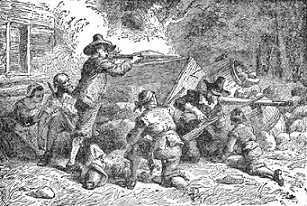
THE SETTLERS' DEFENCE
In this moment of despair, a Pawnee woman, a servant of the family, beckoned to Henry to follow her. He passed softly through the door, and, on the outside, she opened another door, whispering that it led to the garret where he should hide himself. He quickly did so, and she, keeping at his heels, locked the upper door behind him, and came down stairs, taking the key with her. The room was so loosely built that the fugitive could peer through between the cracks and watch the massacre on the open plain in front. While he was doing so, several of the savages, seeing that no more victims were left, ran to the building in which the trader was hiding. He peered through the crevices in the[120] floor, and heard the visitors ask the head of the house whether any Englishmen were inside.
"I do not know of any," replied the Canadian, speaking the truth, for he had not seen what his servant did. "If you have any doubts, search for yourselves."
Acting on the hint, the warriors went up the stairs, and who shall picture the feelings of the poor man, when he heard their footsteps and the next moment their hands trying the door? The absence of the key caused delay, which he quickly turned to account. In the corner of the room was a heap of birch vessels used in making maple sugar. He crawled under these, covering himself as best he could.
He had barely time to do so, when four Indians, covered with the blood of their victims, stalked into the room. They walked about the garret, peering here and there, one of them coming so close that the trembling white man could have touched his moccasin. But the twilight of the room (it had no windows) and the dark clothing of Henry helped him, and the Indians went down stairs without finding him. In the end, he made his escape, as has been stated, and we are indebted to him for the story of the fall of Mackinaw.
A BESIEGED GARRISON
THE ATTACK ON DETROIT
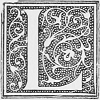
ET us now return to Detroit. Its experience is without a parallel in the history of our country. Never before was a town of importance held in a state of siege for more than a year by Indians. That such a remarkable thing took place was due to the genius of the master mind, who held the turbulent savages to their work, when the task of waiting is the most distasteful that can befall their race. Pontiac had to foresee the means of providing his forces with food, and he did it. He was the first American savage—so far as we have been able to learn—who gave promissory notes for the supplies he had to take from the neutral French residents outside of Detroit. Whenever he did this, he handed a memorandum of what had been taken, marked on the inside of a piece of bark, to which was added his totum, the sign of an otter. Moreover, this aboriginal financier redeemed every one of those notes, thereby setting a good example to his white brethren.
The Ottawa, upon being refused admittance within the stockade, had thrown aside all pretence of friendship or neutrality, and pressed his designs with a skill that even the defenders admired. The red skins crouched behind outbuildings, stumps and earth, and opened a hot fire which lasted[122] for several hours. The garrison replied as best they could, but little injury was done on either side. Finally, a cannon was loaded to the muzzle with red hot slugs, and the bits of iron when discharged, set fire to the principal outbuildings. As the savages scampered for cover, the garrison picked off a number of the most conspicuous.
Naturally the Indians made many attempts to burn the fort and other defences. If the flames were once fairly started, nothing could stay them, but the vigilance of the garrison night and day defeated every effort of this nature. Days and weeks passed without any marked change in the situation. The defenders held out grimly and the besiegers did not loose their grip. The supply of provisions began to run low, and, but for the help of the Canadians on the other side of the river, the garrison, who had long been on short rations, must have suffered for food. These friends came over at night, for had Pontiac known what they were doing, he would have stopped their practices and punished them.
At the wharf near the fort lay two schooners, which gave much help in fighting off the besiegers. The critical situation of Detroit had become known to the authorities, who were expected to send reinforcements and supplies to the post by way of Lake Erie. These were so slow in coming, that Major Gladwyn sent one of the vessels to hasten them. Several days later, the lookout at Detroit called out the glad tidings that the supply boats were in sight. When all faces were glowing with expectation, an alarming thing was seen. In one of the boats, a white man was desperately fighting with an Indian. In each craft were a number of warriors, who were lying down, in order to reach the fort undiscovered. In fact, all the boats with their supplies had been captured by the redskins. It was a clever ruse.
The schooner which had been sent to hurry the boats missed them, and sailed on to Niagara, while the relief expedition had coasted Lake Erie to the mouth of Detroit River. At that place they landed and were making camp, when they were attacked by a force of Wyandots, who killed many and took sixty prisoners. Two boats escaped with forty men, in one of which was Lieutenant Cuyler, in charge of the company. They made their way back to Niagara, while the prisoners were compelled to row to Detroit.
Meanwhile, a second expedition was fitted out at Niagara, and sailed in the schooner that had been sent thither by Major Gladwyn. She reached the Detroit River, but while still some miles below the fort, the wind died out and she dropped anchor. Every one on board was aware of their peril. The banks were lined with warriors, who would not let such a golden opportunity pass. It was about midnight, that a large number of canoes put out from the shores, and silently approached the schooner. The watchful crew allowed them to come within a few rods, when a broadside of grape and a volley of musket balls killed and wounded nearly two-score. The others leaped overboard or rowed frantically to land, and the next morning the vessel made her way to the wharf below the fort, much to the chagrin of the red men.
The presence of the two vessels was intolerable to Pontiac. He made several fire rafts, piled them with brush, set them ablaze and started them down stream. But the white men were looking for such an attempt, and by their quickness steered the flaming craft harmlessly past the schooners. Pontiac repeated the effort, but without success, and then gave it up as useless strategy.
As the weeks and months passed, without anything being done, many of the Indians grew tired of the siege. The[124] Pottawatomies and Wyandots proposed peace and exchanged prisoners with Major Gladwyn, who placed little faith in the promise of the savages. Pontiac, however, held his Ottawas and Ojibwas as strongly in hand as ever.
In the latter part of July, twenty-two barges, containing two hundred and eighty men, in charge of Major Dalzell, entered the Detroit River. A fog hung over the stream, and when the boats were opposite the Wyandot and Pottawatomie village, they received a fire which killed and wounded several men. It will be remembered that these were the tribes that had made an agreement of peace with Major Gladwyn only a few days before. They were partly punished by the return volleys of the reinforcements, which brought down a number of Indians and scattered the others in a headlong panic.
The arrival of such a large body of friends raised the hopes of the defenders to the highest point. Major Dalzell himself was ardent, and declared it a disgrace to submit longer to such a state of affairs. The idea of so large a force of white men being cooped up in the defences by a horde of painted Indians, was too much to be borne. He insisted upon attacking the besiegers, not doubting for a moment that he would send the whole lot flying. Major Gladwyn understood the situation better than his friend, and shook his head. He could not share the confidence of the officer. But Dalzell still urged, and finally, Gladwyn, against his own judgment, gave his consent to the plan for ending the siege of Detroit.
Just as the first streakings of day were beginning to show in the east, two hundred and fifty men moved out of the fort, and stole like so many phantoms through the forest, toward Pontiac's encampment. They kept along shore, while two bateaux, each with a swivel gun at its bow, held their places abreast of the soldiers. The expedition would have been successful, and a crushing blow given, had not the scheme become known to some of the Canadians, who revealed it to the Ottawa chief. He had time to make his preparations which he did thoroughly.
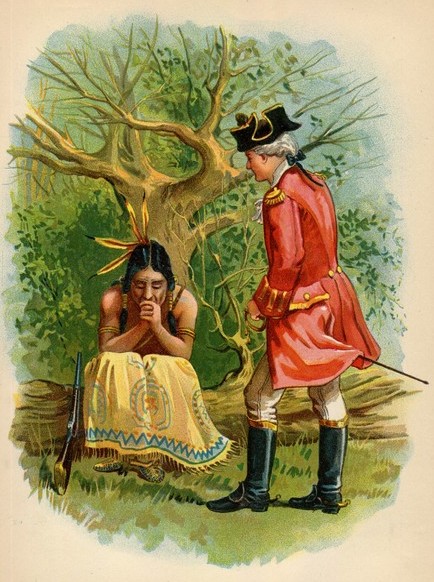
"WHO IS THERE TO MOURN FOR LOGAN? NOT ONE."
The soldiers moved forward, every heart beating high with hope. Not an Indian was seen until they reached the bridge spanning Parent's Creek. Then the hundreds of crouching warriors opened fire. Half the advance guard fell, when Dalzell, as the only means of saving the remainder, ordered a retreat. In the confusion, the soldiers were surrounded by the Indians. When it looked as if not one could escape, Major Rogers, with a number of men as brave as himself, took possession of a house swarming with fugitives, and defeated every assault, while the troops were fighting their way back to the fort. The bateaux aided Rogers by their fire, and he and his little company succeeded in reaching the post. The English loss was fifty-nine killed and wounded. Major Dalzell was slain while trying to save a wounded sergeant. This sad affair has passed into history as the battle of Bloody Ridge.
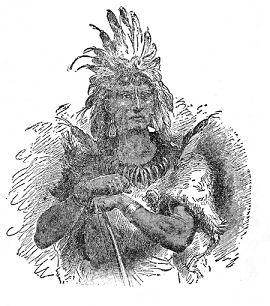
AN INDIAN APOLLO
The disaster cast gloom over the garrison and the survivors. While the force that remained felt able to hold out,[126] the besiegers were greatly elated. Many of the Indians who were on the point of going to their homes, gained new ardor in their support to Pontiac and his cause. They were certain to retain this enthusiasm for a long time.
On the night of August 4, a sloop arrived in sight of the fort with despatches from Niagara. The crew numbered barely a score, and the slackness of the wind forced the captain to drop anchor before he could reach a point of safety. Unfortunately, too, the night was very dark, so that an attack by their enemies was one of the certainties.
Sure enough, two hundred warriors stole forward in the gloom which allowed them to reach the sloop before they were seen. When discovered they were swarming over the gunwales at the bow, stern and sides. The crew fought with the energy of desperation, but could not withstand the furious assault. Seeing that all was lost, the mate shouted to one of the sailors to fire the magazine, that in their own destruction they might kill many of their enemies. Now, it so happened that among the Indians were several who knew enough English to understand the command, and they repeated it to the others. On the instant, every one leaped overboard, diving, swimming and struggling with frantic haste to save himself. With the loss of the captain and several of the crew, the sloop soon after reached Detroit.
By and by, impatience and discontent again spread among the Indians. That race in certain circumstances displays the perfection of patience, but not often does it do so in military operations. An Indian is eager for results, and when they are slow in coming, he loses interest in the affair itself, whatever it may be. Cold weather was at hand, and about the middle of October, all the tribes, except the Ottawas, sent messengers to Major Gladwyn with a request for peace. He[127] replied that he had not power to make peace, but would agree to a truce. They consented, and the officer made the best use of the time to gather food and supplies for consumption during the coming winter.
Pontiac saw signs of dissatisfaction among his own tribe, but his iron will still held his warriors well in hand. The crushing blow came near the close of October in a message from the French commandant at Fort Chartres, on the Mississippi. He told Pontiac that peace had been made between France and England, and gave him clearly to understand that he could expect no help from the French in the continuance of his causeless warfare.
Even then the resolute leader did not yield. He left the vicinity of Detroit with a number of his sub-chiefs and warriors, and visited the Maumee country, where he used all his eloquence and logic to draw these tribes into the war. He met with some success, but it was slight. The French commandant did more than notify him of the close of hostilities. He sent messengers with wampum belts and calumets to the principal tribes between the Ohio and the lakes, warning them to have nothing to do with Pontiac and his scheme, which was highly displeasing to the French. Finally, representatives of the leading tribes met Sir William Johnson at Oswego, and signed a treaty of peace and friendship with the English. Among those who took part in the important proceedings was Pontiac, once the great sachem of the Ottawas.
Pontiac returned to his own country, and was believed to be a good friend of the English, who it is said, gave him a pension, though this is not certain. His inclinations were to help the Americans in the Revolution, but he was held back by General Hamilton at Detroit. While attending an Indian council, the chief was watched by a spy for the[128] English who had become suspicious of him. Pontiac had grown fond of "fire water," and while under its influence, he betrayed his enmity to the English. Because of this he was treacherously killed by the spy, who had been bribed to do the deed by a trader. Thus Philip and Pontiac, two of the foremost of American Indians, were each slain by one of his own race.
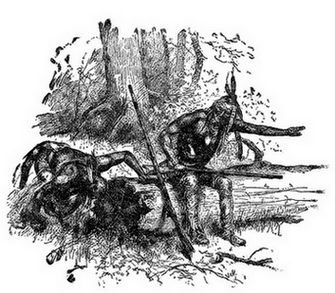
SAVED BY THE SPIDER'S WEB
A GOOD INDIAN
LITTLE CARPENTER, THE CHEROKEE
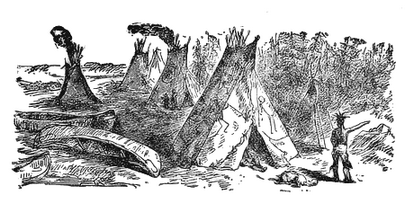
The great cavalry leader, General Sheridan, once said that the only good Indian was a dead one. It is unfortunate that the amicable relations of William Penn and the Indians could not have been more lasting and more widespread. Often the latter, with their savage instincts, were to blame for the feeling of hatred existing. But, on the other hand, many a red man has set a noble example to those who oppressed him. Such an Indian was Attakullakulla, a name so hard to pronounce, that we shall use the one by which he was known among the whites. This is Little Carpenter, who was a Cherokee chief, born early in the eighteenth century. Like White Eyes, of whom we have told, he was always opposed by a war party, at whose head was Occonostota, or the Great Warrior.
The Cherokees made a treaty with the English in 1730, and were their friends for a quarter of a century. Then on the eve of the great struggle between England and France for the ownership of America, French agents succeeded in causing a division of feeling among the Cherokees. English[130] messengers strove to win them to their side, and a grand council was called by the tribe to decide what they should do.
Everything was going in favor of the English, when the council was thrown into wild rage by the news that a party of their tribe which had visited the French on the Ohio, had been massacred by Virginians, while on their way back. So fierce was the anger of the Cherokee members of the council that they would have killed every English agent present, but for Little Carpenter, who managed to save them with great difficulty after an exciting harangue.
The Cherokees had given much help to the English expedition against Fort Du Quesne, but on their return, when the worn horses gave out, they left some of them by the way-side on the frontiers of Virginia, and took others that belonged to the people whose homes they were passing. This brought an attack upon them, in which two-score warriors were shot down. This crime was partly due to the fact that, after Braddock's massacre, Virginia offered a bounty for Indian scalps. Thus the white men where impelled by two powerful motives,—indignation over the theft of their property, and an avarice that did not stop at the call of mercy. It proved to be the sowing of the wind and the reaping of the whirlwind.
Little Carpenter would not have been an Indian had not his soul been stirred by this fearful crime. After he had warned the agents of their danger and safely hidden them, he turned to his warriors, his whole frame shaking with anger:
"Let us make war at once," he said, "and never bury the hatchet till our countrymen have been avenged. We cannot violate our faith or the laws of hospitality by staining our hands with the blood of those now in our power. They came to us as brothers, and have no blame for what evil men have done. Let them carry back the belts of wampum and[131] then let us take up the hatchet and not rest till all these murderers have been destroyed."
The man hated above all others by Great Warrior and the Cherokees was Captain Coitmore.
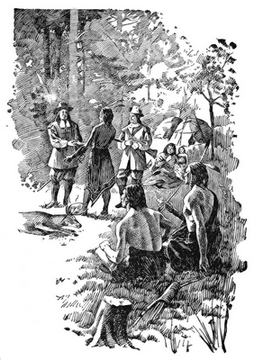
WILLIAM PENN TREATING
WITH THE INDIANS
He was the commandant at Fort George, had placed the ironed prisoners in their wretched quarters, and treated them with brutality. The continued confinement of the hostages enraged the Indians who laid siege to Fort George. It did not take Great Warrior long to learn he could make no impression on it, and he gave up his design for another, more subtle one.
He hid a number of his bucks in a dense cane-brake at the river side, and sent a squaw, who was well known at the garrison, to the captain, with a request that he would come to the water where the chief was waiting to tell him important news. Captain Coitmore was rash enough to accept the invitation and went to the place named with two of his officers as companions. He soon saw Great Warrior standing on the other side of the Savannah with a bridle in his[132] hand. This was to give color to his statement that he was going to Charleston to secure the release of the Cherokees held as hostages. As the distance was great, he hoped to be able to obtain a horse.
As he said this, the chief turned about and swung the bridle over his head. The act was the signal to his hidden men, who instantly fired at the three officers. The captain was killed and his companions wounded. The garrison immediately started to put all the hostages in irons, they having been released a short time before. They resisted fiercely, killing one of the soldiers and wounding several. The prisoners expected their comrades outside to come to their help, but that was beyond their power, and the troops completed their crime by putting every one of the imprisoned hostages remorselessly to death.
By a strange fatality the victims were related to nearly all the principal families among the Cherokees, who were driven to a frenzy against the whites. Great Warrior became as determined in his hostility as was ever Pontiac or Philip, while Little Carpenter, as grieved and angry as he, still saw that a war would only add to the sufferings of his people. He strove to keep them from taking the war path, but it was in vain. He stood almost alone. The scenes that followed were such as have spread woe and desolation times without number along the frontier.
The truth was driven home at last upon the Cherokees that only one way of escaping destruction was left to them: that was to make peace with the whites on the best terms they could get. When the force reached Fort George, twenty chiefs begged a meeting with the colonel. The proud Great Warrior was not with them, for he would have died before asking mercy of the invaders, but Little Carpenter was at the[133] head of the party. He was known to the commandant who received him and his companions with fitting honors, and accepted the statement that he spoke for his whole people. Addressing the officer, Little Carpenter said:
"You live at the water side and are in light. We are in darkness, but hope that all will yet be clear. I have been going about all the time doing good, and though I am tired, yet I come to see what can be done for my people who are in great distress."
At this point the chief handed over the belts of wampum which he had brought from the different towns as prayers for peace. "As to what has happened," continued Little Carpenter, "I believe it has been ordered by our Father above. We are of a different color from the white people. They are superior to us. But one God is father of us all, and we hope what is past will be forgotten. God made all people. There is not a day that some are not coming into and others going out of the world. The Great King told me the path should never be crocked, but open for every one to pass and repass. As we all live in one land, I hope we shall all love as one people."
Anxious as the Cherokees were for peace, and strongly as Little Carpenter had striven from the first to bring it about, it must not be thought that he was lacking in personal or moral courage. None but the bravest of men would have dared to withstand the terrible Great Warrior and the large majority of his tribe, as this chief did again and again. So at the present time, when the English leader of the expedition stated terms on which he would give peace to the Indians, Little Carpenter rejected one condition: that was the surrender of four Cherokees, specially noted for their cruelties, and their execution in front of the camp.
The chief closed his lips and shook his head. The colonel persisted. It was the only condition over which there was any hitch.
"I will insist," continued the officer; "take a day to think it over; you and all your people have asked for peace; these four men deserve death, and you ought not to let a little matter like that stand in the way."
On the day following, the colonel asked Little Carpenter for his decision.
"I gave it yesterday," he replied.
The officer was vexed at what he considered the stubbornness of the chief, and refused to yield to him. The most to which he could consent was that Little Carpenter should make the long journey to Charleston and lay the matter before the governor. Little Carpenter traveled the hundreds of miles through wilderness and solitudes, and explained his errand to the governor.
By this time, South Carolina had an executive of sense. He knew all about Little Carpenter. He considered him the finest type of his race, whose conduct from the first was highly honorable. He had never been known to ask an unreasonable thing, and the governor no sooner understood what he wished, than he assured him it should be granted.
Then Little Carpenter made another request:
"We wish that Captain John Stewart shall be made Indian agent in our nation. All the Indians love him and none of us will ever feel uneasiness while he is with us."
"It shall be as you wish," replied the governor, and the pleased chief, having obtained all, and indeed more than he expected to obtain, arose to set out on the long journey homeward through the wilds.
A MIGHTY MINGO CHIEFTAIN
LOGAN, THE ORATOR AND WARRIOR

HE Mingo chieftain known as Logan, had a fame which reached the other side of the Atlantic; he was the author of perhaps the best known speech ever delivered by one of his race, and his life was marked by a pathos that must touch every heart.
Logan was a chief like his father, but lived most of his life in the West, probably at Sandusky, or on a branch of the Scioto. A number of his warriors made their homes at these places. Why, if this chief was an Iroquois, is he called a Mingo? The explanation lies in the fact that the two words mean the same. The Iroquois are sometimes spoken of as the Mingoes, Menwes or Maquas.
Logan, although one of the bravest of men, always loved peace above war. Throughout the dark years before and during the plotting of Pontiac, he took no part except that of peacemaker. In time he became a most bitter enemy of the white race and if ever an Indian had good reason for such enmity, he was Logan.
In the spring of 1774, several white explorers in the Ohio country said they had been robbed by Indians of a number of horses, though it is by no means certain that such was the fact, or that, if the theft took place, that the thieves were not white men. Be that as it may, the explorers claimed[136] that the Indians should be taught a lesson that would prevent any more outrages of that nature.
The infamous Colonel Michael Cresap gathered a party of men as evil as himself, the members coming together on the site of the present city of Wheeling, West Virginia. Learning that some Indians were near at hand, Cresap made ready to attack them. The question of their guilt or innocence was of no concern to him. He knew he had enough men to defeat the small company, and that was all he cared to know before acting.
As if to help in the fearful crime, a canoe was seen coming from the other shore. It contained one warrior and several women and children. Hiding themselves, Cresap and his companions waited till the party had landed, and then each picked out his victim. When the guns were fired, not a single man, woman or child escaped. All these people belonged to the family of Logan, known far and near as the "friend of the white man."
This fearful outrage against the red man brought on a war in which occurred one of the most remarkable battles between the two races that has ever been fought in our history. The event, for some reason, has not attracted the attention it deserves.
Logan was changed from a warm, unselfish friend of the white people into their bitter enemy, and who can blame him? In July, 1774, he left his home with only eight warriors. Instead of attacking the settlements on the Ohio, where everybody expected the first blow would fall, he passed them by and made his way to the Muskingum, where nobody dreamed of danger.
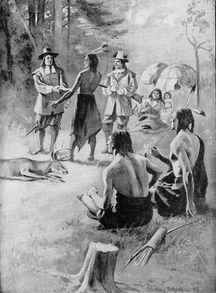
THE INDIANS FRIENDLY TO WILLIAM PENN.
The fairness, justice and generosity of William Penn in buying
from the Indians their lands and privileges, secured for him
and his settlers protection not enjoyed by the other colonists.
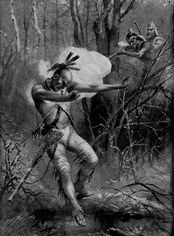
DEATH OF THE INDIAN KING PHILIP.
This famous Indian chief was for many years friendly with the
whites, but finally united the Indians in a final effort to drive
away the invaders. He was killed by an Indian enemy in 1675.
The first white men seen were three who were pulling flax in a field. One of them was shot down, and the others taken as prisoners. They traveled a long distance through the forest to the Indian village, where it was ordered that the captives should run the gantlet. This, as you may know, consists of the unarmed person dashing between two rows of his captors, standing a few feet from each other, all armed with clubs or knives, with which they strike at the unfortunate as he speeds forward and tries to dodge the cruel blows. If he succeeds in reaching the extremity of the double line, he is sometimes spared or allowed to make a break for liberty. But the ordeal is so dreadful, that not one in a hundred survives it.
Logan did not like any kind of torture, and he told one of the captives how he could escape many of the blows aimed at him. The man failed, however, and the Indians condemned him to be burned to death at the stake. Logan pleaded for his life, and, when it was refused, he cut the cords and caused his adoption into an Indian family.
The Shawnees and Delawares had suffered many wrongs and outrages, and they now joined in the war against the whites. The Virginia Legislature was in session when the news reached that body, and Governor Dunmore ordered the preparation of three thousand men to march against the Indians. One-half of this force, under the command of General Andrew Lewis, was to march to the mouth of the Kanawha, while the governor was to lead the other half to a point on the Ohio, in order to strike the Indian towns between the two. The movement of Lewis was to draw off the main body of warriors, leaving the way open for the governor. Having destroyed the towns, he was then to form a junction with General Lewis at Point Pleasant, subsequent action of the army to be guided by circumstances.
General Lewis with eleven hundred men began his march on the 11th of September for Point Pleasant, distant one[138] hundred and sixty miles on the Great Kanawha. The whole distance led through a wilderness without trails, but the force had a veteran scout of the frontier to guide them over the best route. They reached their destination on the last day of the month, and formed an intrenched camp. Lewis waited for more than a week for the coming of Dunmore, but he did not arrive, and the officer was in a quandary. The action of Governor Dunmore laid him open to the gravest charges. The various explanations of his conduct will be referred to presently.
On the morning of October 10, while General Lewis was still wondering and perplexed over his failure to hear from Governor Dunmore, a white man came to him with a startling story. While he and a companion were hunting deer, they ran upon a camp of a numerous body of Indians in their war paint. They fired upon the hunters and killed one, the other escaping with great difficulty by fleet running.
The news brought by this messenger left no doubt that a large force of red men were hurrying to attack the soldiers. It is said that General Lewis coolly lit his pipe and smoked for several minutes while reflecting upon the situation. He then ordered his brother, Colonel Charles Lewis, and another officer of similar rank, to reconnoitre the approaching enemy, while the commander arranged to support them. The two regiments had gone barely a fourth of a mile, when they met the Indians, advancing to the attack.
It was early in the morning and the battle opened immediately. The Virginians had not forgotten the lesson of Braddock's defeat, and fought in the same fashion as their opponents, taking advantage of the trees, bushes, roughness of the ground, and every object that afforded protection. The conflict was long and desperate. The uniform of Colonel Lewis[139] drew the attention of the warriors, and he soon fell mortally wounded. The Indians speedily proved their superiority and put the soldiers to flight, after having shot down a large number. In the crisis of the disorderly retreat, when a general massacre was imminent, reinforcements arrived and, by their firmness, checked the pursuit and compelled the Indians in turn to take refuge behind a breastwork of logs and bush, which they had been wise enough to prepare for such a check.
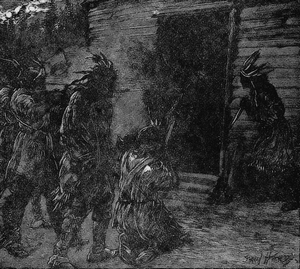
AN UNEXPECTED ATTACK
The redskins displayed rare military skill, for the breastwork alluded to extended clean across a neck of land from[140] river to river. They had placed men on both sides of the stream, so that if the Virginians were defeated, not one of them would have been able to save himself. It is claimed that the battle which followed was the most hotly contested of any ever fought between white and red men. The Indians did not scramble for the breastwork, but gave way, foot by foot, as may be said, contesting the ground with an obstinacy that more than once made the issue doubtful. Colonel Lewis having fallen, his brother officer, Colonel Fleming, was twice wounded, but kept his command and animated others by his coolness and daring. When the reinforcements arrived at the critical moment, the tide was turned, but Colonel Field, who was leading them was killed, and Colonel Fleming, already twice hurt, was shot through the lungs, but still refused to give place to any other officer.
Behind that blazing breastwork were fifteen hundred brave warriors, of the Shawanoe, Delaware, Mingo, Wyandot, and Cayuga tribes, under the lead of Logan, Cornstalk, Red Eagle, and other famous chiefs. Cornstalk was the head sachem, and the attacking soldiers heard his ringing commands many times above the din of battle. When he saw one of his frightened men trying to run away, he sent his tomahawk in his brain. He dashed from side to side of the long line, cheering all by his example. The battle lasted from morning until late in the afternoon,—something, as has been said, unknown in similar circumstances, and still the Indians held their ground, despite the repeated and desperate charges of the soldiers.
General Lewis became intensely anxious. He was distressed at the sight of the number of his men who fell at every rush. He saw that the Indians must be routed before night, or the Virginians were almost sure to suffer disastrous[141] defeat. He sent three companies, who, favored by the forest, reached the rear of the enemy unobserved. Then they dashed to the attack. The warriors did not believe they were a part of the force they had been fighting for hours, but thought they were reinforcements and that the Indians' only safety lay in instant flight. Just as the sun was setting they retreated across the Ohio and made for their towns along that river.
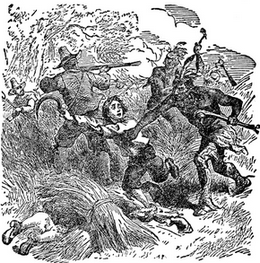
A BLOODY MASSACRE
The loss of the soldiers included nine officers and about fifty privates, with nearly a hundred wounded. That of the Indians is not known, but it is not likely it exceeded that of the whites. Judging by those who were killed and wounded, the circumstances, and the length of the conflict, the battle of Point Pleasant, in the autumn of 1774, seems to justify the claim that it was the hardest fought one that ever took place between the American and Caucasian races.
It has been said that grave suspicion was caused by the course of Governor Dunmore. He set out with the purpose of attacking the rear of the Indians and coöperating with General Lewis, and yet such could not have been his real intention, for he was seventy-five miles distant, and coöperation was out of the question. In the many attempts to[142] explain his course, it was said he meant to sacrifice General Lewis and his men in order to add to his own reputation. Such a theory is absurd, however, for he would have been denounced for his treachery, instead of being praised. Others have thought that he felt the justice of the Indians' cause, and tried to bring peace with the least destruction and harm to them. To us, the more reasonable theory is, that Governor Dunmore saw, as every one else saw, that the colonies were on the verge of rebellion against England, and he was very anxious to keep the goodwill of the Indians, with a view to bringing them to the side of the mother country. You know he did all he could to befriend England, and was rebuked by Patrick Henry and other patriots for too much activity against their interests, when war was about to open.
After burying his dead, General Lewis withdrew agreeably to the commands of Governor Dunmore. The latter advanced to within a few miles of the leading Indian town on the Chillicothe, for the purpose of treating with the tribes, from whom he had already received requests to do so. The meetings were marked with distrust on both sides. Cornstalk, in an indignant speech, laid the whole blame of the war upon the whites, due mainly to the murder of Logan's family. Governor Dunmore showed much tact, and, in the end, secured the pledges of the leading chiefs to the peace he sought.
Among the sachems who signed the treaty the name of Logan did not appear, nor would he go to the conference. Lord Dunmore was so anxious to obtain his name that he sent a special messenger to the cabin of the Mingo, a long distance away in the woods. When this messenger explained his business to Logan, the latter led him a little way from his cabin, and the two sat down beside each other on a fallen tree. The sachem gave his assent to the treaty, and in doing[143] so, uttered that memorable speech, which will live as long as man can admire eloquence, pathos and truth:
"I appeal to any white man to say, if he ever entered Logan's cabin hungry, and he gave him not meat; if ever he came cold and naked, and he clothed him not.
"During the course of the long, bloody war, Logan remained idle in his cabin, an advocate of peace. Such was my love for the whites, that my countrymen pointed as they passed and said, 'Logan is the friend of the white man.'
"I had even thought to have lived with you, but for the injuries of one man. Colonel Cresap, the last spring, in cold blood, and unprovoked, murdered all the relatives of Logan, not even sparing my women and children.
"There runs not a drop of my blood in the veins of any living creature. This called on me for revenge. I have sought it. I have killed many. I have fully glutted my vengeance. For my country, I rejoice at the beams of peace. But do not harbor a thought that mine is the joy of fear. Logan never felt fear. He will not turn on his heel to save his life. Who is there to mourn for Logan? Not one."
AN INDIAN DEMOSTHENES
RED JACKET, THE SENECA
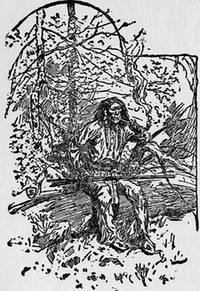
A SENECA WARRIOR
RED JACKET was the greatest orator ever born to the American race. President Jefferson said of the words quoted at the close of the preceding chapter: "I may challenge the whole orations of Demosthenes and Cicero, and of any more eminent orator, if Europe has furnished more eminent, to produce a single passage superior to the speech of Logan." Yet that speech is the only notable one which, so far as we know, was ever made by the famous sachem, who afterwards died of strong drink. But Red Jacket delivered many that will live. His eloquence at times reached the loftiest flights; his sarcasm and irony were unequalled, and the effect of his wonderful addresses was surpassed by no orator of ancient or modern times. He was never a noted warrior, and when he was once asked as to his exploits in the field, he replied: "A warrior! I am an Orator; I was born an Orator!"
The Indian name of Red Jacket, like most Indian names, is variously spelled, the most common being Sagoyewatha. He was chief of the Senecas, had white blood in his veins, and was born about the middle of the eighteenth century.
We know comparatively little of the military career of Red Jacket. It is certain that he fought with his tribe against the Americans during the Revolution, and was their enemy in the troublous times that followed in the West. He was never a great warrior or leader, and although he displayed bravery at times, he was surpassed in that respect by many of his people, who won less fame than he. It has even been charged more than once that the Seneca sachem showed a timidity amounting almost to cowardice,—a crime unpardonable with his race, and which would have brought disgrace to him but for his marvelous eloquence.
Red Jacket's one ambition was to become the greatest orator of his race, and as has been already stated, he gained that honor. The poet Halleck declared he possessed:
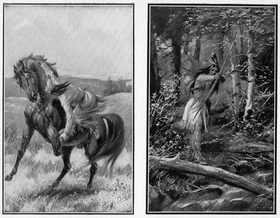
INDIAN CONQUERING THE WILD HORSE. THE INDIAN ARCHER.
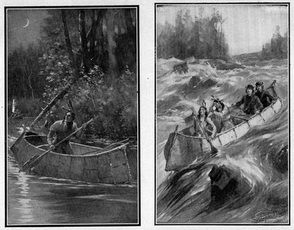
THE INDIAN SCOUT. INDIANS SHOOTING THE RAPIDS.
As proof of the oratorical genius of the chief, an incident may be related. In the spring of 1821, an Indian, belonging to his tribe, died of a mysterious disease. Several circumstances were so strange that the woman who attended him in his last hours was accused of being a witch. According to the laws of the nation, she was doomed to death, just as was formerly the rule among the most civilized nations, and especially in New England. The chief appointed to execute her did so without hesitation. The whites were so outraged and indignant, that they arrested the man and threw him into[146] prison. Among the witnesses was Red Jacket. Neither he nor the criminal himself denied the charge, but they pleaded that it was justified by a law in force from time immemorial. The chief had eyes of wonderfully piercing power. While on the witness stand, he suddenly called out in a voice that rang like a trumpet through the court room:
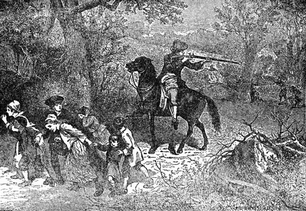
A HURRIED FLIGHT
What! Do you denounce us as fools and bigots, because we still continue to believe that which you yourselves believed two centuries ago? Your divines have thundered this doctrine from the pulpit, your judges have pronounced it from the bench, your courts of justice have sanctioned it with the formalities of law, and you would now punish our unfortunate brother for adherence to the superstition of his fathers!
"Go to Salem! Look at the records of your government, and you will find hundreds executed for the very crime which has called forth the sentence of condemnation upon this woman, and drawn down the arm of vengeance on her. What have our brothers done more than the rulers of your people have done? And what crime has this man committed by executing, in a summary way, the laws of his country, and the commands of his God?"
The prisoner was set free.
As has been hinted, Red Jacket became addicted to the use of liquor, as his years increased. He indulged at times to such an extent that even his own people felt scandalized. It was impossible that such an aggressive leader should not make enemies. More than one of his acts offended members of his tribe. Conscious of his own mental superiority, he left no doubt of the estimation in which he held others. He was not always tactful, and the attention paid to him by whites roused much jealousy. After plotting together, these enemies formed a plan for taking his chieftaincy from him in the autumn of 1827, they "impeached" him. A series of charges were brought against the orator, embracing about all the crimes a man is capable of committing. Had Red Jacket been guilty of a tenth of them, he deserved hanging. It was his drinking habits which really brought the issue to a head. The charges were signed by twenty-six leading Senecas who declared Red Jacket deposed.
But the fiery old orator was not the one tamely to submit to such injustice. Knowing that it was useless to appeal to his own particular tribe, he appealed to the Six Nations themselves, and, within a month of his deposition, the chiefs representing all the different tribes assembled in Grand Council, at the upper council house of the Seneca reservation.
The hearing was conducted with dignity. The charges were read and the action of the Seneca council stated. After several speeches, Red Jacket rose to his feet with all his former kingly majesty. He was old and his bad habits had wrought havoc with the once iron frame, but his eye had lost none of its fire, his voice none of its persuasive power, and for the occasion he was Red Jacket, the supreme orator.
His address was cunning, convincing and resistless. He swept every obstacle like chaff from before him. Even his enemies were thrilled by his eloquence. His victory was absolute. He was restored to his former rank and held it to the end.
Red Jacket's intemperate habits hastened his death, which took place in his own cabin, near Buffalo, in the month of January, 1830. The voice of the matchless orator, the "Last of the Senecas," was never to be heard again.
LITTLE TURTLE
FIRST AN ENEMY, THEN A FRIEND
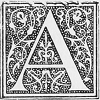
T the close of the Revolution, the boundaries of the United States were the Mississippi River on the west, the St. Lawrence and Great Lakes on the north, and the thirty-first parallel on the south. But for the famous expedition of Captain George Rogers Clark in 1778, the western boundary would have been the Allegheny Mountains. Clark was an elder brother of Captain William Clark, who, with Captain Merriwether Lewis, made his memorable journey across the continent to the Pacific, a quarter of a century later.
The opening of the vast region to the west of the old original thirteen States set flowing a tide of emigration into the new and inviting territory. The stream poured steadily year after year, but was often checked by the enmity of the Indian tribes, who claimed the country as their own, and resisted the inroads of the white men. Exposed cabins and small settlements were burned, and the inhabitants slain, while the stream of flatboats going down the Ohio had to run the gauntlet of the redskins along the shores. Although the craft had bullet-proof sides, even those, in many instances, failed to save them from destruction.
The most active leader of the Indians in their fights with the military forces sent thither to bring them to terms, was[150] Little Turtle, or Michiniqua, a Miami chief, of great ability. Although his father was also a chief, Little Turtle won his rank at an early age by his skill and bravery. Every attempt having failed to bring peace to the frontier, President Washington sent a powerful military force into the region. It was under the command of General Josiah Harmar, who had served well through the Revolution, and was commander-in-chief of the United States army from 1789 to 1792. He marched from old Fort Washington, the site of Cincinnati, in 1790, at the head of three hundred and twenty regulars, to whom more than a thousand militia were soon afterward added. Six hundred Kentucky troops, led by Colonel Hardin, pushed in advance, and, finding the Indian villages deserted, destroyed them, after which a part of his force was sent in pursuit of the savages. They had not gone far when they met a body of warriors, under the command of Little Turtle. The latter attacked the whites so furiously that over fifty were quickly killed, and the militia fled in headlong panic. General Harmar laid waste the only remaining Indian village in the neighborhood, and returned to Fort Washington. He determined to try again. Halting within a few miles of Chillicothe, he ordered Colonel Hardin to hunt out the Indians, and give them battle. Little Turtle was quite willing to be found, and again under his lead, the redskins fought with such daring that a hundred and fifty of the regulars and militia, including several leading officers, were killed. Although the survivors fled, General Harmar claimed a victory. The only ground for this claim was that the Turtle lost so many of his men, that he permitted the soldiers to retreat unmolested.
The result of these disasters was bad indeed. The Indians became so bold in their raids that a reign of terror[151] spread along the western border. The situation was so grave that Congress ordered the organization of a force for the punishment of the savages. In addition to several forts and garrisons, this army numbered fully two thousand men, under the command of General Arthur St. Clair, governor of the Northwest Territory. Before he set out on his campaign, President Washington called him to Philadelphia and warned him to guard against a surprise by the Indians. "They have a leader of great ability in Little Turtle," said he, "and have proved more than once that they will fight with bravery. Remember, my words: Beware of a surprise!"
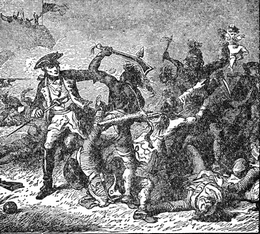
LITTLE TURTLE'S BATTLE-AXE
General St. Clair left the nation's capitol with the words of the President ringing in his ears, and went directly to Fort Washington, arriving there in the middle of May, 1791. Various causes delayed the campaign, which began early in September, one year after the defeat of General Harmar. Fort Hamilton was built on the Miami in the country of Turtle, and Fort Jefferson forty miles farther on. Leaving a garrison in each, the army advanced, but its strength was reduced by desertions to fourteen hundred effectives. The militia were dissatisfied and unreliable.
Early in November, St. Clair made his camp on high ground, within fifteen miles of the Miami villages. The militia, to the number of three hundred, crossed a creek and halted on the first elevation a quarter of a mile beyond the main body. While forming their camp, Little Turtle attacked them. The militia immediately broke in a wild panic. Without attempting any fight, most of them flung away their guns, the warriors at their heels, and cutting them down as they ran. The Indians pursued them all the way to the main body and then attacked it. The soldiers fought heroically, and drove back their enemies several times, but the charges were repeated under the direction of the Turtle, with a boldness rarely shown by his race. The end of it all was another crushing disaster, in which the troops lost thirty-eight officers and about eight hundred men. Many of the wounded suffered shocking barbarities. Thus, out of a total of fourteen hundred, nearly seventy per cent. were slain or disabled.
In this woful affair, the opposing forces were equal—the Indians being perhaps a trifle the greater in number—and the credit of the victory by the red men is therefore the more marked. The horde was commanded by Little Turtle, and although there is no way of knowing his loss, it was certainly less than that of the whites. Years afterward, the chief declared that only nine of his warriors were killed, but the number was probably fifty or sixty.
Nothing could have been more complete than the panic of the soldiers. General Butler, second in command, was killed; the camp and artillery were abandoned, because not a horse was left alive to draw off the cannon, and the panting fugitives continued to throw away their guns and accoutrements long after the pursuit ceased. They did not halt until they reached Fort Jefferson, twenty-nine miles from the scene of the massacre.
Personally no one could have shown more bravery than General St. Clair. His clothing was pierced eight times by bullets, three horses were killed under him, and he strove with all the power and authority at his command to check the flight and rally the troops; but terrified men are as uncontrollable as so many thirsting buffaloes in their rush for water.
Washington was of a serene temperament, and very rarely did he give way to anger. We know, however, of two occasions in which his rage overmastered him. One of these was at Monmouth Court House, on that flaming day in June, 1778, when he came face to face with General Charles Lee, leading a retreat of a part of the patriot forces, and the other was when the news reached him of the disaster to St. Clair and his army. He stormed up and down his room, his passion so terrible, that none of his attendants dare address him.
"Right there!" he thundered, pointing at a chair, "he sat, and the last words I said to him were a warning against the very thing that has happened; there can be no excuse for such atrocious, horrible blundering."
One of the noblest attributes of the noblest of men was his disposition to do right, and to be just to every one. When the tempest of emotion had passed, and his natural calm returned, he added:
"I will not condemn him too harshly until I have heard his story from his own lips."
In due time, St. Clair presented himself before Washington, timid and fearful as to his reception. He was quickly set at ease, however, and the President kindly but earnestly questioned him. Despite the bad light in which the officer appeared, he had something to say in his own defence, and was entitled to a hearing. The regulars in his command were reliable, but most of the militia proved themselves worse[154] than useless, for the example of their panic, which no one could check, had its disastrous effect upon their braver comrades as well.
Washington, however, made sure that the next general sent to the West was one who would not repeat the blunders of the others. He named that daring veteran "Mad Anthony" Wayne, and no officer could surpass him in the qualities required to overcome the hostiles, who had grown bolder than ever.
General Wayne began his campaign with the resolution to do the work thoroughly. He was eager to meet the hostiles, but was too wise to do so until every preparation was made. After entering the Indian country he did not neglect the slightest precaution. In the autumn of 1793, he built Fort Recovery on the site of St. Clair's defeat, followed by the erection of Fort Defiance, at the junction of the Miami and the Au Glaize. The next summer he began his march with two thousand regulars and eleven hundred mounted Kentucky militia. He entered the hostile section by a new and roundabout route, hoping to deceive Little Turtle as to his real line of march, but that wily chief was not misled.
Despite his fighting mood, Wayne did not give up hope of securing peace without a battle with the Indians. He thought that when they knew of the strong force marching against them, they would see the folly of resisting it. Learning that the redskins were in camp near the rapids of the Miami, he decided to send a messenger to them with peace proposals.
Now, while the office of a messenger to a civilized army brings no personal danger, it is otherwise when he visits an Indian force. Those people have no respect for a flag of truce, and have an unpleasant habit of killing visitors whom[155] they do not like, when they present themselves with the white emblem fluttering over their heads. Among Wayne's troops was a man who had lived for several years with the Indians, who could speak their language, and knew all about them. When Wayne asked him to take his message to Little Turtle, he shook his head. He said the Indians were set upon war, that no argument or proposals could change that determination, and the chances were a hundred to one that they would kill him as soon as he appeared before them.
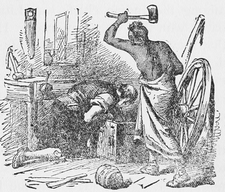
THE UNSUSPECTING
WHEELWRIGHT
Wayne told him he might have any escort he chose, and that he would hold eight prisoners then in his hands, as hostages. He was to warn the chiefs that if they did any harm to the messenger, or if he did not return to Wayne at the end of three days, every one of the eight captives would be put to death at once.
The soldier finally consented to go, taking one man and a squaw with him as his companions, instead of an armed escort, which he knew would be very dangerous to him. He started one afternoon and reached the Indian camp the next morning, without his approach being observed, until he was among the hostiles. The moment he displayed his flag, and said he was a messenger, he was met on all sides with shouts, "Kill him! Kill the spy!" He explained matters in their own language, and instead of slaying him, the redskins told him he was their prisoner. He then gave the rest of his message, telling about[156] the letter of General Wayne, and warning them that if he was held longer than the next day, all the eight Indians in camp would be put to death at sunset.
This language had its effect. The visitor was set free after a few hours, and took back a message to General Wayne to the effect that if he would stay where he was for ten days, and would then send the same messenger to them, they would treat with him, but if he made any advance with his army, he would be attacked.
It should be said in this place that the only wise one among the Indian chiefs was Little Turtle. He opposed a battle with the American army. He reminded his associates that they had made many attempts to surprise the commander, but had not done so in a single instance; there were more "Long Knives" than had ever before entered their country, and they were led by their best general. In such circumstances, defeat at their hands was more than likely.
One of the chiefs replied to these wise words by taunting the Turtle with cowardice. The leader was enraged enough to brain the sachem, but he mastered his anger, and said nothing; it was decided that the battle should be given on the morrow and he was ready.
On his way to camp, the messenger met General Wayne and his army. That officer was so certain of the answer to his message that he decided not to wait any longer. He reached the Miami Rapids on August 18th, near the enemy's camp, and threw up fortifications. He was on the march again by the 20th, using all care against surprise. A few hours later, his advance scouts were fired upon, and Wayne formed his line of battle and advanced in three columns.
Little Turtle had posted his men with his usual skill, a rocky bank of the river being on the left, and had cut down[157] a large number of trees in his front, so as to make the cavalry useless. The warriors were formed in three lines, within supporting distance of one another, with a front fully a mile and a half long.
It is not necessary to describe this historical battle, which was conducted with such skill by Wayne that in a brief time the whole force of hostiles were routed in headlong flight. They were shot down and pursued until they took refuge under the guns of Fort Maumee, a British post. When the commandant of this warned Wayne to cease slaying the warriors, the American replied that he would do as he saw fit, and, if the British officer was not pleased therewith, he might bring his garrison outside and he would serve them in the same way as the Indians.
Seven tribes were represented in this battle,—the Shawnoes, Miamis, Pottawatomies, Chippewas, Delawares, Ottawas and Senecas. One year later, the treaty of Greenville was signed, twelve tribes giving their written assent to its terms, which ceded twenty-five thousand square miles of territory to the United States in the present States of Indiana and Michigan, in addition to sixteen tracts, including lands and forts. The Indians who agreed to this cession were paid twenty thousand dollars in presents and promised an annual allowance of ten thousand dollars. The peace thus secured lasted, with slight interruption, until the breaking out of the war of 1812, some years after.
Among those who accepted the treaty of Greenville were Little Turtle and Tecumseh (of whom we shall learn presently). They never left any doubt of the sincerity of their pledge, though the Turtle, like Red Jacket and others, raised a good deal of enmity among his own people, because of the respect the whites showed him, and the self-evident fact that the[158] sachem had more wisdom than any or all of their own chiefs. The Americans built him a comfortable home on Eel River, a few miles from Fort Wayne, and he made his home there. He showed such a preference for civilized life that our Indian agents were ordered to see that he never wanted for anything necessary to his comfort. He made several visits to Philadelphia, and to Washington, when the seat of the national government was removed to the latter city. In every case he received marked attention, and became a general favorite. The famous French traveler and scholar, Count Volney, sought out Little Turtle in Philadelphia, in 1797, and with the aid given him by the chief, formed a vocabulary of his language, copies of which are still well preserved.
Volney, who became quite fond of Little Turtle, asked him one day why he did not live in Philadelphia, instead of in his cabin on the Wabash. The chief replied: "I admit that on the whole you have the advantage over us, but here I am deaf and dumb. I do not talk your language; I can neither hear nor make myself heard. When I walk through the streets, I see every person in his shop employed at something. One makes shoes, another makes hats, a third sells cloth, and every one lives by his labor. I say to myself, 'Which of all these things can you do?' Not one. I can make a bow or an arrow, catch fish, kill game and go to war; but none of these is of any good here. To learn what is done here would require a long time. Old age comes on; I should be a piece of furniture useless to my nation, useless to the whites, and useless to myself; I must return to my own country."
WARRIOR AND KNIGHT
BUCKONGAHELAS, THE DELAWARE CHIEF

MONG the leading chiefs who took part in the decisive battle at Maumee Rapids, when General Wayne smashed the Indian confederacy, was Buckongahelas, a sachem of the Delaware tribe. He was an orator of ability and a military leader of skill, with a humanity not often shown by one of his race. He took the side of the British until his attitude was changed by a certain incident, soon to be related.
No missionaries toiled more faithfully among the red men than the Moravians, who suffered every kind of persecution, facing privations, trials, tortures, and the most painful of deaths in order to bring the children of the forest to a knowledge of the true faith. They met with much success, and founded a number of missions, where scores of red men proved by their lives their belief in the religion professed by the white men. Thriving settlements were founded by the Moravian missionaries. These people, by their gentle ways, often suffered from their own race, while others, like Buckongahelas, treated them with kindness and respect, even though he did not believe in their principles.
It cannot be denied that our forefathers on the frontier were often frightfully misused by the Indians. Many atrocities were too dreadful to be described. The winter of 1782[160] was marked by a number of cruelties at the hands of the Sandusky Indians. In revenge, a band of nearly a hundred men gathered on the frontier of Pennsylvania, and, led by Colonel David Williamson, marched against the Christian Indians at Gnadenhutten, a missionary settlement. Friendly messengers were sent to warn them of their danger, but, sad to say, they arrived too late. In March, 1782, ninety-six men, women and children, while singing hymns and praying, were slain by this company of white men, not one of whom ever was punished for the crime.
A few months before this awful crime, two Christian Indians of Gnadenhutten went out into the woods to look for some estray horses. They had not gone far, when they met a chieftain at the head of eighty warriors. The Christians were made prisoners without explanation. Then the band took a roundabout course through the forest, until near the settlement, when they went into a secret camp, keeping the captives lest they should escape and give the alarm. Early the next morning, the town was surrounded so that none could leave, and the leader of the war party shouted to the frightened people that they must give up their chief and principal councillors, either alive or dead.
The leader named the men he wanted and was determined to have, but the Christians replied that it chanced that every one was absent, having gone to Pittsburg some days before. The visitors searched each house from attic to cellar, and found they had been told the truth. Then the chief ordered that the leading men remaining in Gnadenhutten and Salem should appear before him to hear what he had to say. When they had assembled, he spoke:
"Friends, listen to what I say. You see a great and powerful nation divided. The father (the King) has called[161] on his Indian children to help him in punishing his children, the Americans, who have become stubborn and will not obey him. Friends, often has the father been obliged to settle and make amends for the wrongs and mischiefs done to us, by his evil children, yet these children do not grow any better! They remain the same and will remain the same so long as there is left any land of which they can rob us. Listen to me and hear what I have to say. I have come to bid you arise and go with me to a safe place. I will take you to a country (the Miami), where your fields shall yield you abundant crops and where your cattle shall find plenty of pasture; where there is much game; where your women and children, together with yourselves, will live in peace and safety; where no Long Knife" (meaning the sword and bayonet of the colonists) "shall ever disturb you. Nay; I will live between you and them, and not even allow them to frighten you. There you can worship your God without fear. Here where you live you cannot do so. Think on what I have said to you and believe that if you stay where you are, very soon the Long Knives will talk to you with fine words, and while they are talking they will kill you all."
The chief who uttered this warning was Buckongahelas, and he was honest in his wish to take the gentle people with him, to where they would escape the danger to which he knew they were exposed. They thanked him but declined his offer, believing that their principles and goodly lives were so well known that no one would harm them. The chief then asked that those who wished to leave should be allowed to do so. This was agreed to and a few left. How true the words of the good man were was proven soon after when the massacre named occurred!
Buckongahelas next went to Salem. The following account is by Heckewelder who was present:
"The Christian Indians," said the chieftain, "were a happy people and he would never trouble them on account of their not joining in the war. Indeed they could not with propriety join in wars, without first renouncing praying," (meaning Christianity). "And every Indian, or body of Indians, had a right to chose for themselves, whom they should serve. For him, he had hired himself to his father, the king of England, for the purpose of fighting his refractory children, the Long Knives, whilst his friends and relations, the Christian Indians, had hired themselves to the Great Spirit, solely for the purpose of performing prayers," (meaning attending to religion). "He added that both were right in their way, though both employments could not be connected together. And only yesterday they were told, while at Gnadenhutten, that God had instructed all Christian people to love their enemies, and even to pray for them. These words, he said, were written in the large book that contained the words and commandments of God! Now, how would it appear, were we to compel our friends, who love and pray for their enemies to fight against them—compel them to act contrary to what they believe to be right—force them to do that by which they would incur the displeasure of the Great Spirit, and bring his wrath upon them? It would be as wrong in him to compel the Christian Indians to quit praying and to turn out and kill people, as it would be in them to compel him to lay fighting aside, and turn to praying only."
Did Indian or white man ever utter nobler sentiments? Buckongahelas was not a Christian, and he claimed the right belonging to every one, to think for himself and to form his own judgment, but he did that which many, who may profess[163] the same principles, are unable to do; he accepted just as fully the right of every one else to do the same. He complimented the principles of the Christians, for he respected them and, as has been already said, his only wish was to befriend and save them from the cruelty of the white man. He knew better than they that no trust could be placed in those of the other race, and sad indeed was it for the Moravian Christians that they did not act upon his own counsel.
Before entering Salem, the chief made all his warriors leave their guns behind, so as not to alarm their hosts.
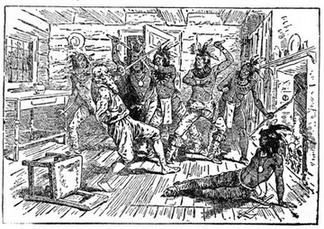
A FIGHT AT ODDS
When ready to leave, he turned and addressed the assembled Christians thanking them for their hospitality, and assuring them that they could always depend upon his steadfast friendship.
The following incident will illustrate a peculiar phase of the character of this remarkable man:
One of the most noted scouts connected with Colonel Brodhead's army, and afterward with Harmar, St. Clair and Wayne, was an Irishman named Murphy. He was a rollicking fellow, with all the wit and waggery of his people, brave to the last degree, and a master of woodcraft. Some of the exploits with which he is credited sound incredible. No Indian could follow a shadowy trail through the woods more truly, and few were his equal in resources and quickness to see the right[164] thing to do in a crisis. He was tall, bony, homely of feature, with a shock of fiery red hair and a freckled countenance. With many, his greatest gift was his fleetness of foot. In all the races in which he engaged he never met his superior. Simon Kenton, who, in his prime, could run like a deer, said Murphy was able to lead every one else.
This point became well known to the Indians, and many of them put forth their utmost efforts to capture him. Aware of the valuable help he gave to the whites, they would have given much to lay hands on him. He had slain and scalped (sad to say that barbarous practice was not confined to the red men) some of their most noted warriors, and there would have been general rejoicing among all the tribes could the means be found to check his destroying career.
Well, disaster came to Murphy at last. He had a hard fight with three Delawares, one summer afternoon, in the depths of the wilderness. He shot one, wounded the second, and would have gotten away as usual, but at the critical moment, a score of bucks arrived on the spot, surrounded and made him prisoner. When the grinning captors closed about him, Murphy threw up his hands and asked them to be considerate as he had wrenched his ankle, and was barely able to stand. His appeal was useless, for they beat him unmercifully, and forced him to keep pace with them, though he limped so badly that at times he actually hopped forward on one foot. But the plucky fellow gritted his teeth, bore their blows unflinchingly, and, seemingly more dead than alive, finally reached the Delaware villages, where his coming caused great excitement and rejoicing.
It was early in the afternoon, and a discussion immediately took place as to how the prize should be disposed of.[165] The majority favored burning him at the stake; but Buckongahelas had stopped that inhuman practice, and would not listen to anything of the kind. Other savage pleasantries were suggested, all of which the chief vetoed, in several cases being backed by some of the leaders. Finally, some one proposed that the captive should run the gauntlet.
The grim fiendishness of this will be understood when the lameness of poor Murphy is remembered. All through the talk, he was standing in the background on one foot, his rugged face twitching with the pain he could not keep back. Buckongahelas would have interfered, had he not known that it was useless. There was a point beyond which he could not hold his warriors. He had denied them their favorite pastime, and even he could not say that they should be robbed of every form of amusement. There was not a warrior among the howling throng who did not know the scout who had wrought them so much evil, and upon whom they had tried so long to lay hands. The chieftain nodded his consent to their proposal.
Murphy was familiar enough with the Delaware tongue to understand the decision that had been reached. He was too sensible to protest and silently nerved himself for the dreaded ordeal soon to come.
The Delawares made their preparations with the enthusiasm of so many boys, while those who were not to take part chuckled with delight. The persecutors formed in two rows, facing each other, with hardly a dozen feet of space between. In each row were twenty-eight warriors and squaws, separated by slightly less distance. The arrangement was meant to give each one just enough room to swing his or her arms with freedom.
Thus, as will be seen, Murphy was doomed to run over[166] a path nearly a hundred yards in length, and between two rows of persecutors, all eagerly waiting for him to come nigh enough for them to reach him with the clubs in their itching hands. They had laid their guns aside, and every one was armed with a heavy stick, which he meant to bring down with a vicious energy that would hurl the poor fellow to the ground, if the implement once reached its mark.
Behind these rows of exultant redskins were grouped the other members of the tribe, to the extent of several hundred. Barbarous as were the warriors, the squaws were worse, if that was possible, and the dancing children were as eager as their elders to see the white man pounded to death.
One of the Delawares took Murphy by the arm and led him to the head of the line. He limped so heavily that he barely touched the ground with the tip of one foot. He was seen to shut his lips and shake his head, as if to force back his suffering and to brace himself for the trial before him. But he did not utter a word; it was useless.
At the head of the line on his right, was stationed a warrior whom he recognized as one of his captors and his chief persecutor. He was large and inclined to corpulency, but his painted face was ugly to the last degree. He had struck the captive on the way to the village, and had subjected him to many indignities. Now he took a place which gave him the first chance to reach the helpless prisoner, and there can be no doubt that he meant to leave no work to be done by the others in the lines.
Murphy looked down the long path, and, like many situations of danger, spat on his palms and rubbed them together, as if the action gave more nerve and strength to him. All were waiting, shifting about and toying with their clubs, impatient for the amusement to open. Buckongahelas[167] stood several rods to the rear of one of the lines, well beyond it, watching proceedings. He did not add to the turmoil, but with his arms folded over his massive chest, studied the prisoner, regarding whom he held a singular suspicion which he kept to himself.
Suddenly Murphy gathered his energies for the test. He leaned forward with his left foot advanced, and most of his weight resting on it, after the manner of the professional runner. This largely relieved the other ankle of the weight of his body. With his arms crooked at the elbows and held close to his sides, he suddenly lowered his head and shot forward as if propelled from a cannon.
The instant he did so, the suspicion of Buckongahelas became certainty. All trace of lameness vanished! Both legs were as sound as ever, and had been from the first.
But Hercules himself could not have run the length of those lines, between the rows of tormentors, and Murphy had never a thought of trying anything of the kind. With a quick turn to the right, and, when going at the height of his great speed, the top of his head struck his chief tormentor in the stomach, with an impact like that of a catapult. The life was almost knocked from his body, as he went over on his back, his moccasins kicking the air. Like a cat, Murphy leaped over the form, and with a burst of his wonderful fleetness, dashed for the nearest point in the woods.
This took him towards the spot where Buckongahelas was standing. The chief could have headed him off without trouble, but, instead of doing so, he stepped aside to make way for him. The confusion caused by the captive's break for freedom gave him the very chance needed. Among the spectators were many who had guns in their hands and several fired wildly at the fugitive, but the majority of the men who[168] formed the double line, sped after him, with a view of recapture, and the carrying out of their amusement so suddenly interrupted by his escape.
In a few seconds, Murphy was among the trees and going with the speed of the wind. It was impossible to gain a fair shot at him, when it was seen that he was rapidly increasing the distance between him and his pursuers. Sooner than would be supposed, he was beyond danger, and the next day rejoined his friends.
Some years later, when peace had come to the frontier, Murphy and Buckongahelas met at one of the forts, and, in the course of their talk, the incident just told was recalled. Both laughed over the remembrance, and the chief told the scout that he suspected from the first that his lameness was a pretence, and he thought it strange that none of the warriors shared his belief.
"I was glad when you got away," said the Delaware.
"I observed that ye stepped aside to give me room to pass, without losing any time in doing the same," said the grinning Irishman; "I knowed ye was my friend, which is why I headed toward yersilf."
When the league of Indians was defeated by General Wayne at Maumee Rapids, they fled for refuge to the British post near at hand. The commandant had promised them that, if they were repelled, he would give them shelter. But Wayne frightened him, and he closed the gates against the fugitives, and allowed many to be cut down.
Buckongahelas was so angered by this breach of faith that his principles changed. He refused longer to trust the English, for whom he had bravely fought, became the warm friend of the Americans, and urged his countrymen to do the same. He had all the qualifications of a great hero.
ADVENTURES OF BRANDT, THE HALF-BREED
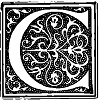
OLONEL JOSEPH BRANDT, whose Indian name was Thayendenaga, was a chieftain of the Mohawk tribe. He was in fact a half-breed, who lived and acted so like the red men that few are aware of his mongrel blood. He was born about 1745, and was placed by Sir William Johnson in a school at Lebanon, Connecticut, where he received a fair education. On the eve of the Revolution, he went to England, was presented to King George III. and attracted much notice. A peculiar trait of Brandt was that he always managed to draw much attention to himself. He formed a strong liking for the English, and made up his mind to do all he could for them in the war that was about to open. He was given a colonel's commission in the British army on the frontiers, and soon after returned to America to link his name with some of the most shameful events in the West. Associated with Brandt were two Tories who were worse miscreants than he; these were John Butler and Walter his son, who lived a few miles from Johnstown, in New York, which was the home of Brandt.
Brandt acted as the secretary of Colonel Guy Johnson, son-in-law of Sir William Johnson, who died in 1774. When Guy Johnson, alarmed for his own safety, fled to Canada, Brandt and the two Butlers went with him. There, where[170] they were safe, they hatched their plots for injuring the Americans. Brandt soon fell out with Johnson, and he and the Butlers returned to New York.
In order clearly to understand the events that follow, we must glance at the status of the struggle of the colonies for independence. England formed a plan in 1777, for crushing the uprising by means of the most formidable campaign that had yet been set on foot. This was to send Burgoyne, with his large army from Canada, and open communication between that province and the city of New York, thereby cutting off New England from the rest of the colonies. If this plan could be carried out, Burgoyne's powerful army would be forced like a stupendous wedge between the two sections, and a fatal blow given to the struggle for liberty.
This campaign provided for the advance of Burgoyne to Albany, where he was to meet a large force sent up the Hudson from New York. This is not the place to describe the failure of the important movement, ending in the capture of Burgoyne and his whole army.
A part of this great scheme was that Colonel Barry St. Leger was to go up the St. Lawrence to Lake Ontario, and thence to Albany by the Mohawk River. His command was composed mostly of Tories and Indians, and Brandt and the Butlers were with him. Early in June, Brandt gathered his Mohawks together and made ready to strike a blow for the English. General Nicholas Herkimer in command of the Tryon County militia, was ordered to check Brandt. He set out to relieve Fort Stanwix (also called Fort Schuyler), which was besieged by a large number of British, Canadians, Tories and Indians. Most of these marched to meet Herkimer, of whose approach they had learned.
While marching in loose order through the woods at[171] Oriskany, near Utica, Herkimer's militia were ambushed by the Tories and Indians. They were thrown into a panic and a large number shot down. A bullet killed Herkimer's horse and mortally wounded him. He propped himself on the ground with his back against a tree, lit his pipe and continued to give orders. The reports of the guns of a body of troops that had hurried out of the fort to the relief of the militia, alarmed the Indians who fled, the Tories quickly following them. General Herkimer was carried to his home, where he soon died from the effects of the wound.
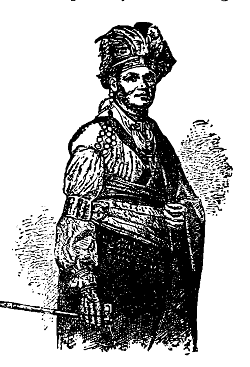
COLONEL JOSEPH BRANDT
The relief of Fort Stanwix was brought about by a curious piece of strategy. Schuyler, in command at the time of the campaign against Burgoyne, could hardly spare a man, and yet, unless relief was sent, the fort must fall. His officers opposed, for the reason named, and the angry Schuyler asked for some leader to volunteer. Benedict Arnold promptly offered, and at the head of eight hundred men, hastened toward the endangered post. Brave as was Arnold, he could not shut his eyes to the fact that his force could not compare in number with the Tories and Indians, and was more likely to fail than to succeed.
Reaching German Flats he found that one of the prisoners held by the Americans was a half-witted Tory, who had been condemned to death for some fault. He was hardly responsible for his acts, but was scared almost to death, and his mother was in an agony of distress over his fate. She sank on her knees before Arnold and prayed him to save her[172] son. The officer consented on the single condition that the youth should do a certain thing for him. The joyous mother and boy declared that he had only to tell them what it was and it should be done.
"It is simple," explained Arnold, "you and a friendly Oneida Indian are to go to the camp of St. Leger and make him believe my force is twice as great as his, and that if he waits where he is, I shall kill them all."
The youth eagerly said he would do all that was required, and the plan was soon formed. Several bullets were fired through his clothes, and he dashed off as fast as he could speed through the woods. When he reached the enemy's camp a few miles away, he was so exhausted that he could hardly stand. Asked to explain what it all meant, he said he had just escaped from the Americans by the narrowest means possible, and as proof he showed the many bullet holes in his clothing.
Hardly was this explanation made when the Oneida ran in from another direction, with the same startling story. "The Americans are like the leaves on the trees," he said; "They will soon be here!"
It was enough. The terrified Indians broke in a wild flight for safer quarters, despite the efforts of their officers to check them. Inasmuch as they made up most of the force of the besiegers, the soldiers had nothing to do but follow them and thus the siege of Fort Stanwix was raised.
It seems strange that it did not occur to the underwitted Tory that, after reaching the camp of the besiegers, he might as well have told the truth, since he was beyond the reach of Arnold; but that officer probably gave him such a scare that it took him a long time to get over it. And it is likely the American commander played upon his fears regarding the safety of his mother, in case he betrayed his trust.
The next event in which Brandt figures is the tragedy at Wyoming, which occurred in the following July. Congress had been warned that a large force was gathering at Niagara for the purpose of desolating the frontiers of New York, Pennsylvania and Virginia, but that body had so much other business on hand it gave no attention to the appeal.
In the month of July, 1778, a Tory and Indian force to the number of sixteen hundred, marched against the lovely settlement.
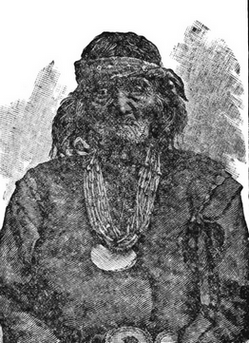
AN OLD CHRISTIAN INDIAN
The people took refuge in a structure known as "Forty Fort," while the old men, boys, and a few veteran soldiers, who were home on furlough, ranged themselves for action. Although the invaders were three times as numerous as the patriots, the latter had a fair chance of success in an open fight, for they were quite well armed, were led by good officers, and had the strongest inspiration that can come to men placed in their situation; they were about to fight, not for themselves alone, but for their wives and children. Before the opening of the battle, strong spirits were distributed among the defenders, and truth compels us to say that a number indulged too freely,—so much so that it helped in the defeat of the patriots. They were steadily gaining ground when an order was misunderstood and confusion followed. At that critical moment, the Indians made a charge, hopeless panic followed, and the historical Wyoming massacre began. Under a solemn pledge that no one should be harmed, the fort was surrendered:[174] nearly all the garrison, as well as the women and children, perished by the tomahawk.
Some of the settlers were too wise to trust their lives to the plighted word of a Tory or Indian, and plunged into the forests on their way to the settlements of the Upper Delaware. Many sank down and died in the dismal solitudes which have ever since borne the name of the "Shades of Death." A few succeeded in reaching Stroudsburg and other points, but the awful woe suffered by Wyoming in the early days of July, 1778, will give the place a sad distinction so long as the history of our country is chronicled.
It was only four months later, that a body of seven hundred, most of whom were under Brandt, set out for Cherry Valley. Colonel Ichabod Alden was in command of this post, and was blamable for what followed. He was warned of the approach of Brandt and his men, and the settlers asked for shelter in the fort. He replied that he did not believe the danger was serious, and would send out scouts that would keep him informed of the movements of the enemy. The principal of these scouts found the November weather so chilly, that, after going a little way they kindled a fire, lay down and went to sleep. Brandt's scouts were drawn to the spot by the light, and captured every one of the men, who were compelled to give exact information of the fort and settlement. In the cold mist of the morning the enemy approached the post. Among the first victims was Colonel Alden, who was quartered outside the fort. The latter repelled several attacks, and the assailants took their departure with about forty prisoners, while fully as many had been put to death or mortally wounded.
When peace came and the independence of the United States was secured, Colonel Brandt did what he could to[175] prevent hostilities by the Indians on the southern and western frontier. Much trouble resulted from the failure properly to fix the boundary between the United States and the Indian tribes. Brandt urged making the Ohio and the Muskingum such boundary, and, declared that, unless it was done, the Indians would go to war. He even said he would join them, but this must have been in the nature of intimidation, for though the red men took up the hatchet again, Brandt was at no time with them.
The king of England did not forget the services of his ally. He gave him a fine tract of land on the western side of Lake Ontario, where he made his home and lived after the English fashion. He had married a half-breed woman in the winter of 1779, by whom he had several children. She remained more of an Indian, however, than a white woman, and refused to conform to civilized life. After her husband's death (November 24, 1807), she removed to Grand River and spent the remainder of her days in a wigwam, taking some of her children with her and leaving others at their former home.
A remarkable piece of work by Brandt was the translation of John's Gospel and the Book of Common Prayer into the Mohawk language. Copies of these works may be found in the library of Harvard University.
ADVENTURES OF TECUMSEH, THE SHAWANOE

ECUMSEH was an eloquent orator and a brilliant military leader. He was appointed a brigadier-general in the British army, and few or none of the English officers were his equal in all that goes to make a successful leader of men. He was a knightly foe, who never, so far as known, permitted the abuse of prisoners. Whilst yet in his teens and on the war path, he fought against the cruel practice and more than once forcibly prevented it. No man kept a promise more honorably than he. He was brave and self-restrained, and in many respects set an example for those who professed higher things.
A remarkable fact about Tecumseh is that he was born one of triplets. This was probably in 1770, his birthplace being on the Scioto, not far from Chillicothe. He is authority for the statement that his mother was a Cherokee, who was taken prisoner during the war between that tribe and the Shawanoes and was adopted by the latter. His father was one of the foremost warriors among his people.
When the flatboats going down the Ohio had to run the gauntlet of the hostile Indians along the shores, the youthful Tecumseh was among those who were most active in the attacks. It is said that while he was still a boy, he saw the torture of a white prisoner at the hands of his captors, and[177] was so shocked that he vowed he would do all he could to break up the practice, and, as has been said, he kept his pledge.
Tecumseh was one of the hardest fighters at the battle of Maumee Rapids, where General Wayne smashed the Indian confederacy. He accepted the treaty of Greenville, and honorably lived up to its terms. Settling among his people, he became a hunter and fisherman, and seemed to think no more of warfare. The unharmed white man who met him in the depths of the forest had no cause to fear. Instead, the Shawanoe was ready to give him the help he might need, and would share the last pound of venison with him. The story is told of Tecumseh that he once entered the home of a white friend to spend the evening, the two having formed a liking for each other. The caller found another white man present—a stranger, to whom he was introduced. He gravely shook hands with the visitor, and sat down in a chair on the other side of the broad hearth.
Tecumseh must have been noted as a warrior even at that time, for when his name was spoken, the other caller plainly showed his fear. It was evident that he was much afraid of the Shawanoe, who was quick to note the fact. With a meaning glance at his friend, he began talking about the imaginary scalping expeditions from which he had just returned, and said he was anxious to add a few more ghastly trophies to his collection. This was kept up until the poor fellow was pale and trembling with fright. Then Tecumseh walked over to his chair, placed his hand on his shoulder and said, soothingly:
"Don't be scared; Tecumseh will not hurt you." The hearty laugh of the host showed the visitor that he had been made the victim of a joke by the Shawanoe chieftain.
Tecumseh must have given a great deal of thought, while still a youth, to his race and to the many injustices which it[178] had suffered. The problem to him was as to how these wrongs could be righted, or rather, since many of them were beyond righting, how further wrongs could be stopped. Never did any one see more clearly than he, the full force of the truth that in union lies strength. The Indians were weak because, instead of uniting, they fought one another, and thereby invited their conquest by the invaders of their country. How different would have been the story had the red men stood together when the first European crossed the ocean!
Now, it must not be thought that this native genius was nerved by the ambition of Philip or Pontiac. The former dreamed of and strove for a confederacy that would destroy all the English settlements. When, at that distant day, these settlements were scattered and weak, he had good reason to believe he would succeed. As we know, his plot was sprung before he was ready, and Philip could not bring about the full union of the New England tribes.
The day for doing that had passed when the chieftain of the Ottawas came upon the stage of action. He tried to bring about an alliance with France and to destroy the western posts that had been turned over to England. He did capture a number, but failed because France would have nothing to do with him or his plans.
Tecumseh also believed that when war broke out between England and the United States, the former had a good chance of success. This belief he shared with the mother country herself, else she never would have begun the struggle. The Shawanoe knew that if the western tribes united to resist the Americans, they would get much better terms than if they fought separately. He bent all his energies to that difficult task.
History proves that when such an effort is set on foot, war is certain to follow. Such is the record of the past, for[179] if union is strength, it must give that confidence which results in deeds. The activity of Tecumseh made Governor Harrison and the authorities in the West uneasy. What could be finer than the retort of the redoubtable Shawanoe, when it was asked of him:
"Why are you trying to bring about a union of the different Indian tribes?"
"For the same reason that you have brought about a union of your colonies; we never objected to that, and what business is it of yours what we do among ourselves?
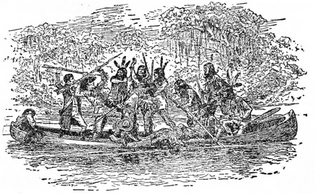
A RIVER ENCOUNTER
Besides, it is necessary that we should unite to save us from the scoundrels among the white men."
We have no authentic record of the opinion expressed in reply to these memorable words. Probably none was given.
The bringing together in friendship of the tribes who had been enemies for centuries was a herculean task. It called into play all the matchless abilities of Tecumseh. Even he could not succeed in every instance, though it is certain none could have done so well.
In this work, the Shawanoe chieftain used the two most powerful levers that can affect the Indian mind—superstition and eloquence. The Prophet was the spokesman of the former. He claimed to have had direct dealings with the Great Spirit and to utter his will. Many of his professions[180] were grotesque to the last degree, and it may have been for that very reason that he gained hundreds of converts. Like some of the false prophets of modern days, he drew a mongrel set of disciples around him, who could be neither shamed nor argued out of their foolishness.
Tecumseh professed to believe in the supernatural power of his brother, and his example brought over many others. The master hand of the warrior could be seen in the labors of The Prophet, who began preaching about 1804. Some of his doctrines were good. He insisted that there must be a complete change in the conduct of the red children of the Great Spirit. They must quit copying the dress and manner of the white people; especially must they give up the use of ardent spirits, and all Indians must show by their lives that they were brothers and sisters. While there was impressive truth in his words about the long, happy, peaceful lives of their forefathers, such a reminder did not improve their feelings toward those who had brought about this change.
Tecumseh gave strong support to his brother in his mission. In some cases chiefs who opposed them were put to death, generally on the charge of witchcraft; in other instances, their power was taken away. While The Prophet gave all his efforts to preaching the new gospel, Tecumseh himself made a tour among the different tribes, winning many warriors and leaders to his views. That he had the encouragement of the English in this crusade cannot be denied. They saw as clearly as he that war was coming.
Now as to the real dispute between Tecumseh and the Americans; the Shawanoe insisted that no single tribe had the legal or moral right to sell to our government the lands which it might chance to occupy. Such right lay in all the tribes, whose consent was necessary in order to make[181] such sale binding. Several large cessions had already been made and treaties signed in which these terms had been violated. Tecumseh declared that these lands belonged to the whole Indian population, that such fact should be admitted by our government and the sales cancelled, the transfer still depending upon the consent of all the tribes.
It will be seen that this view could not be accepted by our government, for if it were, there never could be any real sales, and everything that had already taken place in that respect went for nothing.
Governor Harrison of Vincennes had a delicate and hard task before him. It has been said that his government would never allow him to accept the views of Tecumseh, and he saw the time had come for plain words. He reminded the chieftain that when the white people came to take this continent, they found the Miamis occupying all the country on the Wabash, but the Shawanoes at that time lived in Georgia, from which they were driven by the Creeks. The lands had been bought from the Miamis, who were the first and real owners of it, and the only ones having a clear right to sell the lands. It was untrue to say that all the Indian tribes formed one nation, for if such had been the intention of the Great Spirit he would have given them the same language to speak, instead of so many different ones. The Miamis had thought it best for their interest to sell a part of their lands, thereby securing another annuity and the Shawanoes had no right to come from a distant country and compel the Miamis to do as the Shawanoes wished them to do.
The governor having taken his seat, the interpreter began explaining to Tecumseh what had been said by him. Before he was through, and as soon as the chieftain caught the gist of the words, he sprang to his feet in anger and exclaimed,[182] "It is false!" His warriors leaped from the grass on which they had been sitting, and grasped their weapons. Believing he was about to be attacked, the governor drew his sword and stood ready to defend himself. He was surrounded by more of his own people than there were Indians present, but they were unarmed. They snatched up stones and clubs ready to make the best fight they could. Major Floyd, standing near the governor drew his dirk, and a Methodist minister ran to the governor's house, and, catching up a gun, placed himself in the doorway to defend the family. One of the chiefs close to the governor, cocked his pistol which he had already primed, saying, that Tecumseh had threatened his life, because he signed the treaty and sale of the disputed land. Governor Harrison told the interpreter to say to Tecumseh that he would have nothing more to do with him. He was ordered to leave, but, instead of doing so, he remained in the neighborhood with his chiefs until the next morning, when he sent an apology to the executive, pledging himself that nothing of the kind should occur again. Harrison accepted his explanation, and met him a second time. On this occasion, Tecumseh was dignified and courteous, but it was evident that he was under strong emotion. Having no new argument to offer, the plain question was put to him whether he intended to oppose the survey of the newly-bought territory. He replied that he would cling to the old boundary. The leading chiefs with him rose to their feet, one after another, and gave notice that they would stand by Tecumseh. The governor promised the Shawanoe that his words should be told to the President, but he added that it would be useless, for the land would never be given up.
Governor Harrison, hoping he could do something in a[183] private talk, went with his interpreter to the tent of Tecumseh. He was received kindly and the two conversed for a long time, each strongly urging his views upon the other. The chieftain said he would much rather be a friend of the United States than an enemy. He knew that war between them and England would soon come, and he would greatly prefer to fight on the side of the Americans. He would do so, if his views regarding the lands were accepted.
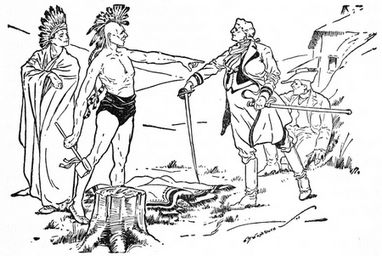
TECUMSEH DEFIES GENERAL HARRISON
"I repeat what I said that that will never be done, and it would be wrong in me to hold out any hope for you in that respect," replied the governor.
"Well, as the great chief in Washington is to settle the question, I hope the Great Spirit will put some sense in his head. But he is so far off he will never be harmed by the war; he can sit down and feast and drink his wine while you and I fight it out."
"Is it your determination to make war if your terms are refused?"
"It is," replied Tecumseh; "nor will I give rest to my feet, till I have united all the red men in a like resolution."
The unusual fact about these talks was the frankness with which Tecumseh gave his views. He never made the slightest effort to hide his intentions, nor would he utter any promise which he did not mean to keep. He and Governor Harrison had several interviews, but it was impossible to shake the resolution of the Shawanoe. At one of the councils, he turned to rest himself, after finishing his speech, when he saw that no chair had been placed for him. Apologizing, the governor had one hastily brought, and as it was handed to the chief, the interpreter said: "Your father requests you to take a chair."
"My father," replied Tecumseh, with dignity, "the sun is my father, and the earth is my mother; I will repose on her bosom," and he seated himself upon the ground.
Harrison finally gave over his attempt to change the views or resolution of Tecumseh. Before the final parting of the two, the governor said to him:
"We shall soon be fighting each other; a good many will be killed on both sides, and there will be much suffering; I ask you to agree with me, Tecumseh, that there shall be no capturing of women and children by your warriors, and no torture or ill treatment of such men as you may take prisoners."
"Tecumseh has never ill treated his prisoners, nor has it ever been done in his presence," was the answer of the chieftain; "why do you ask me to do that which you know I will be sure to do without the asking."
Harrison pleaded his anxiety, and thanked Tecumseh for his pledge, which he knew would be strictly kept.
The declaration of the chief that he would give his feet no rest until he united all the red men was carried out. His travels and labors were prodigious. During the year 1811, he visited numerous tribes west of the Mississippi, and about Lakes Superior and Huron, not once, but several times, thrilling all by his eloquence and winning hundreds to his side. Regarding this tour, the following incident is authentic, though since it must have been a coincidence, it certainly was one of the most remarkable ever known.
While making one of his appeals to the Creeks, Tecumseh lost patience with their coldness. He shouted angrily:
"When I go back to my people, I will stamp the ground and the earth shall shake!"
It was just about time for the chieftain to reach his towns to the north, when the New Madrid earthquake took place, the severest phenomenon of the kind which up to that time our country had ever known. When the Creeks felt the ground rocking under their feet, they ran from their tepees shouting in terror:
"Tecumseh has got home! Tecumseh has got home!"
While the chieftain was absent on this tour, The Prophet was busy with his magic. He made the wildest prophecies, and hundreds of his superstitious countrymen believed that, as he claimed, he was in direct communion with the Great Spirit. The Prophet told them the Indians should soon be given back their former hunting grounds and all the pale faces should be driven into the sea. Fired by these promises, the fanatical warriors gathered around The Prophet and began committing outrages upon the whites. The government could not refuse to go to the protection of its citizens. A small force of regulars and militia was brought together at Vincennes, the capital, and placed under the command of[186] Governor Harrison, who was given a free hand to do all he might think necessary.
No better officer could have been chosen. United to his fine military talent, he had a thorough knowledge of Indian character, and was safe against any such blunders as had been committed by St. Clair, Harmar and others. Marching into the Indian country, he encamped, early in November, within nine miles of The Prophet's town. The redskins did not disturb him, and he pushed three miles further. He sent forward his interpreters, but the Indians refused to have anything to do with them.
Certain that treachery was intended, the governor moved with the utmost care. He was pleased when he was not attacked on the way to the town, which he reached without the firing of a shot. Still the Indians refused to receive or make any replies to the calls of his interpreters. Harrison formed his line of battle and was advancing upon the town, when several messengers of The Prophet appeared. An interview was held, in which they asked that no attack should be made before the morrow, when the principal chiefs would visit Harrison with proposals for peace.
That officer was not deceived. The men slept on their arms, the guards were strengthened, and nothing was neglected that could prevent surprise. Every officer and private knew just what to do, in the event of an attack, and it maybe doubted whether there was a soldier in the army who did not feel sure such an attack would soon be made.
Just as it was growing light, on the morning of November 7, 1811, the Indians made a furious charge upon the camp. The fight was one of the most desperate in the history of our frontier. But for the preparation, the coolness and bravery, and the fine generalship of commander and officers, all the force[187] would have been destroyed. As it was, the Americans lost sixty-two killed and one hundred and twenty-five wounded, among whom were some of the bravest officers. The loss of the Indians was about one hundred and fifty. They were routed and driven headlong from the field.
While the battle was raging, The Prophet stood on a neighboring hill, keeping up his frenzied performance.
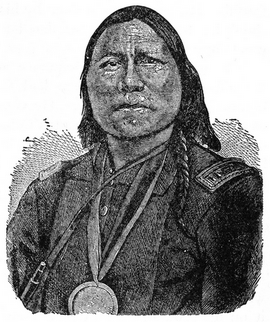
A SHAWANOE CHIEFTAIN
He shouted to the warriors that victory was certain, and none of the enemy's bullets could hurt them. Told that his people were falling, he urged the others to keep on fighting, declared all would come out right and sang his war songs louder than ever; but when the final overthrow took place, The Prophet led in the flight. He was soon left alone by his men, who lost faith in his claims. Two days later, Governor Harrison laid the town and surrounding settlements in ashes, sending the hostiles scurrying in every direction, after which he returned to Vincennes.
The victory of Harrison could not have been more complete. It won the admiration of his countrymen, and had more than anything else to do with his nomination and election to the presidency of the United States. Nearly thirty[188] years later, the cry of "Tippecanoe and Tyler too," swept the country like wildfire, and roused an ardor the like of which had never been seen before.
As we know, Tecumseh was absent on his "stumping tour" when the battle of Tippecanoe was fought. It was contrary to his orders, and overturned all his plans. When he came back and learned what had been done, his rage was fearful. He seized his brother by his long hair, and almost shook his head off, declaring that he deserved death and he was tempted to inflict it.
Tecumseh gave his eloquence and energies to rallying the different tribes, after they had fallen away through the blundering of The Prophet. He visited them all again, and won not hundreds but thousands to his standard. With these, he entered the service of the British when war broke out between England and our country. Hardly a battle took place in the West, down to the death of the Shawanoe, in which he did not act a creditable part. His military ability was so notable that he was made a brigadier general, and, as has been said, there was no white officer of that rank who was his superior, if indeed any one was his equal. When asked one day to give an idea of the face of the country through which they were marching, he took a piece of elm bark, laid it on the ground, with a heavy stone on each corner to hold it flat, and with the point of his hunting knife, traced a map, which the English engineers declared could not be surpassed by any of their number.
One day General Proctor was sitting on his horse calmly watching a number of Indians that were maltreating several American prisoners. Although claiming to be civilized and guided by the rules of honorable warfare, the commander smiled, as if the sight was as pleasing to him as to the dusky persecutors.
In the midst of the cruel pastime the sound of a galloping horse was heard, and the animal was reined up on his haunches within a few feet of the general. At the same instant Tecumseh leaped from his back to the ground, grasped the principal tormentor by the throat, hurled him backward a dozen feet, struck another a blow that almost fractured his skull, and with his face flaming with passion, whipped out his hunting knife, and shouted that he would kill the first one who laid hands on another prisoner.
Turning to General Proctor, he demanded with angry voice and flashing eyes:
"What do you mean by permitting such things?"
"Sir, your warriors cannot be restrained," was the reply.
With burning scorn, Tecumseh said:
"You are not fit to command; go home and put on petticoats!"
Commodore Perry won his great victory over the British fleet on Lake Erie, September 10, 1813. Had he failed, it was the plan of the British army in the West to invade Ohio. If he won, General Harrison meant to invade Canada. As soon as he learned of the victory, told to him by Perry's message, "We have met the enemy and they are ours," he lost no time in invading Canada. He embarked at Sandusky Bay, September 27, and landed near Malden. Proctor retreated to Sandwich with the Americans closely pressing him. Instead of giving battle, the British commander kept up his retreat to the Thames.
Tecumseh, with a large force of Indians, was with Proctor. He was angered over the cowardice of the British officer. The chief saw many good positions given up without a struggle, and did not hide his disgust. Going to the general he protested.
"Our fleet has gone out," said the Shawanoe; "we know they have fought; we have heard the great guns, but we know nothing of what has happened to our father with one arm. (This was an allusion to Commodore Barclay, who went into the battle of Lake Erie with only one arm and came out without that.) Our ships have gone one way, and we are much astonished to see our father tying up everything and preparing to run the other way, without letting his red children know what his intentions are. You always told us you would never draw your feet off British ground. But now, father, we see you are drawing back, and we are sorry to see our father doing so without seeing the enemy. We must compare our father's conduct to a fat dog, that carries its tail upon its back, but when frightened, it drops it between its legs and runs off.
"Father, listen!—The Americans have not yet defeated us by land, neither are we sure they have done so by water; we therefore wish to remain here and fight our enemy, should they make their appearance. If they defeat us, we will then retreat with our father.
"Father!—You have got the arms and ammunition which our great father sent for his red children. If you have any idea of going away, give them to us and you may go and welcome. Our lives are in the hands of the Great Spirit. We are determined to defend our lands, and if it be his will, we wish to leave our bones upon them."
This speech referred to the retreat from Malden. Tecumseh reluctantly gave his assent to a still further withdrawal, but he warned Proctor that if he did not stop retreating and fight, he would call off his warriors and have nothing to do with him. The British leader was forced to give battle at the Moravian Town on the Thames. He and Tecumseh chose[191] the battle ground, the Shawanoe having the most to say about it. He showed Proctor how he could protect one flank with the river and the other with a swamp.
The battle of the Thames October 5, was another brilliant victory for the Americans under General Harrison. Proctor and a few others escaped by starting early in their flight. With this exception, the whole British force became prisoners.

KIT CARSON
Tecumseh never thought of retreating or surrendering, but, at the head of his fifteen hundred warriors, he held the American army in check for a long time. He soon received a severe wound in the arm, but paid no attention to it, and fought on with as much bravery as ever. His wonderful voice rose above the roar of battle, and nerved the arms of his warriors, but suddenly it ceased, and it quickly became known that Tecumseh had fallen. A panic instantly spread among the Indians, who broke into headlong flight in all directions.
A strange dispute raged for years as to who it was that killed Tecumseh. Although it was never settled, it is generally believed that it was Colonel Richard M. Johnson of Kentucky, afterward Vice-President of the United States. While the identity of Tecumseh's slayer may be uncertain, there is no doubt that, whoever he was, he closed the career of the "greatest American Indian that ever lived."
CHIEF OF THE CREEK CONFEDERACY
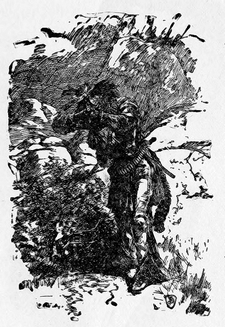
LIVING at the time of Tecumseh, was a chief of strong ability, though inferior to the great Shawanoe in the nobler qualities. He was Weatherford, the Creek leader, whose name recalls one of the most terrible incidents in the history of the frontier.
It will be remembered that Tecumseh visited the Creeks, and when his burning appeals failed to rouse his listeners as he expected, he declared in his impatience that when he got home he would stamp the ground and it should shake. His return was followed by the historical New Madrid earthquake.
But for the fatal blunder of The Prophet, in bringing on the battle of Tippecanoe, while Tecumseh was absent, the Creeks as a body would have joined the confederacy. As it was, the younger warriors were swept off their feet by the Shawanoe's eloquence, though many of the elders urged them to keep out of the war that was sure to bring suffering and disaster to them.
Withal, in the face of bad traits, Weatherford was brave, eloquent and tactful. He required a strong occasion to rouse[193] him to bursts of oratory, and he was too wise to cheapen his gifts by speaking too often. His wisdom was the admiration of the old, while his vices made him the idol of the young and vicious. He was tall, straight, well-proportioned, with pleasing features; and the impression of any one looking upon him for the first time was favorable. He was avaricious and took for himself one of the finest tracts of land belonging to the tribe among whom he made his home. To sum up, he was the corner-stone of the Creek confederacy.
The Creeks and Seminoles, living within the limits of Florida, began a series of outrages against the white settlements at the opening of the War of 1812. Numerous runaway slaves took refuge in the swamps and morasses where they were welcomed by the Indians and were safe against pursuit and recovery by their former masters. These negroes intermarried with the Indians and the mongrel population was of the most degraded character. Their forays became so harassing, that the militia of the Southwest were called out, and marched against the savages. A large number of the inhabitants fled to Fort Mimms, a stockade on Lake Tonsas, Alabama. Knowing the peril to which these refugees were exposed, Governor Claiborne sent one hundred and seventy-five volunteers to its defence, and placed them under the command of Major Beasley. In his anxiety the governor visited the fort, and tried to impress Beasley with the imminence of the danger to which all were exposed.
"I look upon it as almost certain you will be attacked; Weatherford is one of the most daring leaders the Indians have ever had; his spies are watching you at this moment, as they have been doing from the first; nothing that you can do will escape him; if you give him the first encouragement, he will massacre everyone of you."
The officer assured the governor that he would be vigilant, but the fear of the executive was not removed. Fort Early was the farthest advanced in the Indian country, and he went thither with his escort to impress the same watchfulness upon the garrison there. While on the road, he wrote a letter to Major Beasley, warning him again of his peril, and reminding him that the life of every one of the women and children who had fled to the post was in his keeping.
One would suppose that after these appeals Major Beasley, figuratively speaking, never would have closed his eyes; but that officer was one of those who, when placed in a critical situation, seem to be smitten with blindness. Several negroes had been sent up the Alabama by their masters to procure corn. The Indians captured three, but one managed to escape. He ran to Fort Mimms, and told the Major that the Indians were marching against the post. The commandant looked calmly at the panting servant, the picture of terror, and smiled. He couldn't believe the negro had any cause for his panic. The next day several white men came to the fort with word that a large force of Indians were in the neighborhood, and every sign pointed to an attack. The officer was not so foolish as wholly to disregard this news, though he could not believe the danger was serious. That which followed seems incredible. Three negroes, a day or two later, hurried to the post, and told Major Beasley that, while looking for cattle in the woods, they had met a large party of prowling Indians. The officer sent out several scouts to look for them. They came back saying they had not found a single redskin, whereupon, Major Beasley had the principal negro whipped for spreading falsehoods. The next day the same negro discovered a large number of warriors stealing through the woods toward the fort. Not caring to earn another reward such as[195] he had received for telling the truth in the former instance, he wisely decided to hold his peace.
Not long afterward, Weatherford, at the head of fifteen hundred warriors, crossed an open field and came within thirty paces of the fort on a bright summer morning (August 30, 1813), before his approach was discovered. To complete the criminal idiocy of the commandant and his officers, the gates were open and unguarded. Before they could be closed, the horde swarmed through and attacked the garrison. Of the defenders, nearly one-half were old men, women and children.
The soldiers fought as men do who know no quarter will be given, and who are aware of the awful fate of those dependent upon them, in case of the failure to repel their assailants. It is not necessary to dwell upon the particulars of this dreadful affair. Every officer died fighting. The women and children took refuge in the blockhouse, to which the Creeks applied the torch, and all perished. The wounded Major Beasley was one of those who breathed his last in the flames. Nearly three hundred were in Fort Mimms, of whom only seventeen escaped, and most of these were wounded.
This massacre sent a thrill of horror and wrath throughout the country. Tennessee set aside three hundred thousand dollars, and placed five thousand men under command of General Andrew Jackson, with orders to punish the Creeks. It is worth noting that "Old Hickory" at that time was not fully recovered from a wound received in a duel, and among the volunteers under him were the eccentric Davy Crockett, killed more than twenty years later at the Alamo, and "Sam" Houston, who won the independence of Texas at San Jacinto, shortly after the death of Crockett, and his comrades at the fort in San Antonio.
On the march, Jackson's men rebelled because they were[196] reduced to the point of starvation, and saw no hope of getting a mouthful of food if they remained. The stern old hero of New Orleans crushed the mutiny, and lived upon acorns, and sometimes was unable to obtain even these. It was not the only time that that remarkable man, single-handed, conquered a thousand men by the strength of his will.
It is not our province to give a history of the Creek War, marked as it was by many shocking occurrences on both sides. White men, in the intense anger caused by the outrages of the Indians, often equalled them in cruelty. There were numerous skirmishes, battles and defeats of the hostiles, whose spirits, however, remained unbroken, until the delivery of the crushing blow at the Great Horseshoe Bend of the Tallapoosa River, in the State of Alabama. The Creeks had been beaten so many times that they determined to make their final stand at this point, and to stake everything on a single battle. Their camp was fortified with a skill that recalled the fort of the Narragansetts during King Philip's war, it being so built that the only way to carry it was by storm. Behind these rough intrenchments crouched a thousand warriors, ready to fight to the death.
General Jackson had been eager from the first to get the hostiles together like this, so that when he struck his blow, it should be effective. So long as only a few were slain here and there, no real effect upon the campaign itself followed. He was as resolute to reach the hostiles as they were to have him come within reach of them.
Early on the forenoon of March 27, 1814, General Coffee, with a force of regulars, and a number of friendly Indians, crossed the river two miles below the encampment and stationed his men so as to cut off the retreat of the enemy. A number of spies paddled in canoes to the end of the bend, and fired several buildings. Pressing on, they attacked the breastworks, but did not make much of an impression.
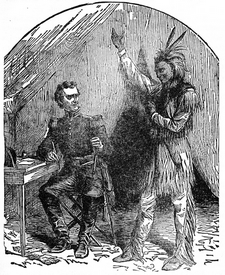
WEATHERFORD AND GENERAL JACKSON
[198] Meanwhile, the rest of the American army was impatiently awaiting their opportunity. When Jackson, as eager as they, had placed his troops in position, he sent forward a flag of truce, with an interpreter to summon Weatherford to surrender. The moment the flag came within range, the Creeks fired upon it. The bearer hurried back with a report of his inhospitable reception.
The battle which opened lasted for five hours, and was fought with the fierceness that marked the great Swamp Fight in New England, more than a hundred years before. The triumph of the Americans was overwhelming. They had twenty-five killed and more than a hundred wounded, while the loss of the Creeks reached the fearful total of six hundred, besides two hundred and fifty women and children prisoners. The blow was one of the most crushing ever delivered in the history of Indian warfare.
None of the Creeks was so blind as not to see that the only escape from utter destruction was by making peace on the best terms possible, with the whites. Chiefs and warriors began coming into the American camp and offering their submission. Whenever they did so, the eagle-eyed Jackson scanned each dusky face, and asked the name of the leader before him. He wanted to secure Weatherford, and left no doubt of his purpose to shoot him for the horrible crime of Fort Mimms. He was willing to accept the surrender of any and all chiefs, with the one exception of the arch-fiend, who had placed himself outside the pale of civilized warfare.
But Weatherford did not appear. He may have been too proud to surrender, but it is as likely he feared to put himself in the power of the stern leader of the Americans.[199] Afraid the Creek sachem would not appear, and determined to get him, Jackson told several chiefs that he would accept their submission, but, before doing so, they must prove their earnestness by bringing Weatherford to him, securely bound.
When these chiefs, at Jackson's command, went to Weatherford with the message, he replied:
"I shall never be delivered to him bound a captive."
Some time later General Jackson was busy with certain papers, when a tall, fine looking Indian stalked into his tent.
"I am Weatherford," said he; "I am the chief who commanded at Fort Mimms; I have come to ask peace for my people."
"I am surprised that you should appear in my presence," replied the general, studying the visitor from head to foot; "I know of your wicked conduct at Fort Mimms, for which you deserve death; my orders were that you should not be seen here until you were bound; had that been done, I should have known how to deal with you."
"You can still do that; am I not in your power? Can you not do with me as you choose? I am a soldier; I have done your people all the harm I could; I should have done them more harm, but I could not; I have fought you bravely, and if I had an army I should still fight you; I would contend to the last; but I cannot fight without warriors, for they have been taken from me. My people are gone; you have left but few of them; I can only weep for them that are gone."
Jackson was the man to admire boldness in another. His visitor had disarmed him by his bold surrender, knowing, as Jackson was sure he knew, his anger toward him. He looked admiringly at the tall, magnificent fellow and said:
"I will take no advantage over you, scoundrel though you are! If I should serve you as you ought to be served,[200] even your own people would say I did right. You showed no mercy to poor women and children at Fort Mimms, when they had not harmed a hair in the head of you or yours, and could not defend themselves. But, as I said, I will take no advantage over you. You may walk out of this camp unharmed; you may place yourself at the head of your war party and fight us; but I warn you that if you are captured, you shall receive no quarter. Your people can save themselves only by unconditional submission."
Standing erect, the chief looked into the face of the stern, military leader, and without a tremor, replied:
"You know it is safe to address such words to me. There was a time, not long ago, when I should have known how to answer you; once I had a choice, but there is none left to me now. There does not remain even to me a hope. I could once animate my warriors to battle, but I cannot animate the dead. My warriors can no longer hear the voice which has nerved their arms so many times. Their bones are scattered at Talladega, Tallushatches, Emuckfau, and Tohopeka (the Indian name of Horseshoe Bend).
"I have not surrendered myself without thought. While there was a single chance of success, I never left my post nor begged for peace, for I did not want it. Weatherford does not fear to meet any white man. But my people are gone, and my prayer is not for myself but for my nation. I look back with deep sorrow, and wish to avert deeper calamities that threaten to come upon my people. If I had been left to contend with the Georgia army, I should have raised my corn on one bank of the river, and fought them on the other. But your people have destroyed my nation. You are a brave man. I rely upon your generosity. You will exact no terms of a conquered people, but such as it is right they should[201] accede to. Whatever they may be, it would now be madness and folly to oppose them. If they are opposed, you shall find me among the sternest enforcers of obedience. Those who still hold out can be influenced by nothing but a mean spirit of revenge. To this they must not, and shall not sacrifice the last remnant of their country. You have told our nation where we might go and be safe. This is good talk, and they ought to listen to it. They shall listen to it!"
This fine speech produced the effect intended. General Jackson declined to accept Weatherford as a prisoner of war, and he strode out of the American camp as proudly as he had entered it, and kept the pledge made to his conqueror.
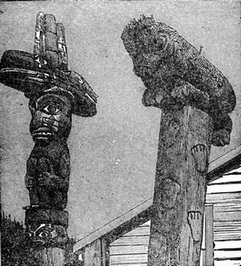
NORTHERN INDIAN TOTEM POLES
FIGHTING AGAINST FATE
BLACK HAWK AND HIS WAR
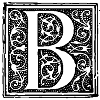
LACK HAWK was born on Rock River, in Illinois, about the year 1767. When only fifteen years old he took the scalp of an enemy and soon gained so much fame on the war path, that he became one of the foremost of leaders, and often headed parties of his people against other tribes. It was claimed by the majority of the chiefs and sachems of the Sacs and Foxes that the treaty made with Governor Harrison in 1804, by which their lands east of the Mississippi were sold, was executed on the part of the Indians by a few chiefs, who had no authority of the nation to whom the act was unknown until some time later. When, therefore, the Americans built a fort on the Mississippi, the Indians were angry and tried to cut off the garrison.
When Illinois became a State, in 1818, hundreds of emigrants flocked thither. They came so fast that their settlements surrounded the territory occupied by the Sacs and Foxes. Trouble is sure to come when such a state of affairs exists. The Indians looked upon the white people as intruders—as they certainly were—while the new comers were anxious to be rid of their unwelcome neighbors, and did all they could to make their situation uncomfortable. They thought that by[203] doing this, they would force the Indians to "pull up stakes" and go elsewhere. But the true owners stayed where they were. When they were absent on a hunt, the settlers tore down the fences and turned the Indians' cattle into their cornfields, whose crops were trampled and destroyed. In 1827, during another absence of the warriors and their families, some miscreants set fire to their village and nearly fifty houses were laid in ashes.
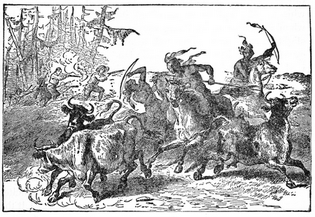
AN INDIAN CATTLE RAID
Two months after these events, General Atkinson entered the Winnebago country with a military force and captured the chief and six Winnebagoes who were thrown into prison until they could be tried. The chief died in jail. After a long time four were found guilty and two acquitted, the former being sentenced to be hanged. Black Hawk was accused of being one of the party who fired on the keel boats, but was set free[204] for lack of evidence. Not long afterward, when all danger was past, he confessed that he was guilty as charged.
Several shameful acts against the Indians were perpetrated by the whites about this time. In one instance several settlers, claiming that they had been ill-used, fell upon Black Hawk and beat him unmercifully. The indignity, added to other wrongs, led him to determine upon war against the whites. He had been promised help by other tribes, but when he called upon them, nearly all refused to give the slightest aid. He convinced Keokuk that he had made a great mistake in parting with the lands, and that chief promised to do what he could to get them back. Black Hawk said he would let the whites have all the valuable lead mines, on condition that they were allowed to stay in their village and till their cornfields, where, according to tradition, one of their villages had stood for nearly two centuries.
So sure were the Sacs that their wishes would be granted, that they went on their usual fall hunt in 1830. When they came back, they found that the whites had moved in, and taken possession of every wigwam and lodge. The Sacs were upon the banks of the Mississippi, without shelter for their squaws and children. No wonder that they felt the wrong was beyond bearing.
The chiefs decided to take possession of their village. The whites were alarmed when the blanketed warriors and their families stalked in among them and made themselves at home. It was evident that any attempt to oust the rightful owners would cause bloodshed; so the settlers said they would stay and work and plant in partnership. This was done, but the situation of the Indians was made almost intolerable. The whites took care that they had the best land, and they treated their dusky neighbors with brutal harshness,[205] insulting them on every pretext, and, in one instance at least, they beat a young man so badly that he died of his injuries. It was to be expected in some cases the Indians would give great provocation, but nothing could excuse the wholesale stealing of their village and land. The chiefs, knowing how closely they were watched, and that the intruders were anxious for an excuse for calling upon the authorities, told their people in no circumstances to be the first to commit a hostile act against the intruders.
The Sacs were notified that their lands had been sold, and they must not again set foot on the eastern side of the river. We have shown that they disregarded the warning, and Black Hawk and his band did not hesitate to declare they meant to stay. The settlers appealed to the governor of Illinois, who, asserting that the State had been invaded by hostile Indians, called out seven hundred militia to protect the citizens. He requested General Gaines, commanding the western department, to coöperate with him. That officer summoned a strong force of regulars and went to the region in dispute. Under date of June 2d, 1831, the general made the following interesting statement:
"I have visited the Rock River villages, with a view to ascertain the localities, and, as far as possible, the disposition of the Indians. They confirm me in the opinion I had previously formed, that, whatever may be their feelings of hostility, they are resolved to abstain from the use of their tomahawks and firearms except in self-defence. But I am resolved to abstain from firing a shot without some bloodshed, or some manifest attempt to shed blood, on the part of the Indians. I have already induced one-third of them to cross the Mississippi to their own land. The residue, however, say, as the friendly chiefs report, that they will never move; and what is[206] very uncommon, their women urge their hostile husbands to fight rather than to move and thus abandon their homes."
General Gaines awaited the arrival of the militia. They appeared about a week later. Knowing what was to be expected from them, if they were once let loose, the Indians immediately moved across the Mississippi, and the army took possession of the Sac village without the firing of a shot. A treaty was signed, but it was without permanent effect, for before the close of the year, both parties violated it.
Being in a starving condition, a number of Sacs secretly recrossed the river, and stole some of their own corn. Matters remained in an unsettled condition, and in the following spring, General Atkinson, at the head of a regiment of regulars, set out for the Upper Mississippi. At his approach Black Hawk and his party left their camp, and went up Rock River. He expected to be joined by the Pottawatomies, Winnebagoes and Kickapoos, but they wisely kept out of the fighting, when they knew a disastrous end was certain.
Black Hawk moved leisurely up stream, and on the way was overtaken by several expresses from General Atkinson, ordering him to return. In every instance the chief sent back a defiant answer, and kept on. Instead of pursuing, General Atkinson halted at Dixon's Ferry, and waited for the reinforcements that were on the way. He was pleased to find, however, that quite a strong military force had already arrived at the place before his advent.
Having decided upon a reconnaissance, Major Silliman at the head of two hundred and seventy men, moved cautiously toward the hostiles. Black Hawk sent three messengers with a flag of truce to invite the officer to a conference. Instead of accepting the invitation or respecting the flag, the major made prisoners of the bearers. Not understanding why[207] they did not return, Black Hawk sent five other messengers after them. They were fired upon and two killed, the others escaping by running. Thus the Sacs were receiving valuable lessons in civilized warfare.
As soon as the chief learned of the outrage, he prepared to ambush the advancing company, although their number was more than double that of the Indians. The effort succeeded so well, that the soldiers were driven back in disorderly flight with the loss of a dozen men.
The war having begun was carried on in the usual barbarous fashion of the border. The Sacs were too wise to meet the troops in open battle, but attacked exposed places, when there was no thought of their coming. Scores of dreadful outrages took place, and in more than one instance, the white men proved as cruel in their methods as the Indians themselves ever were.
The state of affairs grew so intolerable, that General Scott was ordered to the frontier with nine companies of artillery. The same number of companies were also sent thither from the Lakes, and two companies from another point. It was wise to launch a strong enough force against Black Hawk to make sure of crushing him and his hostiles. However, General Scott's companies were soon attacked by the cholera and terribly decimated.
It is interesting to record the names of two persons who figured in the Black Hawk War, on the side of the Americans. One was a tall, ungainly captain of Illinois, who was registered as Abraham Lincoln. The United States officer who mustered him and the soldiers into the service of the country was Jefferson Davis.
Black Hawk had gathered a thousand warriors, with whom he awaited General Atkinson at a point between Rock and[208] Wisconsin rivers. When he saw that the troops outnumbered his bucks almost two to one, he retreated, and, though General Atkinson strove hard, he could not bring the chief to a stand. Seeing that his force was too bulky to escape together, Black Hawk approached the Mississippi above the mouth of the Wisconsin. Most of the women and children went down the river in canoes. Several were drowned, and nearly all the others fell into the hands of the whites.
When the main body under Black Hawk reached the bank of the river, they were alarmed by the sight of the steamboat Warrior, which seemed to be waiting for them. Most of the Indians were in a starving condition, and the sufferings of the women and children were so pitiful that Black Hawk, seeing the hopelessness of keeping up the struggle, decided to surrender. He sent a body of his warriors to the edge of the stream, bearing a flag of truce. The troops were not wholly blamable for thinking this was a ruse to lure them to land, for the trick was used many times during our border troubles. Black Hawk always said he honestly meant to surrender. Be the truth as it may, the steamer opened with a six-pounder. More than a score of Indians were slain, besides a large number wounded, while not a man was killed on the steamboat.
In the latter part of July, General Atkinson, with sixteen hundred men, crossed to the north side of the Wisconsin at Helena, and pressed on with the purpose of hitting the Indian trail. He made a forced march, and, four nights later, an old Sac was met who told him the Indians had gone to the Mississippi which they meant to cross the next day. The horses and men were so tired that General Atkinson was forced to rest for several hours.
Before the Sacs were able to reach the river, they were[209] overtaken, and the fight that followed and lasted for several hours was more of a massacre than a battle. While the Americans lost only twenty-seven men, that of the Indians was ten times as great. Black Hawk escaped by the narrowest chance with the remnant of his force.
This battle was the finishing stroke to the Black Hawk War. The Sioux and Winnebagoes kept continually bringing in prisoners, and General Atkinson asked Keokuk to send messengers to demand the surrender of Black Hawk and the remainder of the hostiles, and to deliver the chief, alive or dead, within an appointed time.
Black Hawk, with a few friends, took refuge at the Winnebago village of Prairie la Cross. Worn out, depressed and hopeless, he told the chief he was ready to surrender to the whites, and they were welcome to do what they chose with him; he would not make the least objection if they decided to put him to death. The squaws made him a dress of white deerskin, and clothed in this, he walked voluntarily to Prairie du Chien, with the two Winnebagoes who had been sent after him. About midday, August 27, 1833, he and his companion, better known as The Prophet (no relative of course of Tecumseh), walked into Prairie du Chien Fort and gave themselves up as prisoners of war.
When Black Hawk surrendered to the commander, he waited for one of his companions to speak, and gave close attention to the reply of the officer. All eyes being turned upon the chieftain, he said:
"You have taken me prisoner with all my warriors. I am much grieved, for I expected, if I did not defeat you, to hold out much longer, and give you more trouble before I surrendered. I tried hard to bring you into ambush, but your last general understands Indian fighting. The first one was[210] not so wise. When I saw I could not beat you by Indian fighting, I determined to rush on you, and fight you face to face. I fought hard. But your guns were well aimed. The bullets flew like birds in the air, and whizzed by our ears like the wind through the trees in winter.
"Black Hawk is a true Indian, and disdains to cry like a woman. He feels for his wife, his children and friends. He does not care for himself. He cares for his nation and the Indians. They will suffer. He laments their fate. The white men do not scalp the dead; but they do worse—they poison the heart; it is not pure with them. His countrymen will not be scalped, but they will, in a few years, become like the white men, so that you cannot trust them, and there must be, as in the white settlements, nearly as many officers as men, to take care of them and keep them in order.
"Farewell, my nation! Black Hawk tried to save you and avenge your wrongs. He drank the blood of some of the whites. He has been taken prisoner, and his plans are stopped. He can do no more. He is near his end. His sun is setting, and he will rise no more. Farewell to Black Hawk!"
There was no thought, however, of putting the chief or any of his companions to death. The prisoners and their guard were taken by steamboat down the river to Jefferson Barracks. Black Hawk, The Prophet, eleven head men or chiefs of the Sacs and Foxes, and some fifty warriors composed the party. Upon their arrival all were put in irons. By a treaty made with the Sacs and Foxes, a short time after, they ceded five million acres of land, containing much valuable lead deposits, to the United States. At the same time, the Winnebagoes surrendered four millions six hundred thousand acres of equally good land to our government. In[211] addition to an annuity for thirty years, the payment of the debts of the tribes, and a supply of provisions, a reservation of forty square miles on the Iowa River was given to Keokuk and his band for their loyalty during the troubles now happily brought to an end. Black Hawk, his two sons, and seven of the principal warriors, were to be held as hostages at the pleasure of the President of the United States.
Black Hawk now entered upon the experience which gave him his real reputation as an orator. His war against the settlements had drawn more attention and raised more interest throughout the country than many wars of greater magnitude before or since, and, wherever he went, he was a notable personage. In the month of April, 1833, the chief and his companions arrived in Washington, and had an interview with President Jackson. Each had heard of the other, and the salutation of the chieftain when presented to the foremost citizen of the United States, was: "I am a man and you are another!"
Old Hickory received his visitor kindly, but, as was his custom, used plain words. He told him that a number of articles of dress which had been prepared would be speedily given to him, and the chief was at liberty to distribute them as he thought best. The President added that the party must leave at once for Fort Monroe, and be content to remain there until he gave them permission to return to their homes. Their stay would depend upon the conduct of their people. When the terms of the treaty had been complied with, and the distant warriors showed a friendly spirit, the chiefs and their friends would be set free. The President assured them that they need feel no uneasiness about their women and children, for they would be shielded from all harm at the hands of the Sioux and the Menominies. He meant to compel the[212] different tribes to live at peace with one another, and, when he became sure that everything would remain quiet, the prisoners would be sent to their homes.
It is worth noting that among all the curiosities shown to these visitors, they were more interested in the portraits of the Indian chiefs in the War Department than in anything else. They seemed never to weary of standing in front of the paintings, and gazing upon the features of those of their own race, whose fame had come down to them in tradition, and whose deeds and oratory had filled even civilized brethren with admiration for their heroic qualities.
The Indians arrived at Fort Monroe in the latter part of April. None was put in irons, and all were treated with kindness. Few indeed could feel any emotion other than sympathy for those men who had suffered so much from a people that claimed a higher civilization and professed the gentle teachings of Christianity. Although the cage in which they were kept was a gilded one, it was none the less a prison, and they sighed for the free air of the prairies and mountains. The welcome order arrived in about five weeks, and they left by steamboat for Baltimore. Naturally they attracted great interest at all points where they stopped, and their tour through the northern cities was, to use a common expression, an "ovation." We Americans are famous for our "speeches" and "addresses" which are ready on the slightest provocation. Most of those directed at Black Hawk were of a wishy-washy character, that could bear no comparison with the sturdy, sententious eloquence of the natural orator. The best one of the lot was made by Hon. John A. Graham, at a reception given to the red men in New York.
"Brothers," said he, "open your ears. You are brave men. You have fought like tigers, but in a bad cause. We[213] have conquered you. We are sorry, last year, that you raised the tomahawk against us; but we believe you did not know us then as you do now.
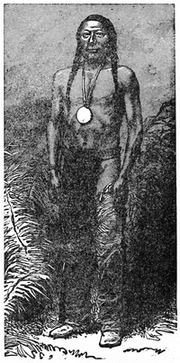
SHAWANOH,
THE UTE CHIEF
We think that in time to come, you will be wise, and that we shall be friends forever. You see that we are a great people, numerous as the flowers of the field, as the shells on the seashore, or the fish in the sea. We put one hand on the eastern, and, at the same time, the other on the western ocean. We all act together. Sometimes our great men talk loud and long at our council fires, but if you shed one drop of white men's blood, our young warriors, as thick as stars of the night, will leap on board our great boats, which fly on the waves, and over the lakes, swift as the eagle of the air, then penetrate the woods, make the big guns thunder, and the whole heavens red with the flames of the dwellings of their enemies.
"Brothers, the President made you a great talk. He has but one mouth. That one has sounded the sentiments of all the people. Listen to what he has said to you. Write it on your memories. It is good, very good.
"Black Hawk, take these jewels, a pair of topaz ear rings, beautifully set in gold, for your wife or daughter, as a token of friendship, keeping always in mind that women and children are the favorites of the Great Spirit. These jewels are from an old man, whose head is whitened by the snows of seventy winters; an old man, who has thrown down the bow, put off the sword, and now stands leaning on his staff, awaiting the command of the Great Spirit.
"Look around you; see all these mighty people; then go to your homes, and open your arms to receive your families. Tell them to bury the hatchet, to make bright the chain of friendship, to love the white men and to live in peace with them, as long as the rivers run into the sea, and the sun rises and sets. If you do so, you will be happy. You will then insure the prosperity of unborn generations of your tribes, who will go hand in hand with the sons of the white men, and all shall be blessed by the Great Spirit. Peace and happiness, by the blessing of the Great Spirit, attend you! Farewell!"
The grim countenance of the old chief showed the pleasure he felt, as the well-chosen words were interpreted to him. His mouth expanded into a smile, when the pretty present was handed to him, and he was told for whom it was intended.
"Brother," said he, in reply, "we like your talk. We will be friends. We like the white people; they are very kind to us. We shall not forget it. Your counsel is good; we shall attend to it. Your valuable present shall go to my squaw. It pleases me very much. We shall always be friends."
In the month of August, 1813, a peculiar battle was fought near Fort George, by several hundred volunteers and Indians, the latter supported by two hundred English regulars. The Americans surprised the British and Indian camp at daybreak, killed seventy-five and took a number of prisoners. The singular feature of the fight was that the Seneca Indians, who were with the Americans, decoyed their brethren on the British side into an ambush by a series of signals which the others thought were made by friends. Among the chiefs who led the warriors were Red Jacket, of whom we have learned, and Captain Pollard, whose Indian name was Karlundawana. He was now an aged chieftain of the Senecas, held in high respect not only by them, but by the whites, to whom he had always been a loyal friend.
Black Hawk arrived in Buffalo in the latter part of June, and on the afternoon of the next day, paid a visit to the Senecas, who had gathered in their council house to give them welcome. Captain Pollard was their spokesman, and taking the hand of Black Hawk, he welcomed in a few fitting words, telling him of the pleasure it gave him and his people to greet the great chief of the Sacs and Foxes. Then, with touching earnestness, he urged his visitors to go to their homes with peaceable minds toward the whites; to cultivate the earth, and to think no more of war, which was certain at all times to bring evil and suffering upon them.
Black Hawk's native sense, coupled with what he had seen for himself, of the resources and power of the United States, could not fail to convince him of the truth of the words of the Seneca chieftain. He meant what he said:
"Our aged brother of the Senecas, who has spoken to us, has spoken the words of a good and wise man. We are strangers to each other, though we have the same color, and[216] the same Great Spirit made us all, and gave us this country together. Brothers, we have seen how great a people the whites are. They are very rich and very strong. It is folly for us to fight with them. We shall go home with much knowledge. For myself, I shall advise my people to be quiet and live like good men. The advice which you gave us, brother, is very good, and we tell you now that we mean to walk the straight path in the future, and to content ourselves with what we have and with cultivating our lands."
A marked but perhaps natural change in the feelings of the white people showed itself as the Indians drew near Detroit, for they were then entering a section where the inhabitants could not forget the injuries they had suffered from these redskins. While they offered no violence, they scowled at them. Insulting remarks were made in their hearing, and several men, more impulsive than their fellows, burned Black Hawk and his companions in effigy.
It will be remembered that the Menominies and Winnebagoes had always been enemies of the Sacs and Foxes. They made savage war against them during the late hostilities, and it was a couple of Winnebagoes who brought the chief to the camp as a prisoner. From Green Bay, the route of the party was through the country of these people, and the danger of an attack by them was thought to be so great, that a strong guard of troops escorted the returning captives to Chicago, which at that time was little more than a frontier post.
Naturally, Black Hawk and his companions seemed depressed when they drew near the scene of the late stormy events in their lives. They saw the lands they loved in the possession of the invaders, and the homes that once had been theirs in ashes and ruins. But their dejection showed only in their faces. None uttered a word of complaint.
Fort Armstrong, on Rock Island, had been selected as the place where the Indians were to be made fully free, with liberty to go whither they chose and do what they pleased, so long as they did not injure the white people. When their old comrades came in with news of the families of those who had been separated so long from them, the spirits of all rose, and as the numerous presents were distributed, every one was happy, as might be expected.
The bitterest cup of which Black Hawk had to drink was now pressed to his lips. He and Keokuk had headed two warring factions of the Sacs. But for the aid given by the white men to his rival, Black Hawk was sure he would have triumphed; but that rival was more cunning than he, in that he took the side of those who were mightier than the two together. He had conquered, and was now the sole head of the Sac nation. Black Hawk must meet him, and submit to the crowning shame of all. There was no help for it.
Keokuk was absent on a buffalo hunt when Black Hawk reached Fort Armstrong, but he and a number of his warriors came in the following day. It did not add to Black Hawk's peace of mind to see his rival's breast covered with medals presented to him by the people who had despoiled both. But Keokuk could afford to be genial, and when he saw the other he advanced toward him.
"The Great Spirit has sent our brother back; let us shake hands in friendship."
Black Hawk silently returned the pressure, and looked in the face of Keokuk with a world of pathos in his gloomy features. As he still remained silent, too depressed to find words, Keokuk began asking him questions about his journey home. Then pipes were brought out, and all smoked and chatted for an hour or more. A more formal reception[218] took place on the morrow, when Keokuk returned and the grand council was held. There was some friction during the speaking, in which the commandant of the fort took part, but in the end all was made smooth, and Black Hawk finally left for his wigwam, with expressions of good will toward all, including the chief who had supplanted him.
Black Hawk died October 3, 1838, and his funeral was attended by hundreds of whites as well as Indians. He was buried at his request in a sitting posture, with his cane between his knees and grasped in his hands. His bones were stolen and found a year later in the possession of a surgeon of Quincy, Illinois. Governor Lucas of Iowa compelled their restoration to the friends of the dead chieftain.
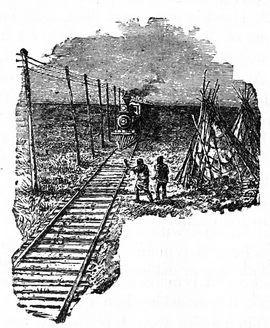
THE EARLY RAILROAD
IN INDIAN COUNTRY
THE HERO OF THE EVERGLADES
OSCEOLA AND THE SEMINOLE WAR

HE first treaty of Payne's Landing, which was signed in May, 1832, required the Seminoles to give up all their lands in Florida and to go west of the Mississippi. Only seven chiefs signed the treaty for their people, nearly all of whom were bitterly opposed to it. In their rage they killed two signers, and replaced them with a bitter enemy of the project. One of the indignant chiefs, when asked to give his views of the Treaty of Payne's Landing, strode to the table where the paper lay, hunting knife in hand, and exclaimed:
"That is my opinion!"
As he spoke, he brought down the knife with such force that the point passed through the paper and the top of the table on which it lay. The chief who did this startling thing was Osceola, the most famous leader of the Seminoles.
Did you ever hear of a war that was caused by the dispute over the meaning of a single pronoun? Such was the Seminole War, one of the most long drawn out and trying in the history of our country.
In the treaty referred to the removal of the tribe west of the Mississippi was made conditional. It said, "Should they be satisfied with the character of the country." Who was meant by "they?" President Jackson insisted that it was the seven[220] signers of the treaty (of whom two were killed), while the Seminoles were as firm in arguing that it referred to the whole tribe, whose opinion was to be formed after their agents had examined the region and made their report. Candor forces us to say that the red men had the better of the argument. Nor need it be denied that wrong pressure was brought to bear on the consenting chiefs. They were paid to misrepresent the wishes of their people, and, like their civilized brethren, were open to such base inducements.
As the time drew near for removal, it became clear that the Seminoles had no intention of going. General Wiley Thompson, the agent, called the real Indian chiefs together in October, 1834, and talked pointedly, impressing upon them the firm resolve of the government to make them obey the terms of the treaty. The dusky leaders were not scared, and told him the whole business was a fraud, and they would never accept it. The most outspoken of the chiefs was Osceola.
The conference having adjourned without result, was again called some time later, to hear the message of President Jackson, which was as direct as that sturdy man knew how to make his words. It was useless; the chiefs knew they had been cheated and remained defiant. What specially angered Osceola was that some of them, upon whom he had counted for support, were won over by the agent. This was done no doubt through the corrupt means that had convinced those who reported favorably on the country selected for their new homes beyond the Mississippi. He accused General Thompson of unfairness. The quarrel became so heated that the agent had Osceola put in irons. He was kept over night and a part of two days, finally gaining his release by promising General Thompson to sign the treaty, and use his influence to persuade the other chiefs to do the same.
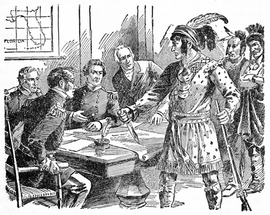
"THAT IS MY OPINION!"
Osceola was a half-breed, and this submission was simply a ruse to gain his freedom. His heart burned with rage, and he yearned for the chance to strike him who had put the crowning shame upon him. As might have been expected, the mongrel was hardly free of the camp when the outrages were renewed with more ferocity than ever. He killed one of the friendly chiefs, and then the Seminoles left all their towns, and took their families far into the gloomy swamps, beyond reach of the white men. The remarkable thing about this removal was that it was done with such skill that not the slightest sign showed where the fugitives had gone. The most skillful scouts of the American army tried for weeks to[222] trace their hiding place, but in not a single instance did they succeed. The feat was marvelous, nothing of the kind having been known before or since.
The government could no longer shut its eyes to the fact that it had a serious war on its hands. Unless protection was quickly given to the inhabitants of Florida, most of them would be massacred. The Seminoles were in dead earnest. General Clinch had charge of Fort King, and would have been doomed had not Major Dade reached him with reinforcements. On the day before Christmas, 1835, Dade, with one hundred men and eight officers, and a fieldpiece, marched against the hostiles. They advanced without hindrance for several days, when they were attacked by a large force of Indians and mongrels. Almost the first man to fall was Major Dade, but the other officers and men went down around him like tenpins. Under Captain Gardener, the Indians were finally repelled. It was known, however, that they would soon return, and the soldiers began hastily throwing up intrenchments. They were working desperately, when the Indians attacked again. Captain Gardener and many others were quickly killed. An attempt was made to bring the field-piece into action, but the Seminoles and negroes shot down every one who tried to serve it. When all the officers and two-thirds of the men had been slain, the ammunition of the survivors gave out, and the enemy rushed upon them. Only three men, by feigning death, escaped to the woods after the departure of the assailants.
The massacre of Major Dade and his command caused as profound emotion throughout the country as that of Custer and his men nearly a half century later.
It is believed, though it is not certain, that Osceola was the leader in this terrible affair. If so, he did another thing,[223] which, in its way, was equally startling. His enmity toward General Thompson, who had put him in irons, was intense. On the same day that the Dade massacre took place, Thompson was dining in a house within a short distance of Fort King. Seated at the table with him were several gentlemen; and, as the day was unusually warm, even for that latitude, the sashes were raised. In the midst of the meal, and while all were chatting and laughing, a volley came through the windows, and Osceola, at the head of a party of Seminoles, dashed into the room with tomahawks upraised. Five guests leaped out of the windows, and, running at headlong speed, reached the fort. The others made for a hummock near by, but were shot down on the way. Five in all, including General Thompson, were killed. The cook, a negro woman, hid behind a barrel and was not noticed. Those who fell were scalped, and Osceola, uttering his well-known defiant cry, made off with his companions, before the garrison at the fort could interfere.
The famous mongrel was the head and front of the rebellion. A force of seven hundred men, while crossing the Ouithlacoochee River, were attacked by him, and in an hour's fight, the Americans suffered a loss of sixty-three killed and wounded, though they inflicted a greater loss upon their assailants. During this struggle, Osceola was recognized many times by the soldiers. He wore a red belt and several long, stained eagle feathers in his hair. He would stand behind a tree, while reloading his rifle, after which he would step out into full view and fire with a deliberate aim. He was seen to level his gun at General Clinch several times, but fortunately that officer, who rashly exposed himself, was unharmed, though his clothing was pierced by one of the bullets of the Seminole chieftain.
In more than one instance a whole platoon fired at Osceola. The bark was seen to fly from the tree behind which he crouched, and once he was hit, but the wound was slight and did not bother him. Not until a squad of Americans were almost upon him, did he break for new cover, which he safely reached amid a storm of bullets whistling about him. The valor of the Americans saved them from a more fearful massacre than that of Major Dade's command.
It was a long time before the United States awoke to the difficult task on its hands, in bringing the Seminoles of Florida to terms. It seemed incredible that such an insignificant tribe could withstand the armed forces sent against them, but, by-and-by, more than one alarming fact came to light. Some of the Creeks of Georgia were stealing across the border and joining the hostiles; the stream of runaway slaves into those gloomy swamps increased in extent, and white desperadoes were doing the same thing, out of pure wantonness. Furthermore, the Seminoles had the great advantage of fully knowing the wild region. They could strike their lightning-like blows, and, if too closely pressed, take refuge in the dismal solitudes, whither the white soldiers could not follow them. The warriors and negroes were relieved of all anxiety about their families, for, as has been said, the veteran scouts could not find any of them in hiding. This left the husbands and sons at liberty to fight without thought for the safety of those dependent upon them.
As proof of the singular nature of the war, a few instances may be named. While the sloop Pilot was sailing up the Halifax River, it was attacked by Indians and would have been captured had the Seminoles been better marksmen. General Gaines, while marching from Tampa for the Indian country, with a large force was fired upon several times, and his[225] losses, which were not great, included a lieutenant of United States dragoons, while the general himself was wounded. It seemed as if the end of the war was put off in more than one instance, by some incident, slight of itself, but enough to cause misunderstanding. The whites had good reason to suspect the honesty of the Indians, and the latter were equally distrustful—and it must be confessed that ground was sometimes given for such distrust—of the honor of the white men. Thus early in March, 1836, Osceola headed a party which met one of General Gaines' staff officers under a flag of truce, and sent word that he and his warriors were tired of fighting, and wished to make peace. General Gaines made the unwise answer that it mattered nothing to him whether the hostiles wanted peace or not, a large force would soon be on the ground, and every Indian taken with arms in his hands would be shot. Osceola answered this message by saying that the chiefs would hold a council and send their reply before the close of the day. General Gaines told them that if they would stop fighting, go south of the Ouithlacoochee River, and come to a council when told to do so by the United States Commissioners, no harm should befall them.
Osceola agreed to this, but had hardly done so, when General Clinch, with several hundred armed men appeared near them. He had just arrived with supplies for the army, and had no other thought in mind, but Osceola believed the whole thing was a trap, and he and his warriors dashed into the woods in precipitous flight.
General Scott now took command in Florida. Fighting went on all through the summer, with no real advantage to either side. The Seminoles met with several successes, but when cool weather came again, no actual gain had been made by the Americans. Congress had to grant funds to save many[226] of the settlers from starvation. The whole country became impatient. Again and again, reports were printed that the final blow to the revolt had been given and peace was secured at last; but, hardly was this news read when it was followed by tidings of some startling success of the hostiles. If any of the readers of these pages are old enough to remember the Seminole War, they will recall those trying months and years with their "hope long deferred."
In September, 1836, a hatless man dashed into Jacksonville, with the report that his home, only seven miles away, was attacked by Indians. Volunteers hurried to the relief of the besieged, who, it was found, had been able to hold off their assailants; but several neighbors had been slain and their houses burned.
The Creeks and Seminoles, considered as tribes, had long been enemies. In fact, one cause of the anger of the latter over the Treaty of Payne's Landing was that it located the Seminoles near the former in Indian Territory. Two Creek chiefs with nearly a thousand warriors, now joined the United States forces. This was "fighting fire with fire," and many saw in it the certainty that the war must soon be brought to a close.
But the aimless fighting went on. The Seminoles showed marked valor, and succeeded in defeating the soldiers with severe losses. General Jessup having declined to take chief command in Florida, Governor Call did so, sure of soon forcing the Seminoles to sue for peace. He did all that was possible, and it amounted to nothing. Then the Secretary of War ordered General Jessup to take command again. He did so, and set the main army in motion, in January, 1837.
Great was the relief of that officer, when he received proposals of peace from the Seminoles. They kept straggling in[227] until, before the close of May, three thousand, among whom were many women and children, were gathered at one of the posts on Lake Monroe. Rations were issued to them, and among the chiefs was Osceola himself. More than that, he had eaten at the table of General Barney, and slept in his tent. He and all the chiefs said over and over again, that they had made up their minds to offer no further opposition to their removal to the new lands beyond the Mississippi. General Jessup breathed easier, for he was surely warranted in believing the end was at hand.
Twenty-four transports lay at Tampa to take away the Indians; but when the day came for them to embark, not a warrior, squaw or papoose was to be seen. All had taken to the woods again in obedience to the command of Osceola. It is hard to understand why he did this thing. Could it be in obedience to a waggish disposition? Did he wish to humiliate General Jessup, and through him the American army? Or did he seek a few good meals for his people, and more knowledge for himself of the plans of his enemies?
The whole war was not marked by a more provoking occurrence. A large party of the army was prostrated by sickness, and many had been given furlough, so that the strength of our forces in Florida was less than it had been for a long time. The Seminoles were greatly heartened by the trick, and became more daring than ever. The Territory of Florida was swept by a reign of terror, and the conquest of the redskins seemed farther off than ever.
What could be more natural than that General Jessup should be filled with hot resentment against Osceola, the cause of his humiliation? He resolved never to trust him again, and to relax no effort to kill or make him prisoner.
In the month of October, 1837, a message came to Fort[228] Peyton from Osceola to the effect that he was a short distance away and desired an interview with General Hernandez. He asked General Jessup to come out and talk with him. Instead of replying, that officer ordered one of his lieutenants to lure Osceola and his companions into the fort, and then make them prisoners. But the Seminole was too wily to be trapped and declined the invitation.
General Hernandez was now sent with two hundred and fifty men to hold a parley with the Seminoles, and the lieutenant was told to report whether the answers of the Indians were satisfactory. He came back after a short time with word that they were not. Jessup then ordered Major Ashby to seize the whole party, and this, too, despite the fact that the meeting was under a flag of truce.
It was so done. Seventy-five Indians, including Osceola, were made prisoners under the white flag, and without the firing of a gun, October 23, 1837, and the act was accepted by our government.
While the deed must ever remain a blot upon our honor, it is only fair to name some of the circumstances that were urged in excuse. The Seminoles themselves had repeatedly violated flags of truce, and were so treacherous that they had placed themselves outside the pale of civilized warfare. Furthermore, there was every reason to doubt the honesty of Osceola and his brother chiefs. They had made the same professions before, for no reason except to gain time. Finally, there was every cause to believe that his capture and that of the prominent leaders would either end, or hasten the end, of the war, and prevent the shedding of a great deal of innocent blood through the termination of hostilities.
These arguments named may be accepted as a partial excuse for the act of General Jessup, though it cannot be[229] justified. All the abuse he had suffered before was as nothing compared to that now heaped upon his head, but he had probably become used to that sort of thing, and believed that when peace speedily followed, those who blamed him would speak words of praise. But peace did not come, and the war dragged on for year after year.
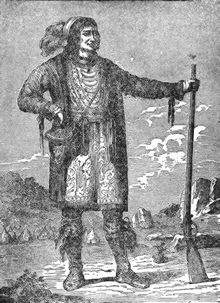
OSCEOLA, THE SEMINOLE
Osceola and his brother prisoners were sent to St. Augustine. The leader was soon after removed to Fort Moultrie, in Charleston harbor. His heart was broken, his spirit crushed, and he pined away and died within the following year. That he possessed courage and much strength of character cannot be denied, though in no respect was he the equal of several leaders of his race who have been named in these pages in the true stories that have been told.
We have said so much about the Seminole War that it is well to sum up its history. It has been stated that the capture of Osceola and many leading chiefs failed to bring the struggle to an end, as nearly every one believed it would do. General Zachary Taylor succeeded General Jessup in command,[230] and marched from Fort Gardener at the close of the year, 1837. "Rough and Ready" became President of the United States something more than ten years later, because of the fine record he made in our war with Mexico. In his biographies, much notice was given to the battle of Lake Okeechobee, which was fought on that body of water. It was the conflict of the war with the Seminoles. The issue more than once was doubtful, but in the end the Americans drove the enemy from the field. The loss of the soldiers was twenty-eight killed and a hundred and eleven wounded. Four companies had every officer, with one exception, killed.
The rough handling which the Indians received made them more wary than before about risking a battle in the open. The affrays were too numerous to be recorded. In one case, General Jessup was badly hurt, and had ten men killed and thirty wounded. Convinced by this time that it was impossible to drive out the Seminoles from Florida, he wrote to the Secretary of War advising that a certain part of the Territory be set apart for them. The Secretary gave no attention to the suggestion.
Finally, after all methods, including the violation of the flag of truce, had failed, a novel plan was tried. General Jessup proposed that bloodhounds should be used to run down the Indians, who hitherto had found refuge in the swamps. General Taylor and the administration approved the scheme, it being declared that the dogs were to be used for no other purpose than to track the redskins. Despite the storm of protests raised throughout the country, thirty-three hounds were imported from Cuba, and five Spaniards were hired to handle them, the cost of the venture being several thousand dollars.
High hopes were felt of the success of this plan, but, to[231] the dismay of its authors, the canines having been trained to track negroes, refused to take the scent of an Indian. By urging, several were made to follow the scent, but the results were more discouraging than in the case of the others. The red men waited in the woods till the savage brutes came up to them, when they made friends with them and used the dogs to trail the owners themselves!
General Taylor was relieved by General McComb in April, 1838. He succeeded in getting a few of the Seminoles, who came in with their families, to consent to be shipped to the lands set apart for them beyond the Mississippi. After coddling several scores of prisoners, he sent them back to their brethren under their promise to try to persuade the others to move, but no results followed.
Not only were scores of settlers slain, but many small companies of soldiers were cut off. General Armistead succeeded to the command in 1840. He roused some hope by his kindly policy. He had a number of chiefs brought from Indian Territory, taking care to select those who had strongly opposed at first the removal thither, but had changed their views, and sent them among the hostiles. Whether they really tried to convince the discontented ones of their error or not, is uncertain. But though several meetings were held, the hostiles refused to listen, fled to the woods and swamps, and renewed the war with the old-time ferocity.
General Armistead, in his disappointment, wrote to the Secretary of War:
"Thus have ended all our well-grounded hopes of bringing the war to a close by pacific measures. Confident in the resources of the country, the enemy will hold out to the last, and can never be induced to come in again. Immediately upon the withdrawal of the Indians, orders were transmitted[232] to commanders of the various regiments to put their troops in motion, and before this reaches you there will be scouting in every direction."
And now, at last the right man came forward in the person of General William J. Worth, who took military charge in Florida in the spring of 1841. During the summer months, he sent parties of men who made their way far into the swamps to the islands, where the Seminoles had planted the crops on which they depended for support during the winter. These were destroyed, and a bright chief was brought as a prisoner to Tampa. He listened to the arguments of General Worth, and was impressed by them. The general invited him to select five of his fellow prisoners, and they were returned to the camp of the hostiles, with word that if they did not come in and surrender by a certain date to be fixed by the chief himself, he and all his fellow captives should be hanged.
This message did the work. The fierce heroes who had defied the United States for so many years, knew that they would starve if they stayed in their retreats and that their leading chief and others would have to die unless the surrender was made. So the barefooted, emaciated Seminoles, negroes and mongrels, and their ragged women and children, stalked out of the regions of twilight and gloom, handed over their flintlocks, joined the procession beyond the Mississippi, and the Seminole War came to an end.
SITTING BULL, THE MEDICINE MAN
THE LAST GREAT INDIAN UPRISING
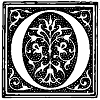
N a slight elevation in a western town across which the gusty wind was sweeping, sat a stolid, glum-looking Indian, slowly writing his autograph on slips of paper and handing them out to the amused persons in front of him. The thrifty red man charged a dollar and a half for each signature, and was doing a thriving business. Not the ghost of a smile lit up the wrinkled, iron countenance, though now and then he grunted, which might have meant pleasure over his profits, or possibly disgust that he had not charged a higher tariff. He never made any mistake against himself in changing the bills passed over to him.
A plump, military man of short, stocky build, in civilian suit, with big mustaches, and looking for fun in everything, bought one of his autographs. A glance at the round pleasing face showed that he was General Philip H. Sheridan, while the man standing on his left, with close-cropped sandy beard, and smoking a black cigar, was a still more famous American.
General Sheridan studied the awkward signature for a minute or two, and then turning to his friend at his elbow, who was doing the same with his autograph, said:
"Grant, I'll be hanged if the old fraud doesn't write a better hand than you."
General Grant turned his bit of paper over several times, held it away and then quite close to his face, as though interested only in the scrawl, then removed his cigar and with a shadowy smile, replied to his old comrade:
"I don't see that you've any cause for boasting, Sheridan."
The little group that were listening to the couple laughed, for Grant, Sherman and Sheridan never came together without chaffing one another. Besides the illustrious heroes named, there were Carl Schurz, W. M. Evarts, fully a score of United States Senators and Congressmen, and several British noblemen, as well as German professors, railway magnates and journalists.
This is a reproduction of one of the aboriginal autographs:

You will have no difficulty in reading the signature, which is that of a Sioux "medicine man," who, a few years ago was perhaps the most notable of his race. Sitting Bull was born in Dakota, in 1837. He inherited a deep hatred of the white people, and the tribe to which he belonged is to-day the most powerful on this continent. It can put five thousand bucks or more in the field, and every one of them would prove himself a sturdy fighter.
A bloody outbreak of the Sioux in Minnesota took place in the summer of 1862. We were in the throes of our Civil War at that time. The crimes of the Indians were of the most horrible nature, but the military force sent thither,[235] together with the volunteers steadily drove the hostiles to the wall and captured a large number. Thirty-seven of the leaders were tried by a military commission and found guilty of such fearful outrages that they were hanged.
Sitting Bull, the Sioux chief, was not frightened by this exhibition of a nation's anger.
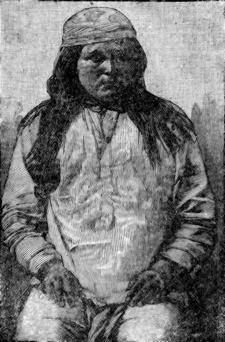
GENERAL CROOK'S APACHE GUIDE
He was then a young warrior, but he gathered about him a large number of Indians, who had been friendly to the whites. In 1874, they attacked the Crows and drove them from their reservation. Notice was sent to him by the Interior Department, to remove with his band by January 31, 1876. Sitting Bull paid no attention to the order, and the business was put in the hands of the War Department. General Crook destroyed the village of Crazy Horse in the following March, but the severity of the weather compelled a halt in military movements.
The discovery of gold in the Black Hills led to an invasion of the section by emigrants. The section belonged by treaty to the Sioux, and the authorities warned all white[236] people to keep away. No heed was given to the notice, and the enraged Sioux left their own reservation and began to plunder and massacre the people of Wyoming and Montana. Generals Terry and Cook, with a strong force of regulars moved into the region of the Upper Yellowstone, and drove Sitting Bull with several thousand hostiles toward the Big Horn Mountains and the river. Generals Custer and Reno with the Seventh Cavalry set out to locate the Indians. They found their camp, three miles in length, on the left bank of the Little Big Horn River. Custer sent Reno with three companies to attack the rear, and without waiting for support, charged the Sioux.
Not a soldier came out of the charge alive. Fifteen officers, including two brothers and a nephew of Custer, and two hundred and thirty-two men were overwhelmed and massacred by the hostiles. It was one of the most awful disasters in our frontier history, but the fault lay with the dashing, headlong Custer himself.
When news of the calamity reached Fort Leavenworth, General Nelson P. Miles was ordered to the scene with the Fifth Infantry. Certain that a large number of the Indians were not far off, General Miles moved down the left bank of the Yellowstone. On the way, he came upon the following note, fastened on a stick thrust into the ground, where it had been left by an Indian runner several days before:
"Yellowstone.
"I want to know what you are doing traveling on this road. You scare all the buffalo away. I want to hunt in this place. I want you to turn back from here. If you don't I will fight you again. I want you to leave what you have got here and turn back from here.
"I am your friend,
"Sitting Bull.
"I mean all the rations you have got and some powder. Wish you would write as soon as you can."
Instead of writing, as requested, General Miles started after Sitting Bull, and overtook him near one of the branches of the Yellowstone. The two leaders met under a flag of truce and the talk was sharp. Sitting Bull was not in chief command of the Sioux at the Custer massacre, but he was present and took part. The thought of accepting orders from this dusky miscreant was beyond bearing, and General Miles, notable for his self-restraint, said to the grim chieftain:
"I am going to drive you out or you are going to drive me out."
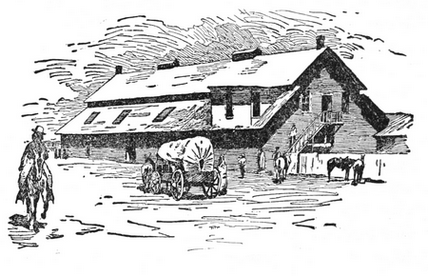
AN INDIAN AGENCY
Filled with rage, Sitting Bull strode back to his bucks, and, knowing that all negotiation was at an end, General Miles attacked him with such vigor that the Sioux were driven into wild flight, with the loss of a large number of warriors. General Miles, who had long before proved himself one of the finest of soldiers, pushed the pursuit so resolutely that the Sioux leaped from their ponies, and, leaving everything, scattered among the hills. General Miles was anxious to capture Sitting Bull, the chief marplot, and he pressed the pursuit for fifty miles, but the Sioux leader kept out of his way. It may as well be said at this point, that Sitting Bull proved that he was lacking in personal courage. He and several[238] other chiefs managed to break away from the main body and thus saved themselves.
Knowing the need of running down Sitting Bull, General Miles reorganized his forces in the camp on Tongue River, and again started in pursuit of the Sioux medicine man. A fall of snow hid the trail. The cold grew intense. General Miles kept his scouts busy, and early in January, the camp of the hostiles was located. It numbered about two hundred lodges, and was attacked with such spirit that the horde was driven headlong across the Missouri. Another assault a fortnight later resulted in the capture of most of the camp equipage of the Indians. Sitting Bull kept pushing northward until he believed he was beyond reach of the tireless Miles. This proved true for the time, for the snow was so deep that it was impossible for the cavalry to make headway; but when spring began melting the snow and ice, the chieftain knew he was liable to be pounced upon at any hour by the officers and men who would not be baffled. So he clinched his safety by crossing the line into Canada. So long as he stayed there, our troops could not disturb him. The fervent hope was that he would stay there, for if he returned to his own country, trouble was sure to follow. He knew better than to misbehave himself while in Canada, where the mounted police looked after the law-breakers.
You have read more than one account in the previous pages of great uprisings and conspiracies on the part of the Indians of our country. Some of them threatened large sections, and at times many cities and towns were imperilled by these plottings and border wars. It seems hard, therefore, to believe that the closing years of the nineteenth century saw the gravest danger of that nature through which we have ever passed. Yet such is the fact. An uprising might have been[239] started by the discharge of a single gun, or the rash act of one private soldier, and once kindled, it would have swept like a cyclone from Canada to Mexico, causing the deaths of thousands and the loss of millions of dollars worth of property.
It need not be repeated that the cause of this fearful state of affairs was the injustice of white men and the shameless treatment of the Indians by our government. It is not necessary to give particulars, but I will illustrate the fact by a single incident, which is a type of scores of others.
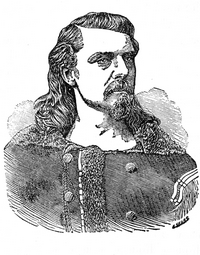
BUFFALO BILL
It once became certain that an agent at one of the Sioux agencies had swindled the Indians and our government to the extent of eighty thousand dollars. The offence was so flagrant that a committee was sent from Washington to look into the matter. A friend of the agent notified him of his danger. He bribed one of his interpreters to meet the committee at a point where they had to take a stage to ride to the agency. This cunning fellow did so without a hint of his purpose. It did not take him long to make friends with the visitors. They were pleased to learn that he was familiar with Indian affairs, and still more pleased to find that he could speak the Sioux tongue. They proposed that he should act as interpreter. He agreed, and the bargain was closed by the payment to him of fifty dollars. The man carried out his contract[240] with his dishonest employer. The Indians poured their grievance into his ears and he listened gravely, nodding his head as if in sympathy. Then turning to the waiting members of the committee, he changed those complaints into praise of the faithful labors of the thieving agent. He took care that his face did not betray the truth to either party. The committee, little dreaming of the trick, went back to Washington, wondering how the unjust reports had been spread concerning the model employé of the government.
The inhabitants of Dakota (not then divided into the two present States) wished to open a highway through the Sioux reservation, and have it settled by white men. The work would have been of advantage to the Indians themselves. It was not hard to make them see this fact, and they seemed willing to sell their lands. All they wanted was that they should not be cheated, and if they had not been cheated, they never would have raised a hand against the United States. Negotiations went on for several years, until at last a new Commission, of which General Crook was chairman, persuaded the Sioux to sign a treaty by which they gave up about 11,000,000 acres of their reservation, reducing it one-half.
The chiefs signed their names with misgiving. They had seen so much deception that they had grown suspicious, even though they were argued with by a leading military officer—a class who are always more honest than civilians.
We hear of the Messiah craze about this time. It was the strange belief that the Great Spirit was soon coming to destroy the white people, and to give back the lands they had stolen from the Indians. The faith spread like wildfire, and seemed to rob nearly all the Sioux tribe of their senses. The bucks quickly reached that state of frenzy in which they were eager to attack the whites.
To Sitting Bull this was the golden opportunity for which he had been waiting for years. He could turn the fanaticism of his people to his own account, and he determined to do so. He sent out his runners to the different branches of the Sioux. They made numerous converts everywhere. The heart of the old, brooding pagan must have glowed when he saw everything working out as he wished it to work. Very soon he would be able to launch his warriors against the settlements and agencies, and spread desolation and death among those whom he hated with unspeakable hatred.
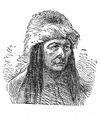
SITTING BULL
The camp of Sitting Bull was about forty miles southeast of the Pine Ridge Agency. In December, 1890, General Ruger telegraphed from St. Paul to Colonel Drum, commandant at Fort Yates, ordering him to arrest the chief. General Ruger wished to have the military and civil officers join in the act, but the agent believed less friction would follow if the matter was placed in the hands of the Indian police. These men, as the name shows are Indians. They are the sole agents of the Interior Department for the enforcement of its regulations, and for preserving the peace. They are taken from the best men, physically and mentally, and, though their pay is moderate, they have done fine service, and shown a bravery in many instances, which none of our own race could surpass.
The arrest of Sitting Bull was certain to cause excitement[242] among his people, and would perhaps be attended by violence. The plan was carefully guarded, and a time was selected, when most of the Indians would be at the agency drawing their rations. The delay would have been greater, had it not been learned that the chief was preparing to leave the reservation, and unless the authorities acted promptly, would soon be beyond reach.
Forty Indian police galloped toward the camp of the famous medicine man, followed at some distance by two troops of cavalry and a force of infantry. When within a few miles, these bodies united and halted. The plan was that the soldiers should station themselves some two miles from the camp, where they would be within call, should the police need their help. Then the Indian police rode forward at an easy pace.
When they reached his tent, Sitting Bull was in bed. He was roused and told that he was under arrest. He did not resist (you will remember he was lacking in personal courage) and would have submitted quietly but for his son, Crow Foot, a bright fellow of seventeen years. He was provoked by the meekness of his father. "You are very brave," he said, "when there is no danger, but when the police come you are a child."
Roused by the taunt, Sitting Bull began fighting, and called to his friends to come to his help. One of these caught up a gun and added his shouts. The next minute the battle was on, and raged viciously for some minutes. The hostiles were twice as numerous as the police, and though the latter fought heroically, they quickly found themselves in serious danger. Several were shot down, and the outlook was doubtful, when one of them galloped to the top of the nearest hill and signalled to the cavalry, who dashed forward on a dead[243] run. A few minutes later, they opened with their Hotchkiss and Gatling guns and dispersed the hostiles.
In this affray, five of the police were killed, including the lieutenant in command. Of the hostiles, seven were shot, besides Sitting Bull, who was slain by the lieutenant a moment before his own death. In addition to these, Crow Foot, the son of the chief, was drawn out from hiding and killed by the police who were enraged because of the losses they had suffered. This was apparently not justified even in war.
The days now came, when, as I have stated, a spark would have kindled the conflagration that would have raged from Canada to the Gulf; but General Miles took charge, just before the battle at Wounded Knee, and he acted with such admirable skill, that his success was perfect. The hostiles were coaxed to come forward and surrender, and this was done with such tact, that they soon showed signs of obeying. For days they edged up foot by foot. Sometimes the bucks revolted, for they were bent on war, and many a time it seemed that nothing less than a miracle could prevent a terrific outbreak. On the morning of January 15, the immense horde came in, gave up their guns, and made submission.
To show the strength of this body, it may be said that the procession was four miles long and very nearly six thousand Indians were in line. Actual count made the number of lodges seven hundred and thirty-two. Army officers believed the whole number was fully eleven thousand. One needs only to think of what such a host—larger than any had supposed—when reinforced by the thousands from other tribes, would have done if they had once taken the war path against the United States.
Our account of the great Indian uprising of 1890-91 would be incomplete without a few words concerning one of[244] the most prominent leaders of that revolt. He was Red Cloud, who became head chief of the entire Sioux tribe. Considerably older than Sitting Bull, he fiercely opposed every change in the customs of his people which the government agents tried to bring about. He was the leader in the councils, and, when the outbreak came, he caught up his Winchester and proved himself a force with which the military arm had to reckon. In December, 1866, he and two thousand Sioux ambushed Colonel Fetterman and ninety of his men near Fort Phil Kearney. He was deposed in 1876 by General Crook, who made Spotted Tail his successor. This chief was killed by Crow Dog, and the way thus opened for Sitting Bull.
When the storm-cloud passed, Red Cloud openly opposed the scheme of allotting lands to the Indians, and making the red men support themselves by farming and cattle raising. He lived for many years in a two-story frame dwelling, which the government built for him near the agency at Pine Ridge, but refused to take his allotment of land, insisting that our government owed the Sioux a living without compelling them to work. The proud old chief said he would starve before he would accept a piece of land and toil like a squaw. So bitter was his feeling against the white man that he would never learn a word of our language.
Transciber's Notes:
Variations in spelling, punctuation, and hyphenation have been retained; typographical errors have been silently corrected.
End of the Project Gutenberg EBook of Outdoor Life and Indian Stories, by
Edward Sylvester Ellis
*** END OF THIS PROJECT GUTENBERG EBOOK OUTDOOR LIFE AND INDIAN STORIES ***
***** This file should be named 59002-h.htm or 59002-h.zip *****
This and all associated files of various formats will be found in:
http://www.gutenberg.org/5/9/0/0/59002/
Produced by Greg Weeks, Jana Palkova and the Online
Distributed Proofreading Team at http://www.pgdp.net
Updated editions will replace the previous one--the old editions will
be renamed.
Creating the works from print editions not protected by U.S. copyright
law means that no one owns a United States copyright in these works,
so the Foundation (and you!) can copy and distribute it in the United
States without permission and without paying copyright
royalties. Special rules, set forth in the General Terms of Use part
of this license, apply to copying and distributing Project
Gutenberg-tm electronic works to protect the PROJECT GUTENBERG-tm
concept and trademark. Project Gutenberg is a registered trademark,
and may not be used if you charge for the eBooks, unless you receive
specific permission. If you do not charge anything for copies of this
eBook, complying with the rules is very easy. You may use this eBook
for nearly any purpose such as creation of derivative works, reports,
performances and research. They may be modified and printed and given
away--you may do practically ANYTHING in the United States with eBooks
not protected by U.S. copyright law. Redistribution is subject to the
trademark license, especially commercial redistribution.
START: FULL LICENSE
THE FULL PROJECT GUTENBERG LICENSE
PLEASE READ THIS BEFORE YOU DISTRIBUTE OR USE THIS WORK
To protect the Project Gutenberg-tm mission of promoting the free
distribution of electronic works, by using or distributing this work
(or any other work associated in any way with the phrase "Project
Gutenberg"), you agree to comply with all the terms of the Full
Project Gutenberg-tm License available with this file or online at
www.gutenberg.org/license.
Section 1. General Terms of Use and Redistributing Project
Gutenberg-tm electronic works
1.A. By reading or using any part of this Project Gutenberg-tm
electronic work, you indicate that you have read, understand, agree to
and accept all the terms of this license and intellectual property
(trademark/copyright) agreement. If you do not agree to abide by all
the terms of this agreement, you must cease using and return or
destroy all copies of Project Gutenberg-tm electronic works in your
possession. If you paid a fee for obtaining a copy of or access to a
Project Gutenberg-tm electronic work and you do not agree to be bound
by the terms of this agreement, you may obtain a refund from the
person or entity to whom you paid the fee as set forth in paragraph
1.E.8.
1.B. "Project Gutenberg" is a registered trademark. It may only be
used on or associated in any way with an electronic work by people who
agree to be bound by the terms of this agreement. There are a few
things that you can do with most Project Gutenberg-tm electronic works
even without complying with the full terms of this agreement. See
paragraph 1.C below. There are a lot of things you can do with Project
Gutenberg-tm electronic works if you follow the terms of this
agreement and help preserve free future access to Project Gutenberg-tm
electronic works. See paragraph 1.E below.
1.C. The Project Gutenberg Literary Archive Foundation ("the
Foundation" or PGLAF), owns a compilation copyright in the collection
of Project Gutenberg-tm electronic works. Nearly all the individual
works in the collection are in the public domain in the United
States. If an individual work is unprotected by copyright law in the
United States and you are located in the United States, we do not
claim a right to prevent you from copying, distributing, performing,
displaying or creating derivative works based on the work as long as
all references to Project Gutenberg are removed. Of course, we hope
that you will support the Project Gutenberg-tm mission of promoting
free access to electronic works by freely sharing Project Gutenberg-tm
works in compliance with the terms of this agreement for keeping the
Project Gutenberg-tm name associated with the work. You can easily
comply with the terms of this agreement by keeping this work in the
same format with its attached full Project Gutenberg-tm License when
you share it without charge with others.
1.D. The copyright laws of the place where you are located also govern
what you can do with this work. Copyright laws in most countries are
in a constant state of change. If you are outside the United States,
check the laws of your country in addition to the terms of this
agreement before downloading, copying, displaying, performing,
distributing or creating derivative works based on this work or any
other Project Gutenberg-tm work. The Foundation makes no
representations concerning the copyright status of any work in any
country outside the United States.
1.E. Unless you have removed all references to Project Gutenberg:
1.E.1. The following sentence, with active links to, or other
immediate access to, the full Project Gutenberg-tm License must appear
prominently whenever any copy of a Project Gutenberg-tm work (any work
on which the phrase "Project Gutenberg" appears, or with which the
phrase "Project Gutenberg" is associated) is accessed, displayed,
performed, viewed, copied or distributed:
This eBook is for the use of anyone anywhere in the United States and
most other parts of the world at no cost and with almost no
restrictions whatsoever. You may copy it, give it away or re-use it
under the terms of the Project Gutenberg License included with this
eBook or online at www.gutenberg.org. If you are not located in the
United States, you'll have to check the laws of the country where you
are located before using this ebook.
1.E.2. If an individual Project Gutenberg-tm electronic work is
derived from texts not protected by U.S. copyright law (does not
contain a notice indicating that it is posted with permission of the
copyright holder), the work can be copied and distributed to anyone in
the United States without paying any fees or charges. If you are
redistributing or providing access to a work with the phrase "Project
Gutenberg" associated with or appearing on the work, you must comply
either with the requirements of paragraphs 1.E.1 through 1.E.7 or
obtain permission for the use of the work and the Project Gutenberg-tm
trademark as set forth in paragraphs 1.E.8 or 1.E.9.
1.E.3. If an individual Project Gutenberg-tm electronic work is posted
with the permission of the copyright holder, your use and distribution
must comply with both paragraphs 1.E.1 through 1.E.7 and any
additional terms imposed by the copyright holder. Additional terms
will be linked to the Project Gutenberg-tm License for all works
posted with the permission of the copyright holder found at the
beginning of this work.
1.E.4. Do not unlink or detach or remove the full Project Gutenberg-tm
License terms from this work, or any files containing a part of this
work or any other work associated with Project Gutenberg-tm.
1.E.5. Do not copy, display, perform, distribute or redistribute this
electronic work, or any part of this electronic work, without
prominently displaying the sentence set forth in paragraph 1.E.1 with
active links or immediate access to the full terms of the Project
Gutenberg-tm License.
1.E.6. You may convert to and distribute this work in any binary,
compressed, marked up, nonproprietary or proprietary form, including
any word processing or hypertext form. However, if you provide access
to or distribute copies of a Project Gutenberg-tm work in a format
other than "Plain Vanilla ASCII" or other format used in the official
version posted on the official Project Gutenberg-tm web site
(www.gutenberg.org), you must, at no additional cost, fee or expense
to the user, provide a copy, a means of exporting a copy, or a means
of obtaining a copy upon request, of the work in its original "Plain
Vanilla ASCII" or other form. Any alternate format must include the
full Project Gutenberg-tm License as specified in paragraph 1.E.1.
1.E.7. Do not charge a fee for access to, viewing, displaying,
performing, copying or distributing any Project Gutenberg-tm works
unless you comply with paragraph 1.E.8 or 1.E.9.
1.E.8. You may charge a reasonable fee for copies of or providing
access to or distributing Project Gutenberg-tm electronic works
provided that
* You pay a royalty fee of 20% of the gross profits you derive from
the use of Project Gutenberg-tm works calculated using the method
you already use to calculate your applicable taxes. The fee is owed
to the owner of the Project Gutenberg-tm trademark, but he has
agreed to donate royalties under this paragraph to the Project
Gutenberg Literary Archive Foundation. Royalty payments must be paid
within 60 days following each date on which you prepare (or are
legally required to prepare) your periodic tax returns. Royalty
payments should be clearly marked as such and sent to the Project
Gutenberg Literary Archive Foundation at the address specified in
Section 4, "Information about donations to the Project Gutenberg
Literary Archive Foundation."
* You provide a full refund of any money paid by a user who notifies
you in writing (or by e-mail) within 30 days of receipt that s/he
does not agree to the terms of the full Project Gutenberg-tm
License. You must require such a user to return or destroy all
copies of the works possessed in a physical medium and discontinue
all use of and all access to other copies of Project Gutenberg-tm
works.
* You provide, in accordance with paragraph 1.F.3, a full refund of
any money paid for a work or a replacement copy, if a defect in the
electronic work is discovered and reported to you within 90 days of
receipt of the work.
* You comply with all other terms of this agreement for free
distribution of Project Gutenberg-tm works.
1.E.9. If you wish to charge a fee or distribute a Project
Gutenberg-tm electronic work or group of works on different terms than
are set forth in this agreement, you must obtain permission in writing
from both the Project Gutenberg Literary Archive Foundation and The
Project Gutenberg Trademark LLC, the owner of the Project Gutenberg-tm
trademark. Contact the Foundation as set forth in Section 3 below.
1.F.
1.F.1. Project Gutenberg volunteers and employees expend considerable
effort to identify, do copyright research on, transcribe and proofread
works not protected by U.S. copyright law in creating the Project
Gutenberg-tm collection. Despite these efforts, Project Gutenberg-tm
electronic works, and the medium on which they may be stored, may
contain "Defects," such as, but not limited to, incomplete, inaccurate
or corrupt data, transcription errors, a copyright or other
intellectual property infringement, a defective or damaged disk or
other medium, a computer virus, or computer codes that damage or
cannot be read by your equipment.
1.F.2. LIMITED WARRANTY, DISCLAIMER OF DAMAGES - Except for the "Right
of Replacement or Refund" described in paragraph 1.F.3, the Project
Gutenberg Literary Archive Foundation, the owner of the Project
Gutenberg-tm trademark, and any other party distributing a Project
Gutenberg-tm electronic work under this agreement, disclaim all
liability to you for damages, costs and expenses, including legal
fees. YOU AGREE THAT YOU HAVE NO REMEDIES FOR NEGLIGENCE, STRICT
LIABILITY, BREACH OF WARRANTY OR BREACH OF CONTRACT EXCEPT THOSE
PROVIDED IN PARAGRAPH 1.F.3. YOU AGREE THAT THE FOUNDATION, THE
TRADEMARK OWNER, AND ANY DISTRIBUTOR UNDER THIS AGREEMENT WILL NOT BE
LIABLE TO YOU FOR ACTUAL, DIRECT, INDIRECT, CONSEQUENTIAL, PUNITIVE OR
INCIDENTAL DAMAGES EVEN IF YOU GIVE NOTICE OF THE POSSIBILITY OF SUCH
DAMAGE.
1.F.3. LIMITED RIGHT OF REPLACEMENT OR REFUND - If you discover a
defect in this electronic work within 90 days of receiving it, you can
receive a refund of the money (if any) you paid for it by sending a
written explanation to the person you received the work from. If you
received the work on a physical medium, you must return the medium
with your written explanation. The person or entity that provided you
with the defective work may elect to provide a replacement copy in
lieu of a refund. If you received the work electronically, the person
or entity providing it to you may choose to give you a second
opportunity to receive the work electronically in lieu of a refund. If
the second copy is also defective, you may demand a refund in writing
without further opportunities to fix the problem.
1.F.4. Except for the limited right of replacement or refund set forth
in paragraph 1.F.3, this work is provided to you 'AS-IS', WITH NO
OTHER WARRANTIES OF ANY KIND, EXPRESS OR IMPLIED, INCLUDING BUT NOT
LIMITED TO WARRANTIES OF MERCHANTABILITY OR FITNESS FOR ANY PURPOSE.
1.F.5. Some states do not allow disclaimers of certain implied
warranties or the exclusion or limitation of certain types of
damages. If any disclaimer or limitation set forth in this agreement
violates the law of the state applicable to this agreement, the
agreement shall be interpreted to make the maximum disclaimer or
limitation permitted by the applicable state law. The invalidity or
unenforceability of any provision of this agreement shall not void the
remaining provisions.
1.F.6. INDEMNITY - You agree to indemnify and hold the Foundation, the
trademark owner, any agent or employee of the Foundation, anyone
providing copies of Project Gutenberg-tm electronic works in
accordance with this agreement, and any volunteers associated with the
production, promotion and distribution of Project Gutenberg-tm
electronic works, harmless from all liability, costs and expenses,
including legal fees, that arise directly or indirectly from any of
the following which you do or cause to occur: (a) distribution of this
or any Project Gutenberg-tm work, (b) alteration, modification, or
additions or deletions to any Project Gutenberg-tm work, and (c) any
Defect you cause.
Section 2. Information about the Mission of Project Gutenberg-tm
Project Gutenberg-tm is synonymous with the free distribution of
electronic works in formats readable by the widest variety of
computers including obsolete, old, middle-aged and new computers. It
exists because of the efforts of hundreds of volunteers and donations
from people in all walks of life.
Volunteers and financial support to provide volunteers with the
assistance they need are critical to reaching Project Gutenberg-tm's
goals and ensuring that the Project Gutenberg-tm collection will
remain freely available for generations to come. In 2001, the Project
Gutenberg Literary Archive Foundation was created to provide a secure
and permanent future for Project Gutenberg-tm and future
generations. To learn more about the Project Gutenberg Literary
Archive Foundation and how your efforts and donations can help, see
Sections 3 and 4 and the Foundation information page at
www.gutenberg.org Section 3. Information about the Project Gutenberg
Literary Archive Foundation
The Project Gutenberg Literary Archive Foundation is a non profit
501(c)(3) educational corporation organized under the laws of the
state of Mississippi and granted tax exempt status by the Internal
Revenue Service. The Foundation's EIN or federal tax identification
number is 64-6221541. Contributions to the Project Gutenberg Literary
Archive Foundation are tax deductible to the full extent permitted by
U.S. federal laws and your state's laws.
The Foundation's principal office is in Fairbanks, Alaska, with the
mailing address: PO Box 750175, Fairbanks, AK 99775, but its
volunteers and employees are scattered throughout numerous
locations. Its business office is located at 809 North 1500 West, Salt
Lake City, UT 84116, (801) 596-1887. Email contact links and up to
date contact information can be found at the Foundation's web site and
official page at www.gutenberg.org/contact
For additional contact information:
Dr. Gregory B. Newby
Chief Executive and Director
gbnewby@pglaf.org
Section 4. Information about Donations to the Project Gutenberg
Literary Archive Foundation
Project Gutenberg-tm depends upon and cannot survive without wide
spread public support and donations to carry out its mission of
increasing the number of public domain and licensed works that can be
freely distributed in machine readable form accessible by the widest
array of equipment including outdated equipment. Many small donations
($1 to $5,000) are particularly important to maintaining tax exempt
status with the IRS.
The Foundation is committed to complying with the laws regulating
charities and charitable donations in all 50 states of the United
States. Compliance requirements are not uniform and it takes a
considerable effort, much paperwork and many fees to meet and keep up
with these requirements. We do not solicit donations in locations
where we have not received written confirmation of compliance. To SEND
DONATIONS or determine the status of compliance for any particular
state visit www.gutenberg.org/donate
While we cannot and do not solicit contributions from states where we
have not met the solicitation requirements, we know of no prohibition
against accepting unsolicited donations from donors in such states who
approach us with offers to donate.
International donations are gratefully accepted, but we cannot make
any statements concerning tax treatment of donations received from
outside the United States. U.S. laws alone swamp our small staff.
Please check the Project Gutenberg Web pages for current donation
methods and addresses. Donations are accepted in a number of other
ways including checks, online payments and credit card donations. To
donate, please visit: www.gutenberg.org/donate
Section 5. General Information About Project Gutenberg-tm electronic works.
Professor Michael S. Hart was the originator of the Project
Gutenberg-tm concept of a library of electronic works that could be
freely shared with anyone. For forty years, he produced and
distributed Project Gutenberg-tm eBooks with only a loose network of
volunteer support.
Project Gutenberg-tm eBooks are often created from several printed
editions, all of which are confirmed as not protected by copyright in
the U.S. unless a copyright notice is included. Thus, we do not
necessarily keep eBooks in compliance with any particular paper
edition.
Most people start at our Web site which has the main PG search
facility: www.gutenberg.org
This Web site includes information about Project Gutenberg-tm,
including how to make donations to the Project Gutenberg Literary
Archive Foundation, how to help produce our new eBooks, and how to
subscribe to our email newsletter to hear about new eBooks.